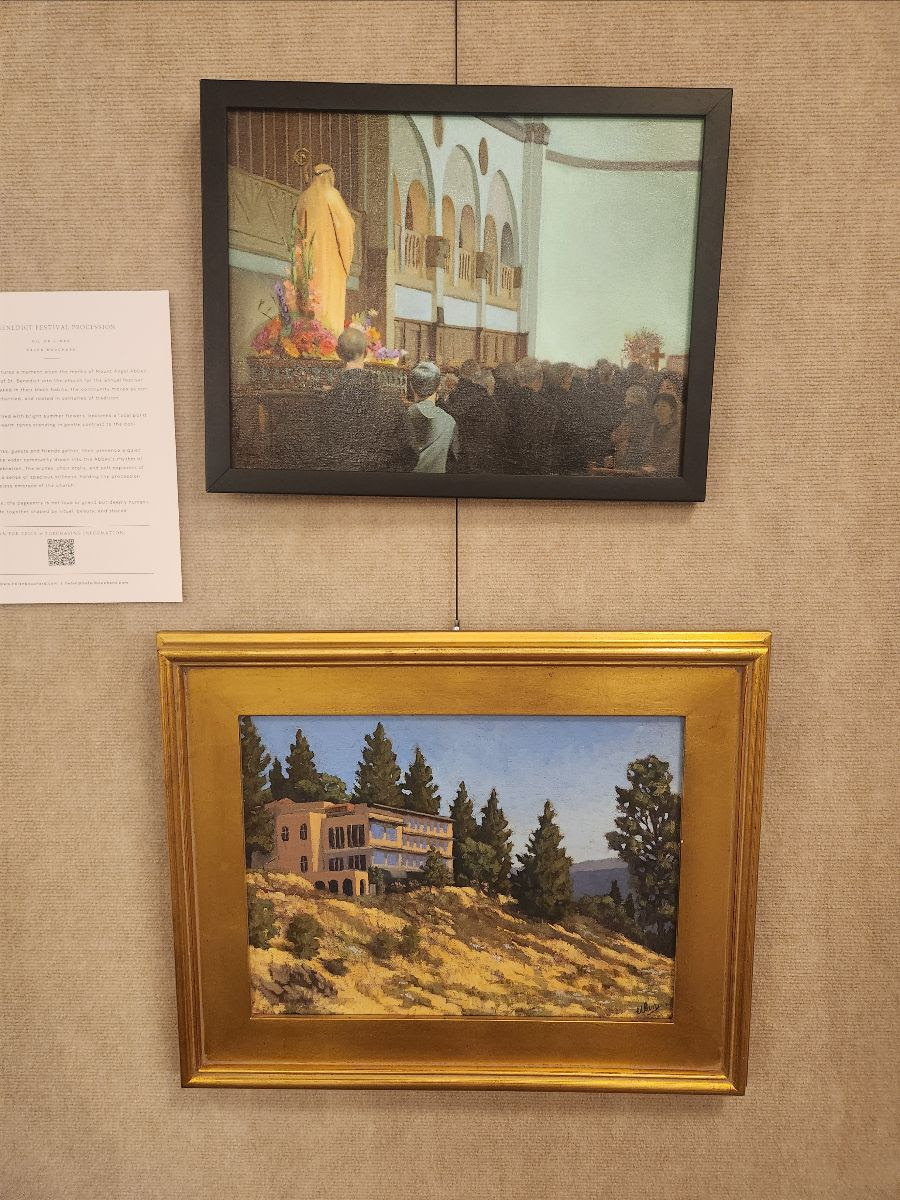Notes to Oblates of Mount Angel Abbey
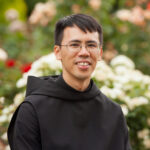 Fr. John Paul Le, OSB, director of the oblates of Mount Angel Abbey, writes frequent notes to the oblates of Mount Angel Abbey. The oblates are a vibrant and active community of lay people and priests who strive to live the Holy Rule of St. Benedict in the spirit of Mount Angel Abbey, as far as their state in life permits. The notes are a mix of spiritual reflection, instruction, and updates on current events within the community of monks and oblates.
Fr. John Paul Le, OSB, director of the oblates of Mount Angel Abbey, writes frequent notes to the oblates of Mount Angel Abbey. The oblates are a vibrant and active community of lay people and priests who strive to live the Holy Rule of St. Benedict in the spirit of Mount Angel Abbey, as far as their state in life permits. The notes are a mix of spiritual reflection, instruction, and updates on current events within the community of monks and oblates.
A Note to Our Dear Oblates
December 12, 2025
Dear Oblates,
The Third Sunday of Advent
Br. Thomas has shared the following reflection.
“Rejoice in the Lord always,” says St. Paul! This third Sunday of Advent, Gaudete Sunday, begins with this excerpt from his letter to the Philippians. “Indeed, the Lord is near,” he adds. The nearness of the Christmas feast is hard not to notice: stores started playing Christmas music before Thanksgiving this year, many houses and shops are already lit up, and I even heard reports of a crew of Santas floating down the McKenzie River recently. Still, to me the words always come as a refreshing reminder: “again I say, rejoice.” The words strike me as Good News, because they remind me that joy is a different thing from the emotions of happiness or excitement; it is more like a choice. Emotions come and go with circumstances, but the traditional four divine gifts of Advent (peace, hope, joy, and love) are attitudes that endure and shape us. When we think about him who made the stars becoming one of us, being with us throughout life, and returning in glory forever, we have a reason for joy no matter what.
We’re not quite there yet, though! St. Paul still needs to command us to rejoice. Advent, like Lent, is a season to reflect on our need for God. There’s much in our world, our society, and in ourselves that is profoundly disordered. It’s really always been that way: St. John the Baptist looms large in the Advent liturgies, “preparing the way of the Lord” for the last 2000 years by reminding us of the need for self-examination, repentance, and active waiting for “the one who is to come.” But he has come. This Sunday’s psalm tells us that God saves the oppressed, the hungry, the captives, the blind, the stranger, the fatherless and the widow. And that is exactly what Jesus did and has kept on doing. Our Holy Father Pope Leo reminds us, “God is not outside the world, outside this life: we have learned from the first coming of Jesus, God-with-us, to seek him in the realities of life.” Advent would not exist without Christmas, nor Lent without Easter. So, “go and tell John what you hear and see:” Gaudete Sunday, with its rose vestments and candle, its buoyant music, its lyrical poetry, and the people of God gathered around the Most Holy Eucharist, tells us that whatever lonely, hot mess we may find ourselves in, the Lord is eager to come and be our honored guest.
Our next Oblate Sunday is December 14th with Br. Thomas giving the third of his four talks on the psalms. For in-person, click here; for remote option, click here. The Oblate Sunday begins with Mass at the Abbey at 9am. It is followed by a potluck brunch after Mass in the guesthouse dining room. The conference starts at 11am in the Westminster Room.
Prayer request. Please pray for the seminarians who are traveling home for their break. Please know that you can always send your prayer requests through our Oremus program.
Yours in Christ,
Fr. John Paul, OSB
Director of Oblates
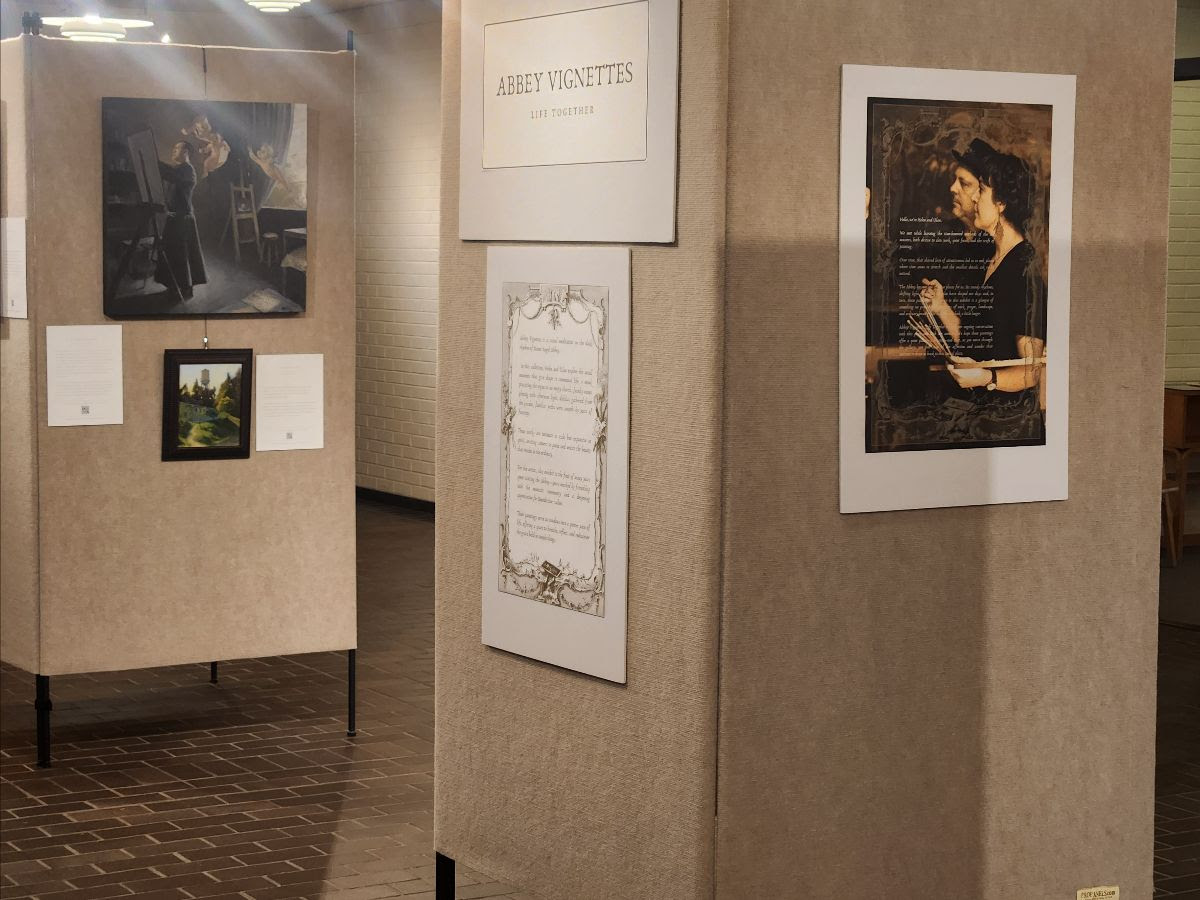
The library is currently displaying an artwork exhibit by Helen Bouchard and Ulan Moore titled, Abbey Vignettes: Life Together. This collection is a visual meditation on the daily rhythm of Mount Angel Abbey, it explores the small but moments that give shape to communal life. More about this collection and purchasing information can be found on Helen’s webpage.
Oblate Calendar
2025
December
14 – Oblate Sunday: Br. Thomas. The Psalms, Part III
2026
Jan
11 – Oblate Sunday: Br. Thomas. The Psalms, Part IV.
15 – Feast of St. Maurus and Placid (plenary indulgence may be obtained by oblates)
Feb
6-8 – Oblate Retreat. Br. Louis. Lectio Divina on the Prodigal Son.
8 – Oblate Sunday
10 – St. Scholastica (plenary indulgence may be obtained by oblates)
18 – Ash Wednesday
March
8 – Oblate Sunday
9 – St. Frances of Rome (plenary indulgence may be obtained by oblates)
21 – Passing of St. Benedict (plenary indulgence may be obtained by oblates)
31 – Easter Sunday
April
12 – Oblate Sunday
May
15-17 – Oblate Retreat. Fr. Anselm. On the Most Holy Rosary.
June
14 – Oblate Sunday
18-21 – Oblate Study Days
21 – Oblate Picnic
July
11 – St. Benedict Festival
11 – Solemnity of St. Benedict (plenary indulgence may be obtained by oblates)
Aug
9 – Oblate Sunday –
Sept
13 – Oblate Sunday –
18-20 – Oblate Retreat. Fr. Ephrem.
29 – Solemnity of Archangels (plenary indulgence may be obtained by oblates)
Oct
Nov
6-8 – Oblate Retreat. Fr. Michael
8 – Oblate Sunday
Dec
8 – Immaculate Conception (plenary indulgence may be obtained by oblates)
13 – Oblate Sunday
-
A Note to Our Dear Oblates - December 5, 2025
A Note to Our Dear Oblates
December 5, 2025Dear Oblates,
The Second Sunday of Advent
Some years ago, the monks read the book Unlikely Friendships by Jennifer Holland. The book details 47 remarkable stories of animals of different species forming the strongest of bonds. One of these stories was about an elephant named Themba and a sheep named Albert. When Themba the elephant was just six months old, his mother died by falling down a cliff. The staff placed him initially with a herd of elephants in the South African nature reserve, where they hoped that the herd would adopt him. However, to the staff’s dismay, it did not work out. Therefore, they went with plan B, and paired the elephant with Albert the sheep. At their first meeting, Themba the elephant charged at the sheep, and forced him into an enclosure, where the sheep stayed for 12 whole hours. Definitely, not love at first sight. However, overtime, Themba the elephant became curious about this odd looking creature called a sheep. He would put his trunk on her wool and sniff her out. Afterwards, the two started examining the enclosure together. After some time, the two were inseparable and were found foraging for food, napping and playing together. Indeed, the strong bond formed by these two vastly different creatures was a very unlikely friendship.
This echoes the first reading about the wolf being the guest of the lamb, and the leopard lying down with the kid, and the calf and the young lion browsing together. These creatures are naturally enemies of one another. How is it possible that they now live in harmony? And if they are living in harmony, can we who are of the same species not live in peace with one another despite our differences? I think this was the implied message the book was intended to provoke. This is an important message. How do we simply get along with and live at peace with those who differ from us?
However, instead of elaborating on forming unlikely friendships with those we differ with, I would like to talk about an even more unlikely friendship, the friendship between our loving God and us. Even more different than a sheep from an elephant is God in comparison with us. Yes, an elephant is greater than a sheep, but how much greater is God than we. How much stronger, wiser, kinder and more lovely than we. Yet, despite the infinite gulf that separates us from God, he has come down to us. God the Son, perfectly blessed and happy in himself has joined the human race and became one of us. Surprisingly, he does not take us as slaves or even servants but has called us friends, for he has made known to us everything that he has heard from the Father. See what great love God has bestowed upon us. This is what we are celebrating during this Advent season. The coming of the Son of God to be our friend. Now that is a very unlikely friendship, and like the sheep and the elephant started imitating one another, through our friendship with God, we become more like him.
Our next Oblate Sunday is December 14th with Br. Thomas giving the third of his four talks on the psalms. For in-person, click here; for remote option, click here. The Oblate Sunday begins with Mass at the Abbey at 9am. It is followed by a potluck brunch after Mass in the guesthouse dining room. The conference starts at 11am in the Westminster Room.Prayer request. Please pray for Fr. Anselm, Br. Louis and I as we give Advent Parish Missions this week and for the seminarians who will be taking their finals next week. Please know that you can always send your prayer requests through our Oremus program.
Yours in Christ,
Fr. John Paul, OSB
Director of Oblates
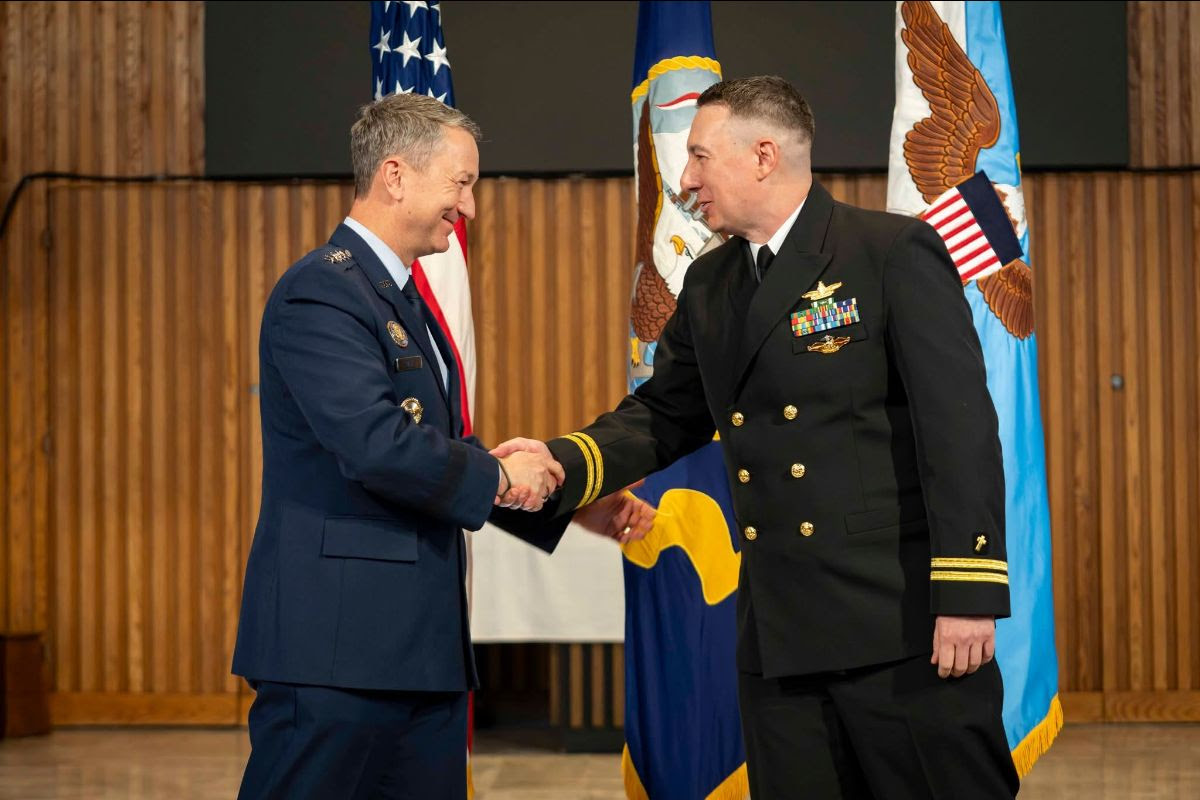
Fr. Basil at his promotion ceremony as Navy chaplain. He was promoted by General Dan Caine, Chariman of the Joint Chiefs of Staff and pinned by his father and CAPT Matt Thomas.
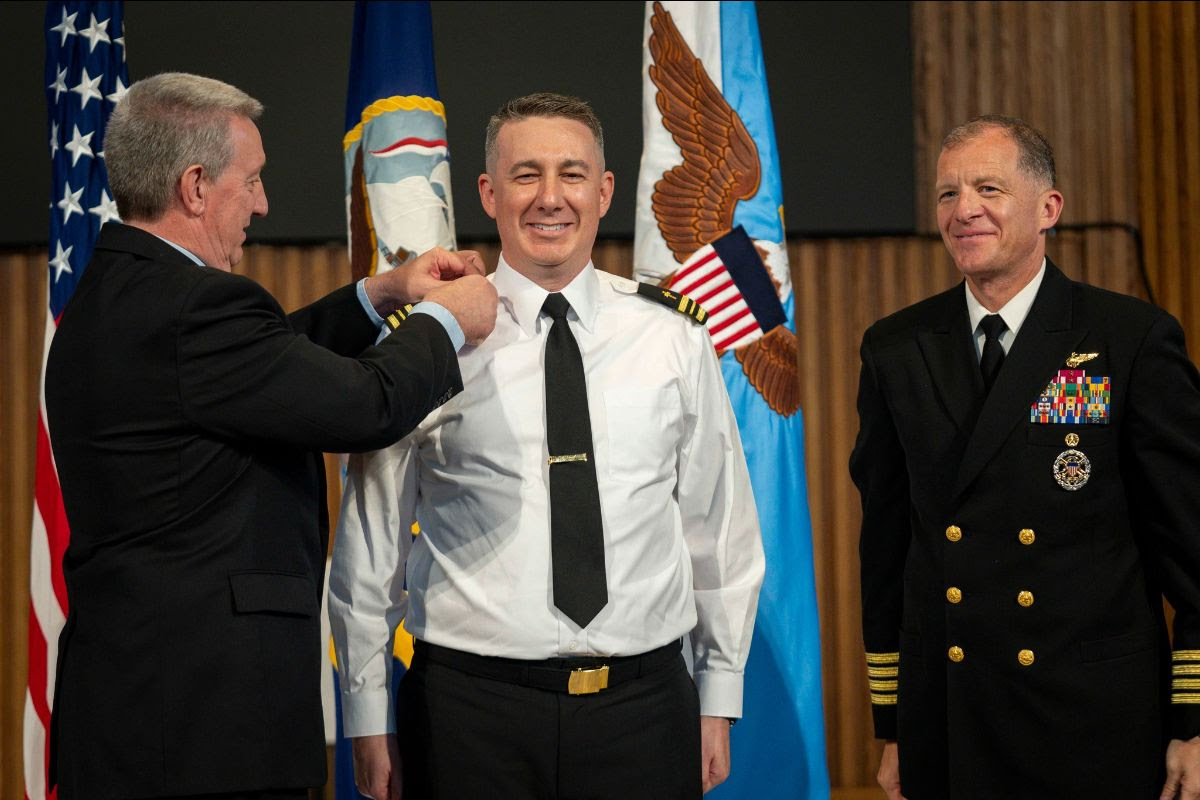
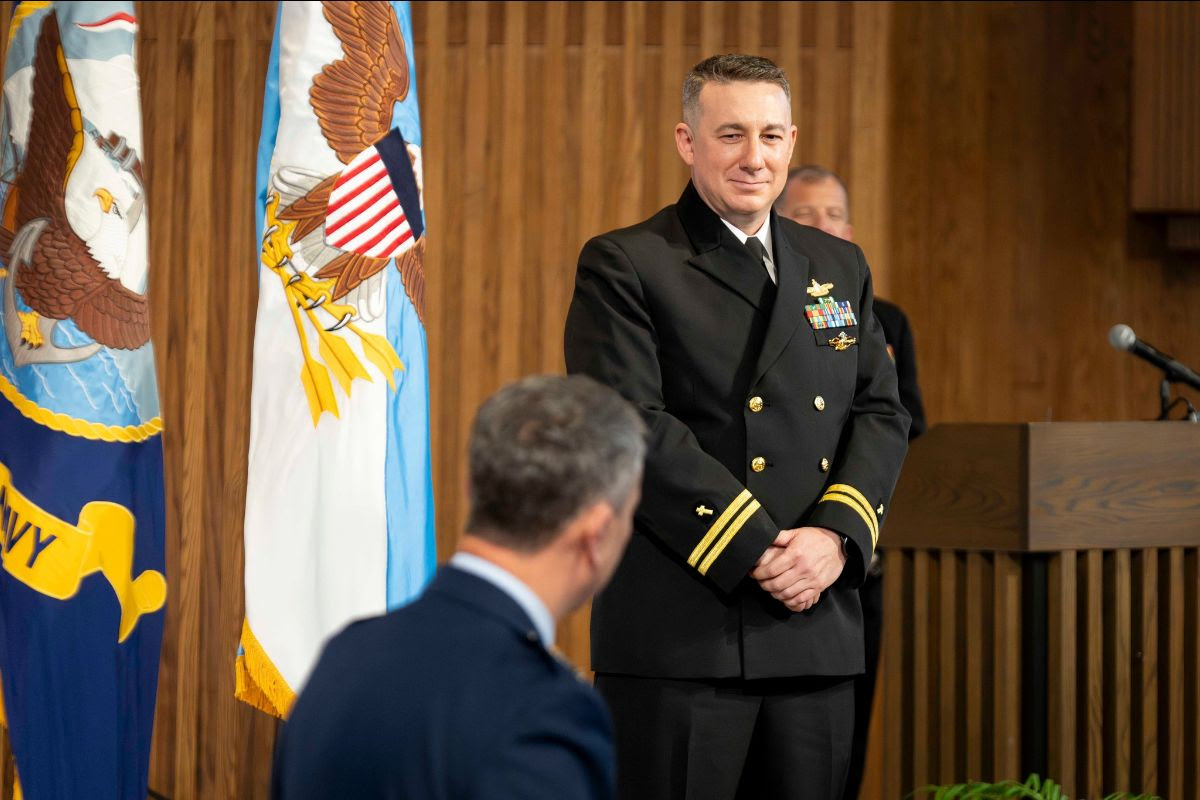
Oblate Calendar
2025
December
8 – Solemnity of the Immaculate Conception (plenary indulgence may be obtained by oblates)
14 – Oblate Sunday: Br. Thomas. The Psalms, Part III2026
Jan
11 – Oblate Sunday: Br. Thomas. The Psalms, Part IV.
15 – Feast of St. Maurus and Placid (plenary indulgence may be obtained by oblates)
Feb
6-8 – Oblate Retreat. Br. Louis. Lectio Divina on the Prodigal Son.
8 – Oblate Sunday
10 – St. Scholastica (plenary indulgence may be obtained by oblates)
18 – Ash Wednesday
March
8 – Oblate Sunday
9 – St. Frances of Rome (plenary indulgence may be obtained by oblates)
21 – Passing of St. Benedict (plenary indulgence may be obtained by oblates)
31 – Easter Sunday
April
12 – Oblate Sunday
May
15-17 – Oblate Retreat. Fr. Anselm. On the Most Holy Rosary.
June
14 – Oblate Sunday
18-21 – Oblate Study Days
21 – Oblate Picnic
July
11 – St. Benedict Festival
11 – Solemnity of St. Benedict (plenary indulgence may be obtained by oblates)
Aug
9 – Oblate Sunday –
Sept
13 – Oblate Sunday –
18-20 – Oblate Retreat. Fr. Ephrem.
29 – Solemnity of Archangels (plenary indulgence may be obtained by oblates)
Oct
Nov
6-8 – Oblate Retreat. Fr. Michael
8 – Oblate Sunday
Dec
8 – Immaculate Conception (plenary indulgence may be obtained by oblates)
13 – Oblate Sunday-
A Note to Our Dear Oblates - November 28, 2025
A Note to Our Dear Oblates
November 28, 2025Dear Oblates,
The First Sunday of Advent
I hope you all had a blessed and lovely Thanksgiving day. “Give thanks to the Lord for He is good; His mercy endures forever.”
Some of this week’s note is taken from the Vatican’s Homiletic Directory (78-82). The document basically tells us what the priest should be preaching about in the Sunday homily. The first Sunday of Advent focuses our attention not on Christ’s first coming as a gentle, vulnerable little baby, but as a righteous judge who will come to judge the living and the dead. In doing so the liturgy draws our thoughts to the powerful role this newborn child will play at the end times, and because of this, the readings on the first Sunday of Advent call us to be vigilant and stay alert. We do not know when the Lord will come again. This is perhaps quite fitting as we have just finished the Thanksgiving holiday, where we have eaten ourselves into a food-induced coma and are struggling to overcome physical as well as spiritual drowsiness. Also, we are often prompted to think about Christmas shopping, Christmas decorating and Christmas parties. All of these are reasonable and necessary, but the attention we give to these worldly activities can easily distract us from the vigilance that marks the season of Advent. The Son of Man is coming; the heavens will be shaken; a great spiritual awakening is poised to commence. Let us not be found wanting; let us not be found spiritually asleep.
What can we do to help make Advent more like Advent? For the Benedictine, the answer is quite simple, follow the liturgy by attending Mass, praying the Hours and doing lectio divina.
– For those of you who are too busy to pray all of Lauds or Vespers, try singing the beautiful Advent hymns the monks pray for these hours.
– Also, praying Vigils is particularly appropriate during this Advent season, for we are in a season of vigilance.
– For your lectio, you can download an Advent lectio calendar and write a word or each phrase each day that strikes you.
– Another practice can be that of allowing the physical darkness of the season to settle upon your life a bit more fully. When you pray at night, light a candle or two instead of blasting on all the lights.
– You can also go outside–if it is not raining–look at the stars and sing the great Advent Hymn, “Creator of the stars of night.”
– Listen to wonderful Advent Hymns such as those by the Benedictines of Mary.
– If you are looking for suggestions for Advent reading, here are two: John Henry Newman’s Waiting for Christ or Thomas a Kempis’ Imitation of Mary.Our next Oblate Sunday is December 14th with Br. Thomas giving the third of his four talks on the psalms. For in-person, click here; for remote option, click here. The Oblate Sunday begins with Mass at the Abbey at 9am. It is followed by a potluck brunch after Mass in the guesthouse dining room. The conference starts at 11am in the Westminster Room.
Prayer request. Please pray for the eternal rest of Don Caldwell, Fr. Teresio’s father, and Mary Cerda, Br. Ignatius’ mother. Please also pray for the artists, who are painting vignettes of the Abbey, which will be on display in the library from December 1 to January 8. Please know that you can always send your prayer requests through our Oremus program.Yours in Christ,
Fr. John Paul, OSB
Director of Oblates

Music of Baroque Concert
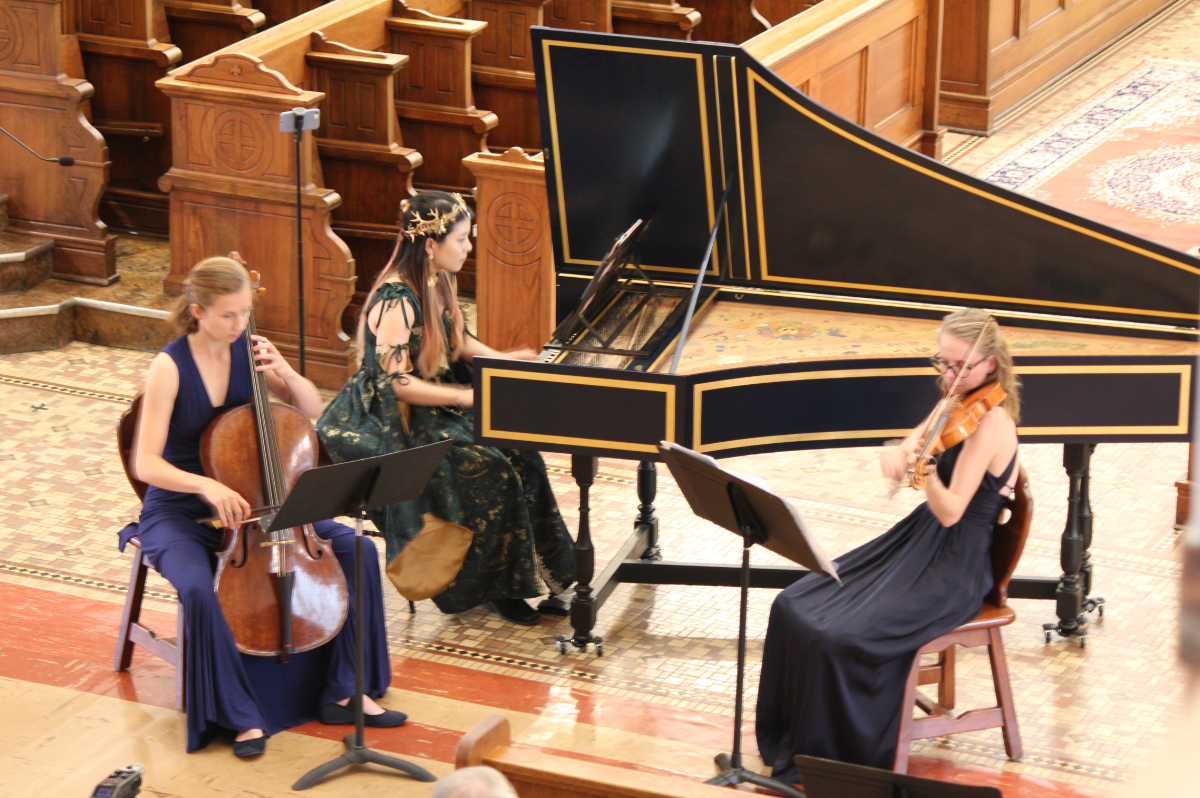
Music of Baroque Concert
Oblate Calendar
2025
December
8 – Solemnity of the Immaculate Conception (plenary indulgence may be obtained by oblates)
14 – Oblate Sunday: Br. Thomas. The Psalms, Part III2026
Jan
11 – Oblate Sunday: Br. Thomas. The Psalms, Part IV.
15 – Feast of St. Maurus and Placid (plenary indulgence may be obtained by oblates)
Feb
6-8 – Oblate Retreat. Br. Louis. Lectio Divina on the Prodigal Son.
8 – Oblate Sunday
10 – St. Scholastica (plenary indulgence may be obtained by oblates)
18 – Ash Wednesday
March
8 – Oblate Sunday
9 – St. Frances of Rome (plenary indulgence may be obtained by oblates)
21 – Passing of St. Benedict (plenary indulgence may be obtained by oblates)
31 – Easter Sunday
April
12 – Oblate Sunday
May
15-17 – Oblate Retreat. Fr. Anselm. On the Most Holy Rosary.
June
14 – Oblate Sunday
18-21 – Oblate Study Days
21 – Oblate Picnic
July
11 – St. Benedict Festival
11 – Solemnity of St. Benedict (plenary indulgence may be obtained by oblates)
Aug
9 – Oblate Sunday –
Sept
13 – Oblate Sunday –
18-20 – Oblate Retreat. Fr. Ephrem.
29 – Solemnity of Archangels (plenary indulgence may be obtained by oblates)
Oct
Nov
6-8 – Oblate Retreat. Fr. Michael
8 – Oblate Sunday
Dec
8 – Immaculate Conception (plenary indulgence may be obtained by oblates)
13 – Oblate Sunday-
A Note to Our Dear Oblates - November 21, 2025
A Note to Our Dear Oblates
November 21, 2025Dear Oblates,
Christ the King
This Sunday the Church celebrates the solemnity of Christ the King, the last Sunday of the liturgical year. By doing this, the Church focuses our attention to the end times when all things will be restored in Christ, the true king.
How can our understanding of an earthly king broaden appreciation of the kingship of Christ? I would like to suggest three connections of deepening this understanding. The first is in regard to leadership. An earthly king, at least in times past and in the Old Testament times, led his people in battle. He rallied the troops and fought side by side with them. Similarly, Christ the king leads us into battle, not against an earthly enemy but against the devil and his minions. He has given us the example by going before us and even sacrificing his own life that we might be spared of the eternal death caused by sin. He engages in this battle not with cannons and rifles but with the strong and noble weapons of obedience (Holy Rule, Prologue). Through this obedience, he has conquered the ancient serpent.
Another attribute of a king is that of a protector. How does Christ protect us? Firstly, he does not protect us from pain and suffering, but he does protect us from a life of selfishness, restlessness and unhappiness. Through the grace that Christ has won for us we can live no longer for ourselves but for him who died and rose again for us. He provides us with his grace through the Sacraments and his word. Through this grace, we can look to the needs of others and not simply to our own interests. Because of Christ, we have meaning and direction in our lives, and we can find stability and security in his unconditional love for us. Also, we can be filled with the joy he came to bring and that the world cannot take away. This is what Christ provides for those who pledge allegiance to him.
The final attribute of Christ as related to a king is that of establishing unity. Those under a king belong to a kingdom and are united by laws and decrees. They are united in their vision and goals and hopes. Christ as king has given us laws, which ultimately calls us to the love of God and neighbor. We are united to one another in mind and heart through the sharing of common values. However, Christ brings this unity to a much deeper level by inviting us to share in the sacred banquet of his Body and Blood, so that we, who are many, are one body in Him. Through the Eucharist, Christ brings about a unity that is as deep as the members of our body to one another.
Whether the notion of kingship is popular or not, what is truly important is to know and make manifest Christ’s kingship in our lives.
How is Christ the king of your life?
The season of Advent is only a week away. If you are looking for suggestions for Advent reading, here are two: John Henry Newman’s Waiting for Christ or Thomas a Kempis’ Imitation of Mary.
I am happy to announce that you can now respond to these Notes to Oblates by simply hitting reply, and your email will be sent to my Oblate Director account. Additionally, I am trying to keep my oblate emails in a separate account, so please email me with oblate-related information at oblatedirector@mtangel.edu.
Prayer request. Please pray for the eternal rest of Fr. Teresio’s father, Don Caldwell, and Br. Ignatius’ mother, Mary Cerda. Please also pray for Abbot Jeremy who is on retreat until Monday and for the success of the Muses of Baroque concert this Saturday. Please know that you can always send your prayer requests through our Oremus program.Yours in Christ,
Fr. John Paul, OSB
Director of Oblates
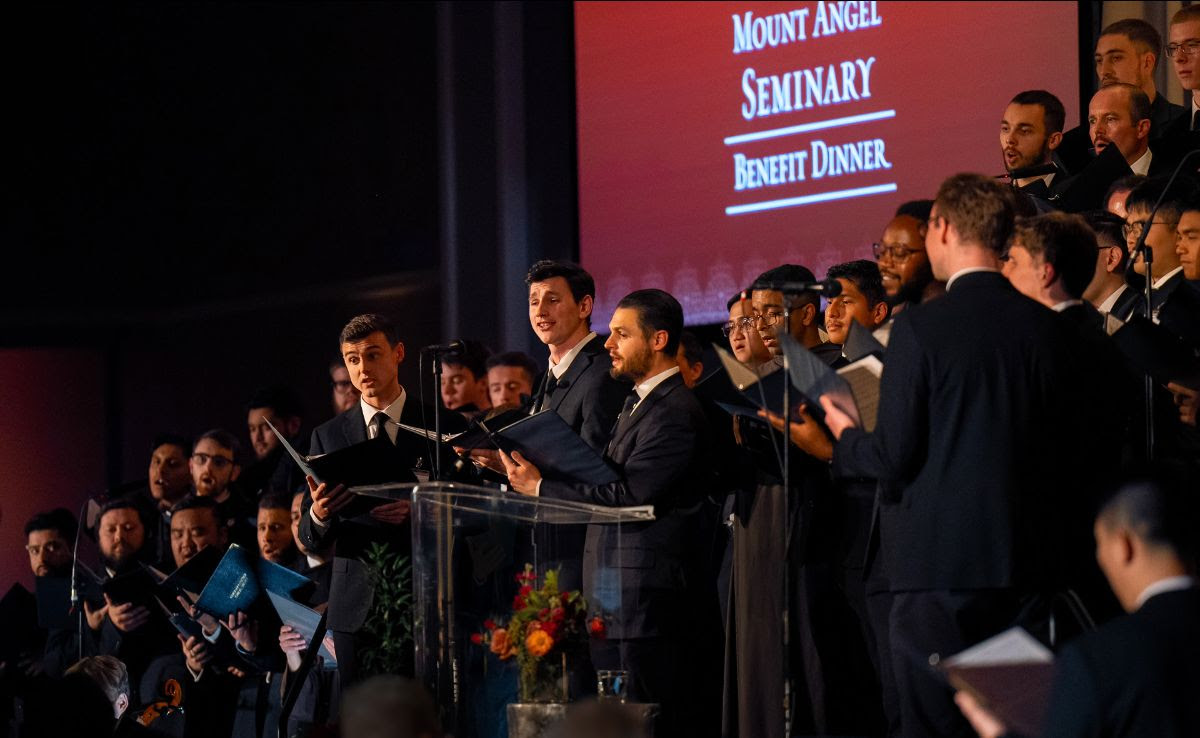
Pictures from the Seminary Benefit Dinner held last weekend.
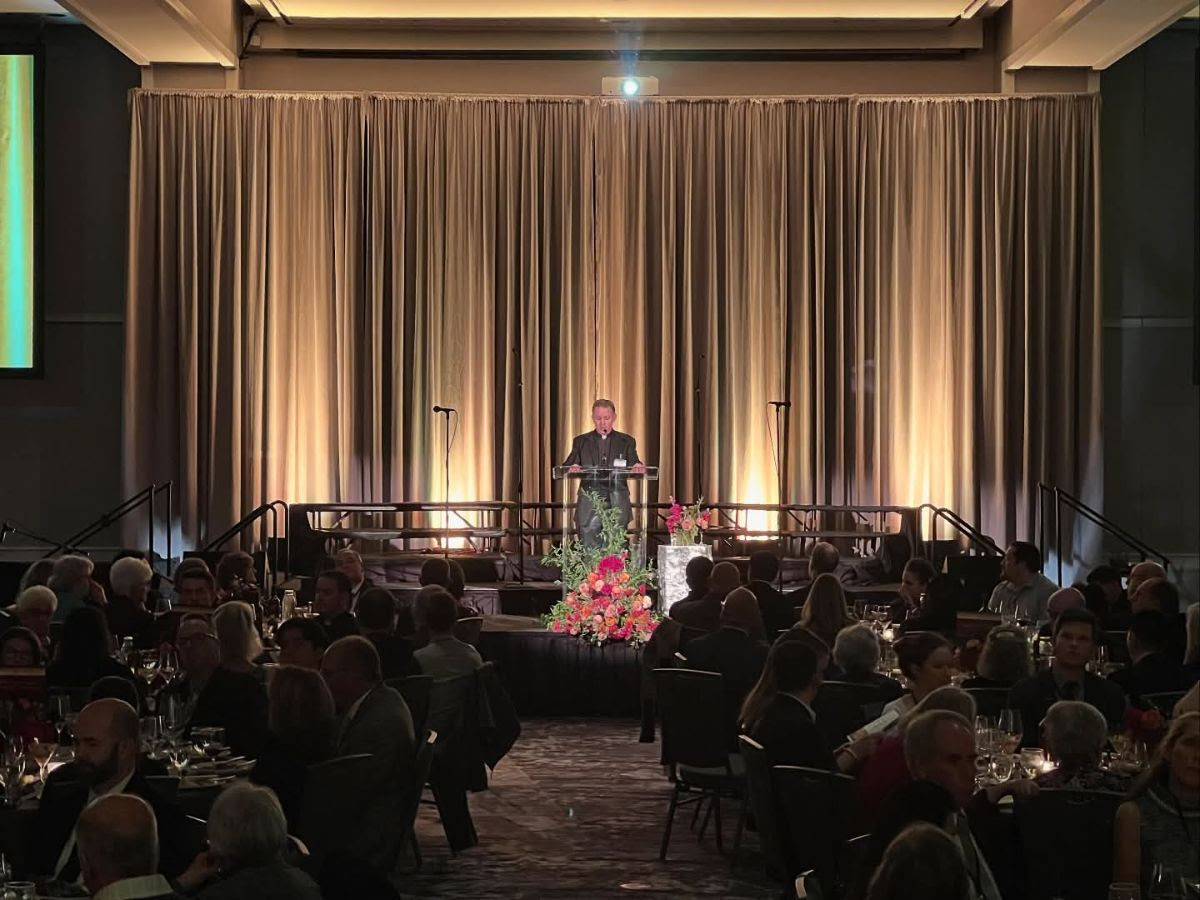
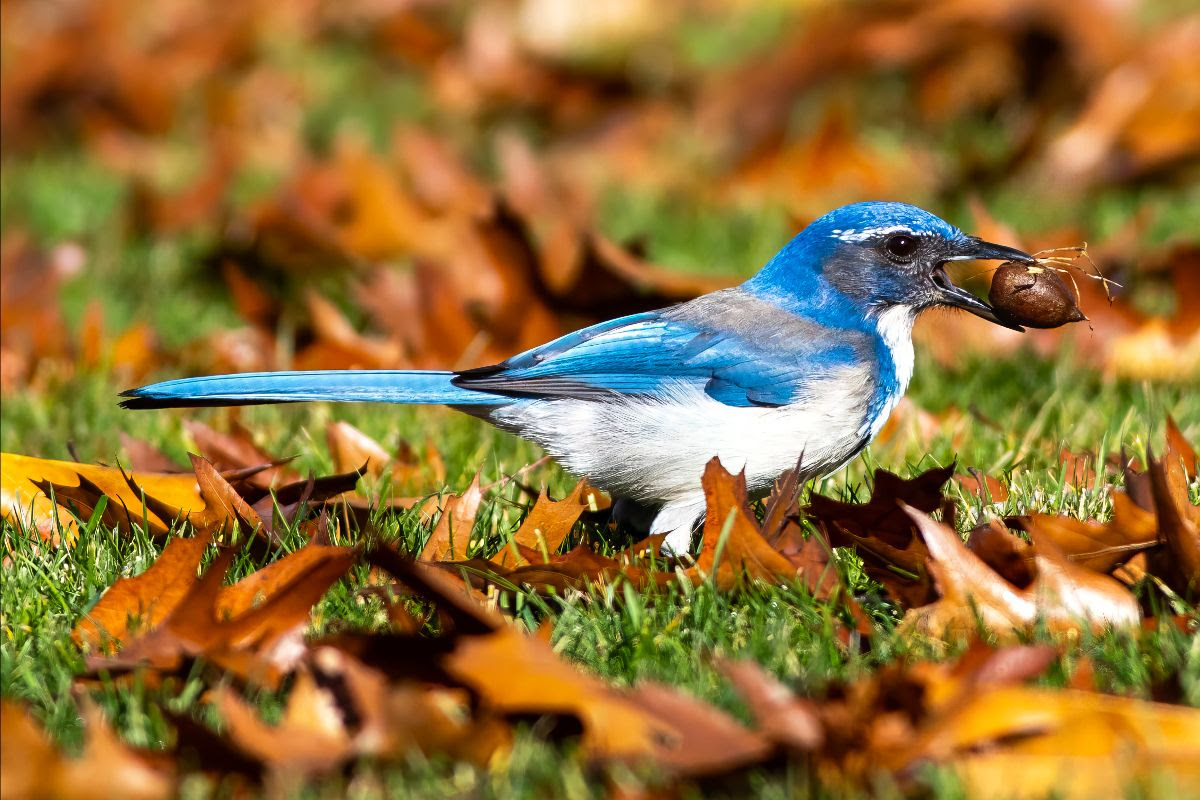
Fall bird sightings on the Hilltop.
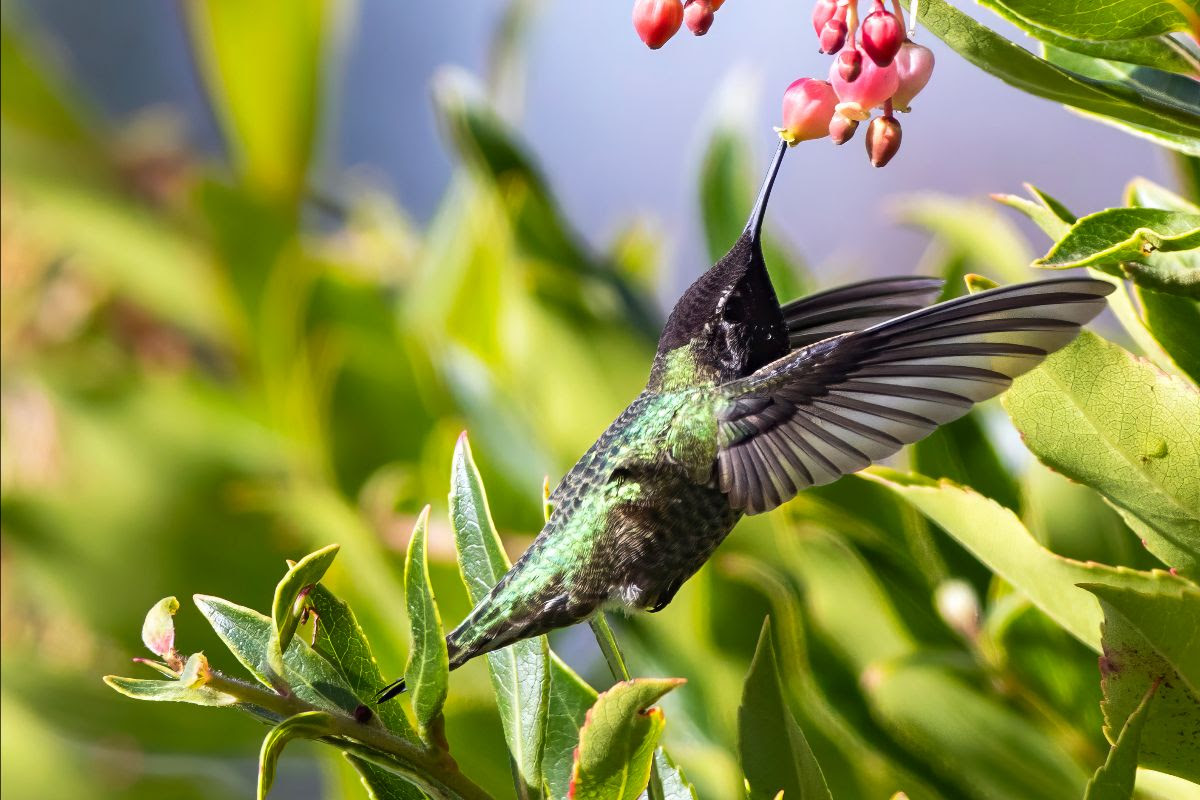
Oblate Calendar
2025
December
8 – Solemnity of the Immaculate Conception (plenary indulgence may be obtained by oblates)
14 – Oblate Sunday: Br. Thomas. The Psalms, Part III2026
Jan
11 – Oblate Sunday: Br. Thomas. The Psalms, Part IV.
15 – Feast of St. Maurus and Placid (plenary indulgence may be obtained by oblates)
Feb
6-8 – Oblate Retreat. Br. Louis. Lectio Divina on the Prodigal Son.
8 – Oblate Sunday
10 – St. Scholastica (plenary indulgence may be obtained by oblates)
18 – Ash Wednesday
March
8 – Oblate Sunday
9 – St. Frances of Rome (plenary indulgence may be obtained by oblates)
21 – Passing of St. Benedict (plenary indulgence may be obtained by oblates)
31 – Easter Sunday
April
12 – Oblate Sunday
May
15-17 – Oblate Retreat. Fr. Anselm. On the Most Holy Rosary.
June
14 – Oblate Sunday
18-21 – Oblate Study Days
21 – Oblate Picnic
July
11 – St. Benedict Festival
11 – Solemnity of St. Benedict (plenary indulgence may be obtained by oblates)
Aug
9 – Oblate Sunday –
Sept
13 – Oblate Sunday –
18-20 – Oblate Retreat. Fr. Ephrem.
29 – Solemnity of Archangels (plenary indulgence may be obtained by oblates)
Oct
Nov
6-8 – Oblate Retreat. Fr. Michael
8 – Oblate Sunday
Dec
8 – Immaculate Conception (plenary indulgence may be obtained by oblates)
13 – Oblate Sunday-
A Note to Our Dear Oblates - November 14, 2025
A Note to Our Dear Oblates
November 14, 2025Dear Oblates,
The Seven Rich Ways and the Liturgy
During the past month, we have been reading Cosima Gillhammer’s Light on Darkness, which relates of the powerful influence of the liturgy on the Christian life and culture. As I reflected upon this book, I saw that there were many points of connection between the liturgy and the seven rich ways. Indeed, two of the rich ways, namely the rich way of prayer and the rich way of centering on the Eucharist are a part of the liturgy. Since Benedictine spirituality is essentially liturgical spirituality, I would like to connect the other five rich ways to the liturgy, albeit a bit of a stretch in two instances.
The rich way of deep reading can be seen to relate to the liturgy in that the pondering the word of God can more powerfully dispose our minds and hearts to celebrate the liturgy more fully. For those who are inquiring about Benedictine spirituality or those who are novices, I generally recommend doing lectio divina for half an hour a week on the Sunday readings.
The rich way of life together finds its connection with the liturgy through the communion we have by receiving Holy Communion. As Saint Paul says, “we, though many, are one body, for we all partake of the one loaf” (1 Corinthians 10:17). Yes, our ties of family and friendship find their deepest union and love through participating in this spiritual practice. Thus, Fr. Peyton was able to say, “the family that prays together stays together.” We can slightly modify this and say, “the community that prays the liturgy together, stays together.”
The next rich way, that of hospitality, does not find a clear connection with the liturgy, but I would like to think about the fact that we call the Eucharist the Sacred Host. At the Mass, we are guests in the house of Christ, and he is a most gracious Host who welcomes us and feeds us a heavenly banquet by giving us the gift of himself. Through the gracious hospitality of Christ, we are able to welcome others as he welcomes us at every Eucharist.
This next rich way is connected with the liturgy only tangentially, and it is the rich way of caring for the land and environment. We do not directly care for creation during the liturgy, but the liturgy is so intimately connected with the cosmos, and it implicitly teaches us to respect and honor our planet. When the priest offers the bread and wine, he thanks God for His goodness by giving us these gifts, which are the fruit of the earth and work of human hands. In addition, the two major cycles of the year are intimately connected with the changing of the seasons. The Advent-Christmas cycle focuses on the seasonal transition from darkness to light, and Lent-Easter cycle brings a spiritual dimension to the death and new life witnessed through the transition into spring.
Lastly, the liturgy has for centuries been the source and inspiration for some of the greatest pieces of art. Flowing from or inspired by the liturgy, the church is endowed with the musical pieces such as Allegri’s Miserere or Samuel Barber’s Agnus Dei; artwork such as Michaelangeo’s Pieta or the Grunewald’s Isenheim Altarpiece; architecture styles such as Baroque and Gothic. These timeless works of art have for centuries inspired the faithful to a deeper love for Christ.
How does the liturgy shape your own life?
The Diocese of Orange, one of our sending dioceses, recently put out a wonderful new vocations video. The video was produced at the Abbey, and you can watch it here.
The Pope said Mass at Sant’ Anselmo, the Benedictine College in Rome. Abbot Jeremy said that this has not happened in decades.
I am happy to announce that you can now respond to these Notes to Oblates by simply hitting reply, and your email will be sent to my Oblate Director account. Additionally, I am trying to keep my oblate emails in a separate account, so please email me with oblate-related information at oblatedirector@mtangel.edu.
Prayer Request. Please pray for for Br. Ignatius’ mom and Fr. Teresio’s dad, who are both critically ill. Please also pray for the success of Br. Thomas’ organ recital this Saturday. Please know that you can always send your prayer requests through our Oremus program.
Yours in Christ,
Fr. John Paul, OSB
Director of Oblates
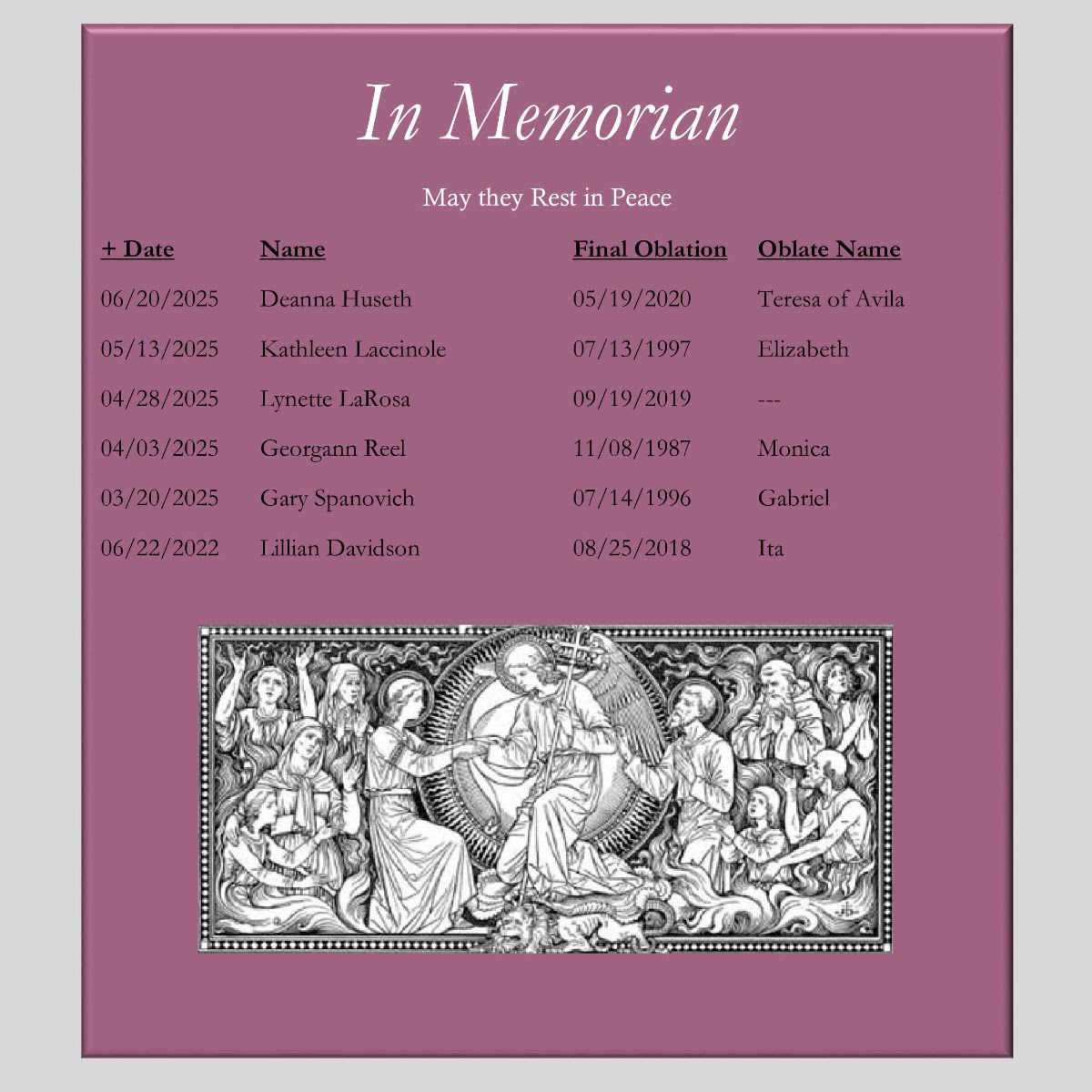
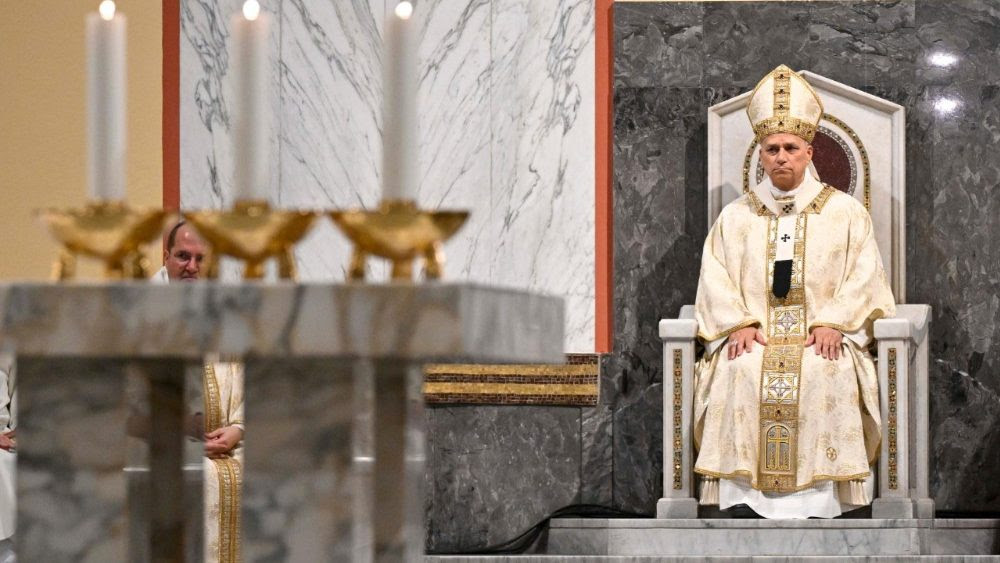
Pope Leo, Mass at Sant’Anselmo

New Oblates, Stephanie “Monica”, Agnes “Catherine”, Steven “Maurice”

New Novices
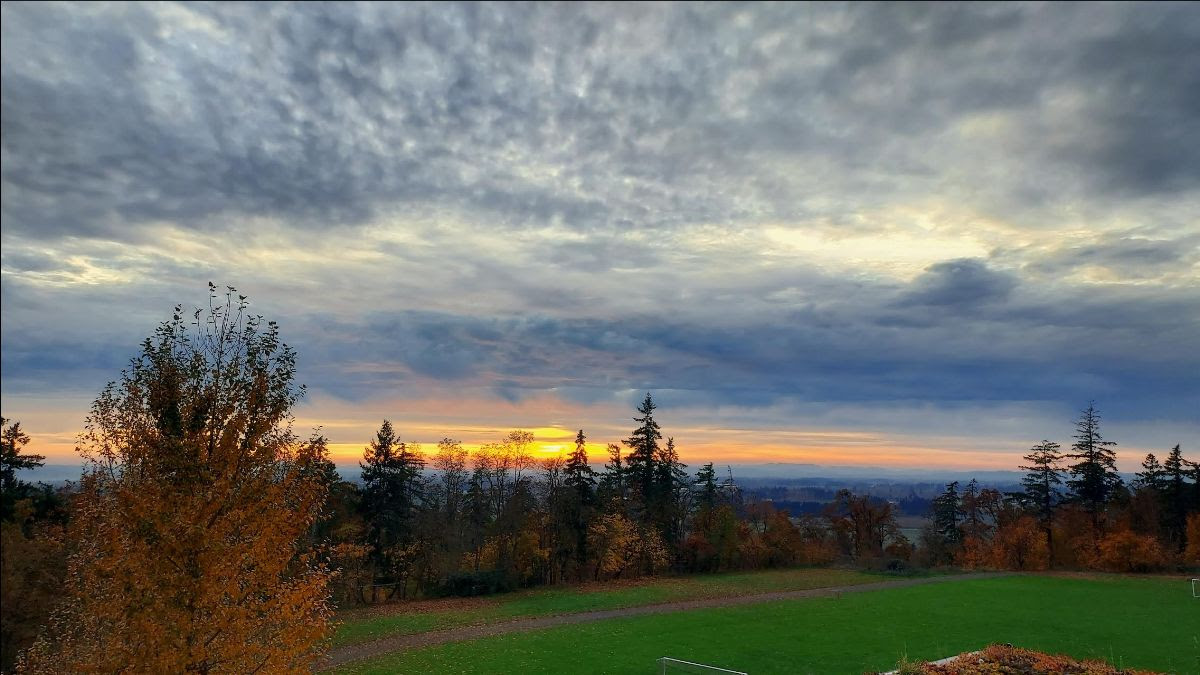
Sunset on the Hilltop
Oblate Calendar
2025
December
8 – Solemnity of the Immaculate Conception (plenary indulgence may be obtained by oblates)
14 – Oblate Sunday: Br. Thomas. The Psalms, Part III2026
Jan
11 – Oblate Sunday: Br. Thomas. The Psalms, Part IV.
15 – Feast of St. Maurus and Placid (plenary indulgence may be obtained by oblates)
Feb
6-8 – Oblate Retreat. Br. Louis. Lectio Divina on the Prodigal Son.
8 – Oblate Sunday
10 – St. Scholastica (plenary indulgence may be obtained by oblates)
18 – Ash Wednesday
March
8 – Oblate Sunday
9 – St. Frances of Rome (plenary indulgence may be obtained by oblates)
21 – Passing of St. Benedict (plenary indulgence may be obtained by oblates)
31 – Easter Sunday
April
12 – Oblate Sunday
May
15-17 – Oblate Retreat. Fr. Anselm. On the Most Holy Rosary.
June
14 – Oblate Sunday
18-21 – Oblate Study Days
21 – Oblate Picnic
July
11 – St. Benedict Festival
11 – Solemnity of St. Benedict (plenary indulgence may be obtained by oblates)
Aug
9 – Oblate Sunday –
Sept
13 – Oblate Sunday –
18-20 – Oblate Retreat. Fr. Ephrem.
29 – Solemnity of Archangels (plenary indulgence may be obtained by oblates)
Oct
Nov
6-8 – Oblate Retreat. Fr. Michael
8 – Oblate Sunday
Dec
8 – Immaculate Conception (plenary indulgence may be obtained by oblates)
13 – Oblate Sunday-
A Note to Our Dear Oblates - November 7, 2025
A Note to Our Dear Oblates
November 7, 2025Dear Oblates,
The Seven Rich Ways
Rich Ways of Promoting Art and Culture
In chapter 57 of the Holy Rule, Saint Benedict writes about the artisans of the monastery. This love for the arts has continued in Benedictine monasteries throughout the centuries. Indeed, the beauty with which the monks are engaged reflect the Lord, who is the source of all beauty. Here at the Abbey, we have our own artisans, who practice the arts of calligraphy, iconography and painting. There are also the artistic hobbies such as making candles and writing poetry. In terms of the musical arts, Benedictine monks have for centuries promoted the beautiful music of Gregorian chant and several of our monks play the organ. Also, the Abbey is privileged to have three architectural gems in the Aalto library, Guesthouse and Annunciation. It is through these ways of engaging with the material world that we manifest the beauty of God. This is possible because God has taken on matter through the mystery of the Lord’s incarnation. The world has become a vehicle of glorifying its Creator and creating a Christian culture.
While we do have monks who are quite artistic, there are many of us who seem to have very little artistic talent. This in no way prevents us from promoting art and culture because we can still do this by the way we live. Perhaps, it is done by the art we choose to hang in our room or the music we choose to listen to and share. There is a formative quality of the art that surrounds us. Winston Churchill says, “We shape our buildings; thereafter they shape us.” I think this can be extended to all the works of art and not just buildings.
Some of the ways in which the Abbey promotes art and culture are through the calligraphy exhibit, which is going on right now in the library, and having an organ concert next Saturday. Next March, the Mount Angel Chamber Choir will have its annual performance.
What role does the arts play in your life? How are you shaped by your surroundings?
The abbey is privileged to have the replica of the Shroud of Turin being displayed in the Abbey Guesthouse this weekend. You are welcome to come here and pray with it. Check out this website and video for more information on the Shroud.
I am trying to consolidate my oblate emails into a separate account and have been working to resolve the issues with replying to the Note to Oblates. Please email Kaitlyn at oblateassistant@mtangel.edu if you are still experiencing difficulties.
Our next Oblate Sunday is November 9th with Br. Thomas giving the second of his four talks on the psalms. For in-person, click here; for remote option, click here. The Oblate Sunday begins with Mass at the Abbey at 9am. It is followed by a potluck brunch after Mass in the guesthouse dining room. The conference starts at 11am in the Westminster Room.
Prayer request. Please pray for the oblates who will be on retreat this weekend, especially for the three novices who will be making final oblation. Please also pray for the success of the Seminary Benefit Dinner, which takes place tomorrow. Please know that you can always send your prayer requests through our Oremus program.Yours in Christ,Fr. John Paul, OSB
Director of Oblates
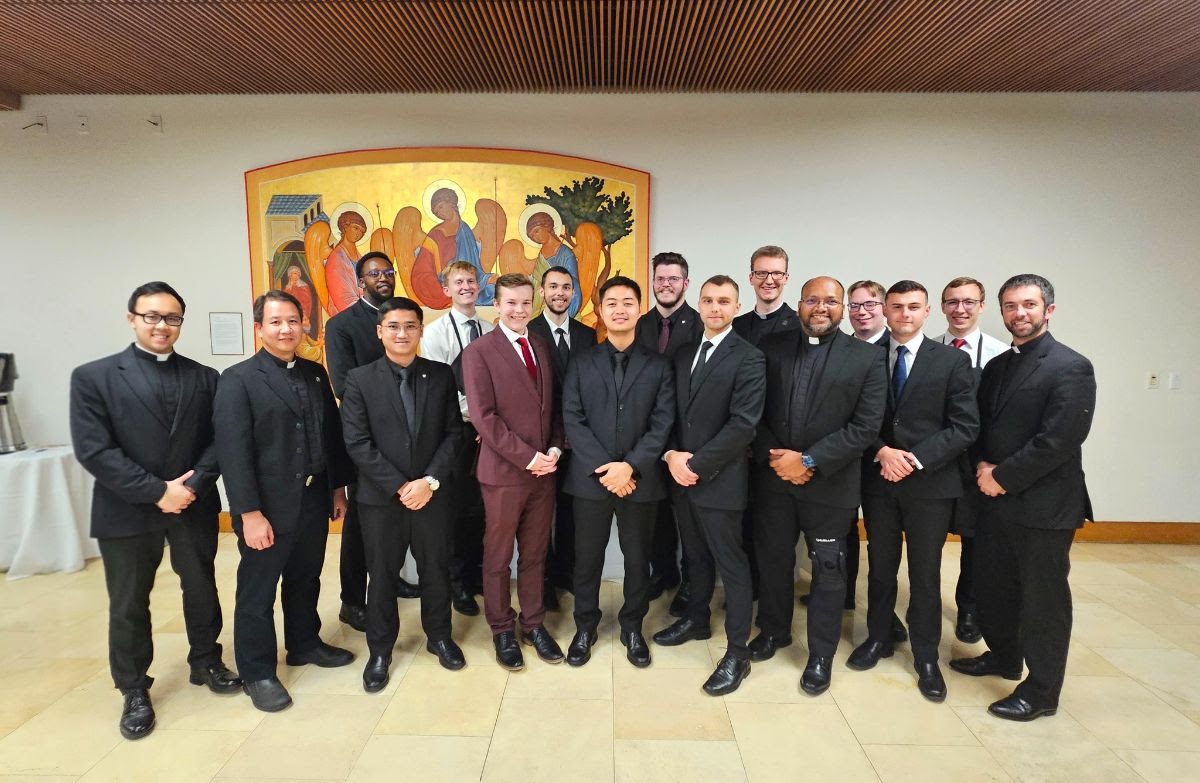

Oblate Calendar
2025
November
7-9 – Oblate Retreat: Abbot Peter
9 – Oblate Sunday: Br. Thomas. The Psalms, Part II.
December
8 – Solemnity of the Immaculate Conception (plenary indulgence may be obtained by oblates)
14 – Oblate Sunday: Br. Thomas. The Psalms, Part III2026
Jan
11 – Oblate Sunday: Br. Thomas. The Psalms, Part IV.
15 – Feast of St. Maurus and Placid (plenary indulgence may be obtained by oblates)
Feb
6-8 – Oblate Retreat. Br. Louis. Lectio Divina on the Prodigal Son.
8 – Oblate Sunday
10 – St. Scholastica (plenary indulgence may be obtained by oblates)
18 – Ash Wednesday
March
8 – Oblate Sunday
9 – St. Frances of Rome (plenary indulgence may be obtained by oblates)
21 – Passing of St. Benedict (plenary indulgence may be obtained by oblates)
31 – Easter Sunday
April
12 – Oblate Sunday
May
15-17 – Oblate Retreat. Fr. Anselm. On the Most Holy Rosary.
June
14 – Oblate Sunday
18-21 – Oblate Study Days
21 – Oblate Picnic
July
11 – St. Benedict Festival
11 – Solemnity of St. Benedict (plenary indulgence may be obtained by oblates)
Aug
9 – Oblate Sunday –
Sept
13 – Oblate Sunday –
18-20 – Oblate Retreat. Fr. Ephrem.
29 – Solemnity of Archangels (plenary indulgence may be obtained by oblates)
Oct
Nov
6-8 – Oblate Retreat. Fr. Michael
8 – Oblate Sunday
Dec
8 – Immaculate Conception (plenary indulgence may be obtained by oblates)
13 – Oblate Sunday-
A Note to Our Dear Oblates - October 31, 2025
A Note to Our Dear Oblates
October 31, 2025Dear Oblates,
The Seven Rich Ways
Rich Ways of HospitalitySaint Benedict in chapter 53 of the Holy Rule tells us that “all guests are to be received as Christ.” This is simply an echo of our Lord’s words when he said, “I was a stranger and you welcomed me” (Matthew 25:35). The monk’s faith leads him to believe that Christ is present in every guest that comes to the monastery. Indeed, it is because Christ is in the monk that he can see Christ in the stranger.
When I think about the rich ways of hospitality, I think about the five languages of love because we do not all exercise hospitality in the same way. Some of us exercise hospitality through service; we like to prepare a meal, pick up dishes or serve seconds to others. Others show hospitality through their words, by telling stories or giving encouragement or spiritual insight. Another language of love is spending quality time with others; this means simply being present to them and listening to them. Others have the love language of giving gifts; they are inclined to write notes or give presents to others. Lastly there is the language of touch, which may be a hug, holding hands or a touch on the shoulder. I think the languages of love are important when we think about hospitality because not everyone exercises hospitality in the same way.
While some people can welcome guests into their homes, not everybody is able to do this. However, we can offer hospitality to the stranger at our workplace or church by welcoming them into our circle. We can offer hospitality to them by welcoming them into our hearts and showing interest in them. Hospitality is not always easy and oftentimes involves a sacrifice because we have to disrupt our routines, plans and schedules to warmly receive Christ in the guest. However, by doing so, he will give us his blessing.
We here at Mount Angel hope that all guests who visit our church, guest house, bookstore or brewery will feel that they are being received as Christ himself.
How do you practice the rich ways of hospitality? What is your language of love?
I am trying to consolidate my oblate emails into a separate account, so people are having problems in responding to the Note to Oblates. We hope to get this fixed soon.
Our next Oblate Sunday is November 9th with Br. Thomas giving the second of his four talks on the psalms. For in-person, click here; for remote option, click here. The Oblate Sunday begins with Mass at the Abbey at 9am. It is followed by a potluck brunch after Mass in the guesthouse dining room. The conference starts at 11am in the Westminster Room.You can now read the Pope’s Apostolic Exhortation Dilexi Te.Prayer request. Please pray for the seminary’s theological symposium next Thursday and Friday. The topic is the 1700th anniversary of the Council of Nicaea. Please know that you can always send your prayer requests through our Oremus program.Yours in Christ,Fr. John Paul, OSB
Director of Oblates
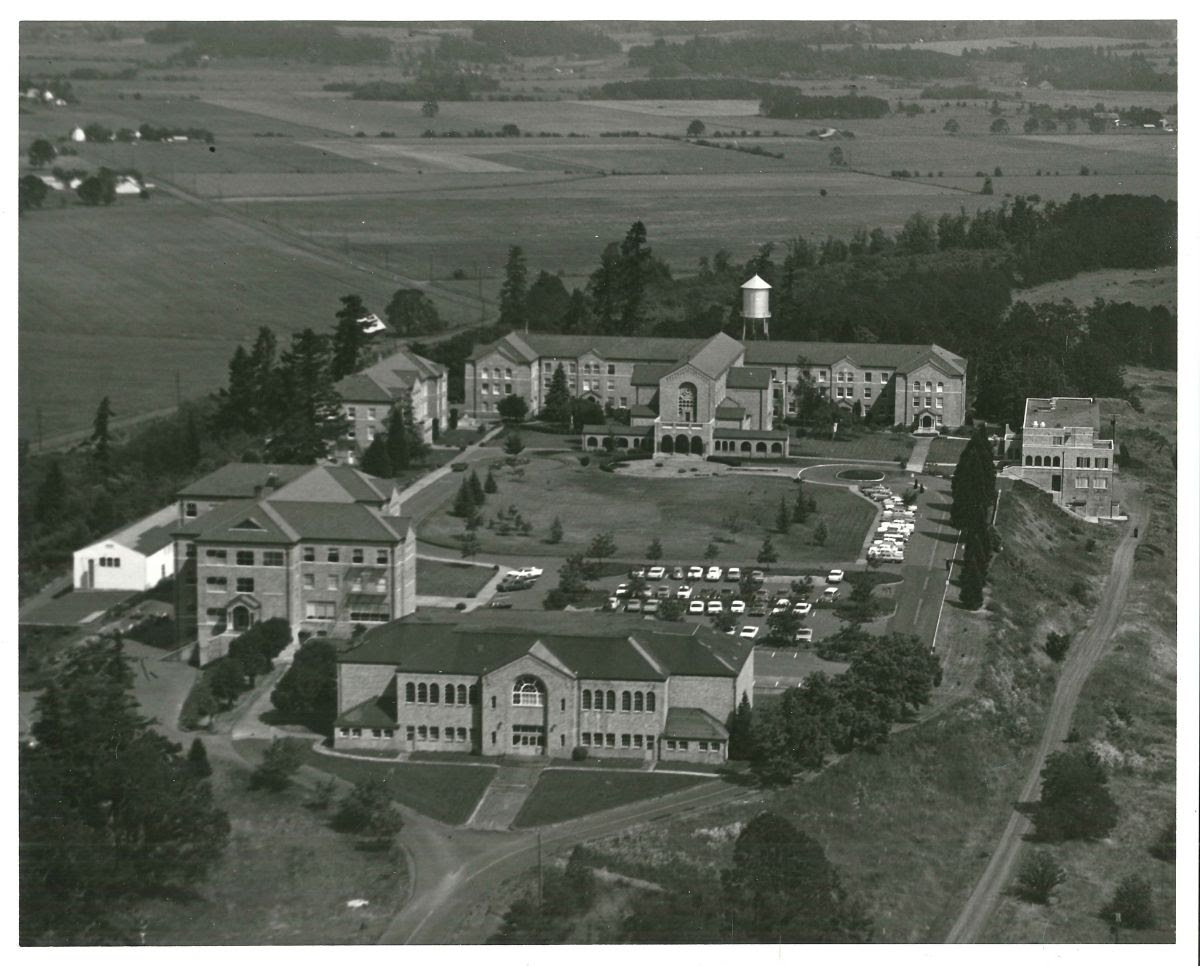
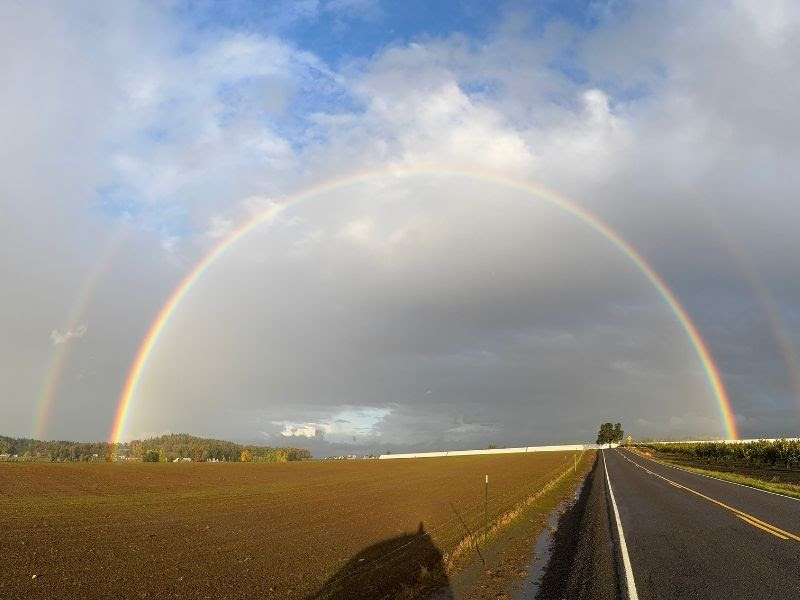
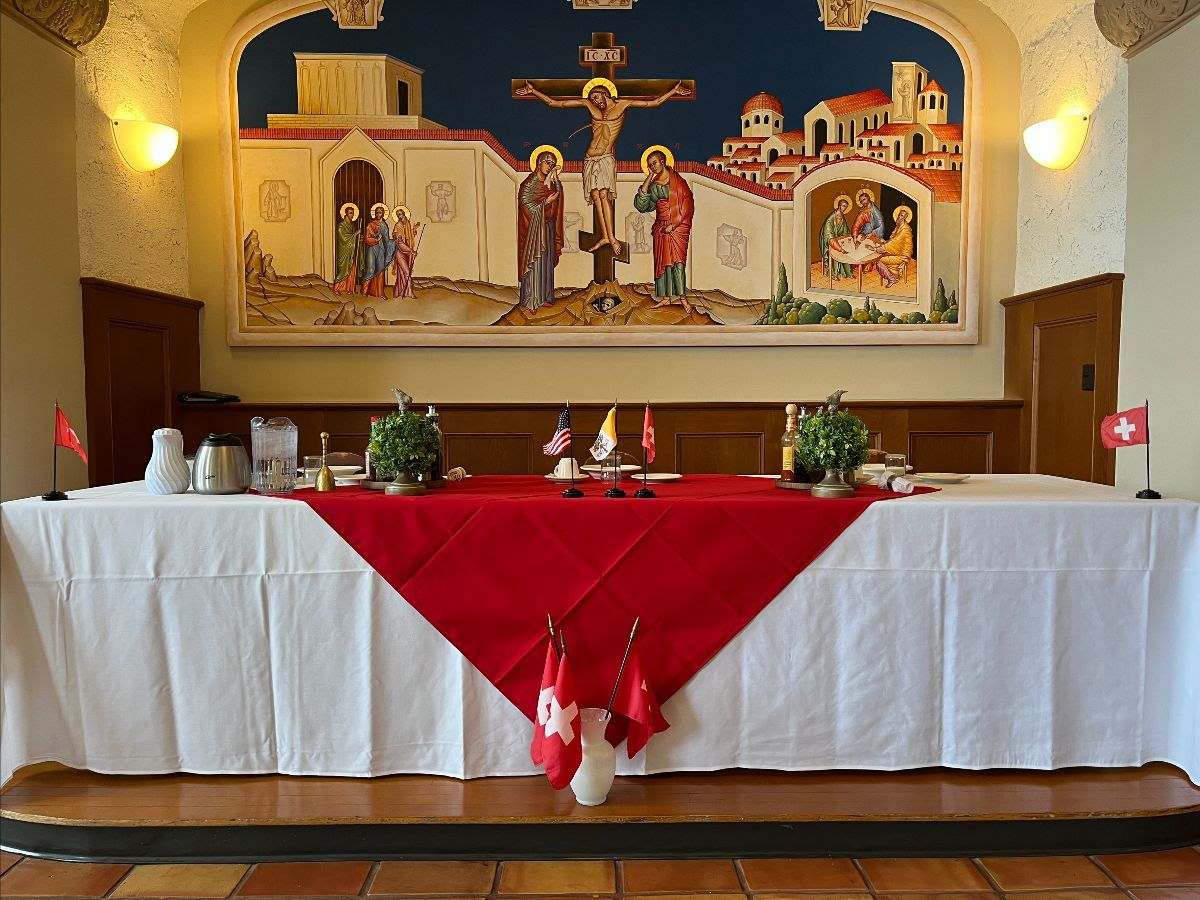
Foundation Day in the refectory.
Oblate Calendar
2025
November
7-9 – Oblate Retreat: Abbot Peter
9 – Oblate Sunday: Br. Thomas. The Psalms, Part II.
December
8 – Solemnity of the Immaculate Conception (plenary indulgence may be obtained by oblates)
14 – Oblate Sunday: Br. Thomas. The Psalms, Part III2026
Jan
11 – Oblate Sunday: Br. Thomas. The Psalms, Part IV.
15 – Feast of St. Maurus and Placid (plenary indulgence may be obtained by oblates)
Feb
6-8 – Oblate Retreat. Br. Louis. Lectio Divina on the Prodigal Son.
8 – Oblate Sunday
10 – St. Scholastica (plenary indulgence may be obtained by oblates)
18 – Ash Wednesday
March
8 – Oblate Sunday
9 – St. Frances of Rome (plenary indulgence may be obtained by oblates)
21 – Passing of St. Benedict (plenary indulgence may be obtained by oblates)
31 – Easter Sunday
April
12 – Oblate Sunday
May
15-17 – Oblate Retreat. Fr. Anselm. On the Most Holy Rosary.
June
14 – Oblate Sunday
18-21 – Oblate Study Days
21 – Oblate Picnic
July
11 – St. Benedict Festival
11 – Solemnity of St. Benedict (plenary indulgence may be obtained by oblates)
Aug
9 – Oblate Sunday –
Sept
13 – Oblate Sunday –
18-20 – Oblate Retreat. Fr. Ephrem.
29 – Solemnity of Archangels (plenary indulgence may be obtained by oblates)
Oct
Nov
6-8 – Oblate Retreat. Fr. Michael
8 – Oblate Sunday
Dec
8 – Immaculate Conception (plenary indulgence may be obtained by oblates)
13 – Oblate Sunday-
A Note to Our Dear Oblates - October 24, 2025
A Note to Our Dear Oblates
October 24, 2025Dear Oblates,
The Seven Rich Ways
Rich Ways of Caring for the Land and EnvironmentOne of the three vows that monks make is that of stability. Saint Benedict tells us that cenobites belong to a monastery (chapter 2). It is in the monastery that the monk will spend most of his life, and generally, it is in the monastery that the monk will die. The amount of time that a monk spends in this space makes him grow to love the place and care for the place. Hence, monks are called to be “lovers of the place”. They care not only for the monastery building but also for the land and environment that surrounds it. Therefore, monks throughout the centuries have cared for in the earth and produced crops; they have cultivated gardens and have kept their landscapes beautiful. Scriptures tells us that through the beauty of created things, the author by analogy is seen (Wisdom 13:5).
Monks by presiding in one place and caring for the land and environment were “green” far before being green became popular. It is true that not all monks care for the land directly by working on the grounds; However, we do have a great appreciation of the natural beauty that surrounds us. We like to go on walks around the hilltop and in the cloister garden; we enjoy seeing the sunrise over Mount Hood and the sunset over the valley. There is simply a therapeutic effect by being in the presence of God in nature. Monks used to say, “all this and heaven too?” Father Augustine was always quick to respond, “if you are good.” Here at the Abbey people always remark about how beautiful the hilltop is, and how through it they encounter God and develop a deep sense of peace.
How do you practice the rich way of caring for the land and environment? What more could you do?
Our next Oblate Sunday is November 9th with Br. Thomas giving the second of his four talks on the psalms. For in-person, click here; for remote option, click here. The Oblate Sunday begins with Mass at the Abbey at 9am. It is followed by a potluck brunch after Mass in the guesthouse dining room. The conference starts at 11am in the Westminster Room.
As you know the oblate program is growing in leaps and bounds. In order to help me with coordinating events and emails (such as this one), oblate Kaitlyn Edmonds will be assisting me.
Here’s a link to a nice video of the Abbey with Amazing Grace sung and accompanied by a harp.
Prayer request. Please pray for Shawn Keough (professor) and Rolando Moreno (former professor) who will be ordained to the diaconate on Saturday. Please know that you can always send your prayer requests through our Oremus program.Yours in Christ,Fr. John Paul, OSB
Director of Oblates
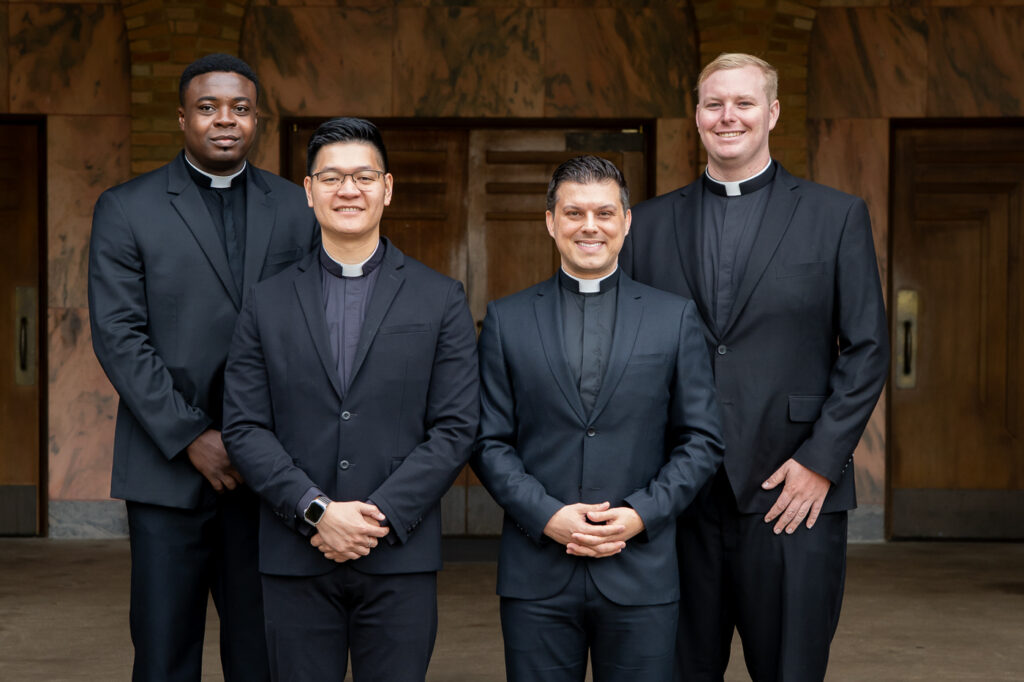
(Left to right): Jude Ozemoya Isaac, Archdiocese of Las Vegas; An Thien Nguyen, Diocese of Sacramento; Anthony Kyle Rosas, Diocese of Orange; and Connor William Brown, Diocese of Orange.
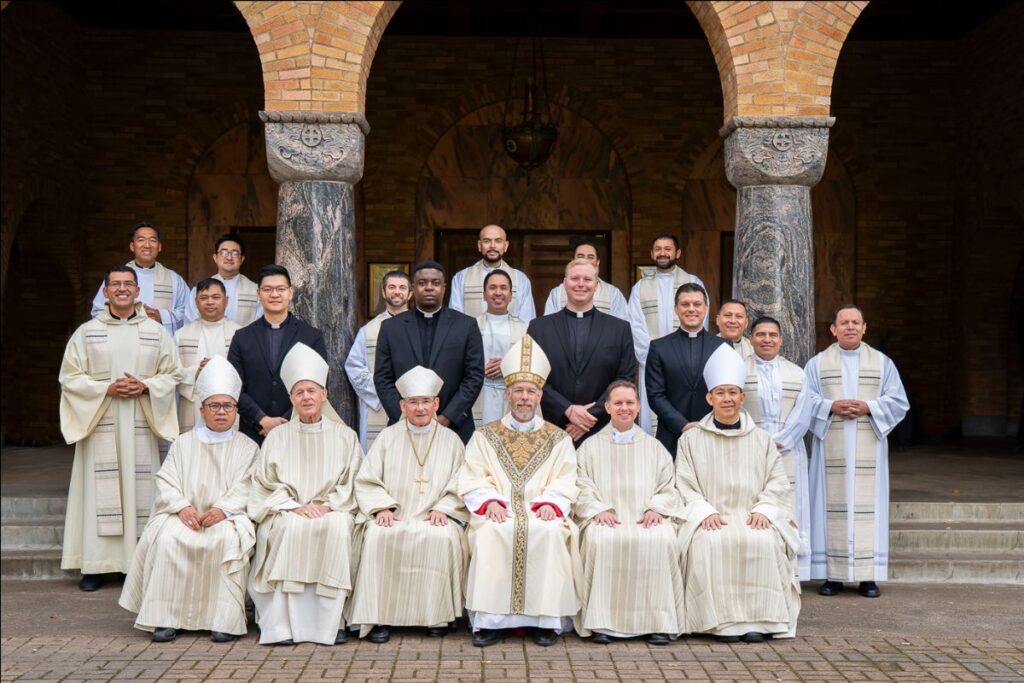
Oblate Calendar
2025
November
7-9 – Oblate Retreat: Abbot Peter
9 – Oblate Sunday: Br. Thomas. The Psalms, Part II.
December
8 – Solemnity of the Immaculate Conception (plenary indulgence may be obtained by oblates)
14 – Oblate Sunday: Br. Thomas. The Psalms, Part III2026
Jan
11 – Oblate Sunday: Br. Thomas. The Psalms, Part IV.
15 – Feast of St. Maurus and Placid (plenary indulgence may be obtained by oblates)
Feb
6-8 – Oblate Retreat. Br. Louis. Lectio Divina on the Prodigal Son.
8 – Oblate Sunday
10 – St. Scholastica (plenary indulgence may be obtained by oblates)
18 – Ash Wednesday
March
8 – Oblate Sunday
9 – St. Frances of Rome (plenary indulgence may be obtained by oblates)
21 – Passing of St. Benedict (plenary indulgence may be obtained by oblates)
31 – Easter Sunday
April
12 – Oblate Sunday
May
15-17 – Oblate Retreat. Fr. Anselm. On the Most Holy Rosary.
June
14 – Oblate Sunday
18-21 – Oblate Study Days
21 – Oblate Picnic
July
11 – St. Benedict Festival
11 – Solemnity of St. Benedict (plenary indulgence may be obtained by oblates)
Aug
9 – Oblate Sunday –
Sept
13 – Oblate Sunday –
18-20 – Oblate Retreat. Fr. Ephrem.
29 – Solemnity of Archangels (plenary indulgence may be obtained by oblates)
Oct
Nov
6-8 – Oblate Retreat. Fr. Michael
8 – Oblate Sunday
Dec
8 – Immaculate Conception (plenary indulgence may be obtained by oblates)
13 – Oblate Sunday-
A Note to Our Dear Oblates - October 18, 2025
A Note to Our Dear Oblates
October 18, 2025Dear Oblates,
The Seven Rich Ways
Rich Ways of Centering on the EucharistWithout a doubt, the center of life here on the Abbey is the daily celebration of the Eucharist, where we encounter Christ directly in receiving him in his Body and Blood. The holy Mass is so amazing that truly no words can describe its greatness and no mind comprehend its fullness. The church tells us that the Eucharist is the source and summit of the Christian life, that is, all our heart, mind, body and soul should be directed toward it, and it should be the font of all that is good in our life (Sacrosanctum Concilium 10). The Eucharist is something that our Lord greatly desired to institute on the night he was betrayed (Lk 22:15). As Christ was about to leave his disciples in the body, he would continue to be with them in the Sacrament. Hence, the Sacrament is spoken of as the sacrament of love.
What greater gift could God have given us than the gift of himself? In instituting the Eucharist, the Lord was giving his apostles a means by which the church would make present the mysteries of his life, namely, his incarnation, death, resurrection, ascension and sending of the Holy Spirit. Since he is God, his deeds and words do not pass away, and the hour for which he came is re-presented in an unbloody manner at the altar. Even if the music is bad or the homily stale, this does not take away from the reality of the mysteries. If only we knew what graces were received in assisting at even at one Mass, how greatly astonished we would be. If we knew how much he loved us, we would cry.
How do you make the Eucharist the center of your life? Is it the summit toward which you activity revolves and the source from which you draw your strength?
Our next Oblate Sunday is November 9th with Br. Thomas giving the second of his four talks on the psalms. For in-person, click here; for remote option, click here. The Oblate Sunday begins with Mass at the Abbey at 9am. It is followed by a potluck brunch after Mass in the guesthouse dining room. The conference starts at 11am in the Westminster Room.
I am happy to announce that Fr. Stephen Rowan will be our speaker for the Oblate Study Days next year (June 18-21, 2026). He will be giving lectures on the lectionary through the liturgical year. To sign up, please email retreat@mtangel.edu. His description of the Study Days is below.
The Lectionary in the Liturgical Year
Most Catholics encounter the Scriptures primarily through the proclamation of the readings at Sunday Mass. Those readings inform the celebration of each Eucharist by providing specific reasons for thanksgiving, and the Eucharist, in turn, forms the church, the body of Christ.The Lectionary, the liturgical book containing these readings, in a beautiful and well-conceived way, has set forth the riches of the scriptures more lavishly and systematically than at any time in the Church’s history. In this retreat, we will reflect in nine presentations on how the Lectionary helps to form the Church at each Eucharist as the people of God, the Body of Christ, and the Temple of the Holy Spirit. We will reflect on how the scriptures shape the celebrations of the Liturgical Year (the seasons of Advent, Christmas, Lent, and Eastertime and the Sundays of Ordinary Time), even as those celebrations shape the Church.
In nine presentations, it will be possible to touch only briefly and by way of example on how the scriptures inform the celebrations of the Eucharist in the Liturgical Year. However, the purpose of the Retreat will be achieved if the general principles of arrangement are understood and their significance for celebrating the Eucharist is appreciated.
Prayer request. Please pray for our seminarians who will receive their candidacy this Wednesday. Please also pray for the Episcopal Council that will be meeting on the same day. Please know that you can always send your prayer requests through our Oremus program.Yours in Christ,
Fr. John Paul, OSB
Director of Oblates
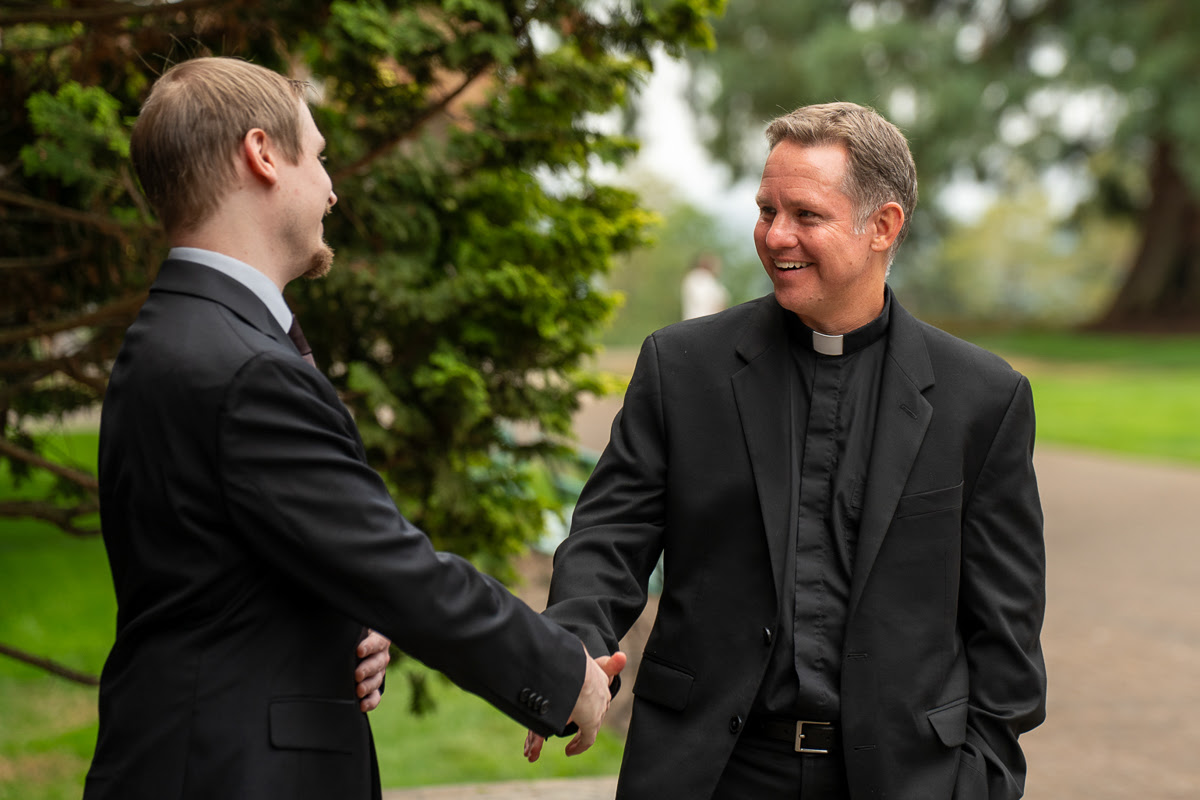

New candle for the Advent seasson. Do you recognize the monk?
Oblate Calendar
2025
November
7-9 – Oblate Retreat: Abbot Peter
9 – Oblate Sunday: Br. Thomas. The Psalms, Part II.
December
8 – Solemnity of the Immaculate Conception (plenary indulgence may be obtained by oblates)
14 – Oblate Sunday: Br. Thomas. The Psalms, Part III2026
Jan
11 – Oblate Sunday: Br. Thomas. The Psalms, Part IV.
15 – Feast of St. Maurus and Placid (plenary indulgence may be obtained by oblates)
Feb
6-8 – Oblate Retreat. Br. Louis. Lectio Divina on the Prodigal Son.
8 – Oblate Sunday
10 – St. Scholastica (plenary indulgence may be obtained by oblates)
18 – Ash Wednesday
March
8 – Oblate Sunday
9 – St. Frances of Rome (plenary indulgence may be obtained by oblates)
21 – Passing of St. Benedict (plenary indulgence may be obtained by oblates)
31 – Easter Sunday
April
12 – Oblate Sunday
May
15-17 – Oblate Retreat. Fr. Anselm. On the Most Holy Rosary.
June
14 – Oblate Sunday
18-21 – Oblate Study Days
21 – Oblate Picnic
July
11 – St. Benedict Festival
11 – Solemnity of St. Benedict (plenary indulgence may be obtained by oblates)
Aug
9 – Oblate Sunday –
Sept
13 – Oblate Sunday –
18-20 – Oblate Retreat. Fr. Ephrem.
29 – Solemnity of Archangels (plenary indulgence may be obtained by oblates)
Oct
Nov
6-8 – Oblate Retreat. Fr. Michael
8 – Oblate Sunday
Dec
8 – Immaculate Conception (plenary indulgence may be obtained by oblates)
13 – Oblate Sunday-
A Note to Our Dear Oblates - October 11, 2025
A Note to Our Dear Oblates
October 11, 2025Dear Oblates,
The Seven Rich Ways
Rich Ways of Life TogetherThe holy rule was written for cenobites, that is, a community of monks, and it is through the rich ways of life together that we encounter Christ and go to everlasting life. However, living in community has its challenges since we are sinful creatures. At least 14 of the 73 chapters in the holy rule deal specifically with the penal code. In chapter 7, Saint Benedict tells us that we are to put up with “false brothers, endure persecution, and bless those who curse [us]”. In chapter 72, Saint Benedict talks about exercising the greatest patience towards one another’s weaknesses of body and behavior. All these statements may tempt one to toss aside the garment of community life in favor of an idealized eremitical life.
However, with the trials inherit to community life, there are also the benefits. Saint Benedict talks about the Abbot as a wise physician, who cares for the souls of his monks and leads by the twofold teaching of word and example (2). Saint Benedict also talks about elders encouraging the straying monk to be humble (27). He has the monks encourage one another upon rising because the sleepy like to make excuses (22). All these positive factors of community life clearly balance and outweigh the negative factors.
Here at Mount Angel, two major points of the rich ways of living together are simply praying and eating together. How difficult it is when I have to pray Lauds on my own. How different it feels when I am eating alone. There is simply something beneficial when we do things together. Did our Lord not say, “where two or three are gathered in my name, there I am in the midst of them” (Mt 18:20).
Besides these two constants in community life, monks have recreation together every day for about an hour. This is a time for us to relax and enjoy each other’s company. Card games have always been part of the lot although a seismic shift is occurring. For decades, pinnacle was the game of choice and is now approaching extinction. This has been recently replaced by the popular game Sequence, aka, tic-tac-toe for adults. Along with card games and board games, there is always the usual conversation that goes around the island in the coffee shop or going for a walk or more recently, the development of reading groups.
The rich ways of life together is a reminder for us that, “it is not good for the man to be alone” (Gn 2:18). Monks like all people are made for communion. How do you experience the rich ways of life together? How do you isolate yourself from community. Is there something you can do to grow in rich ways of life together?
I am happy to announce that Fr. Stephen Rowan will be our speaker for the Oblate Study Days next year (June 18-21, 2026). He will be giving lectures on the lectionary through the liturgical year. To sign up, please email retreat@mtangel.edu.
Yours in Christ,
Fr. John Paul, OSB
Director of Oblates
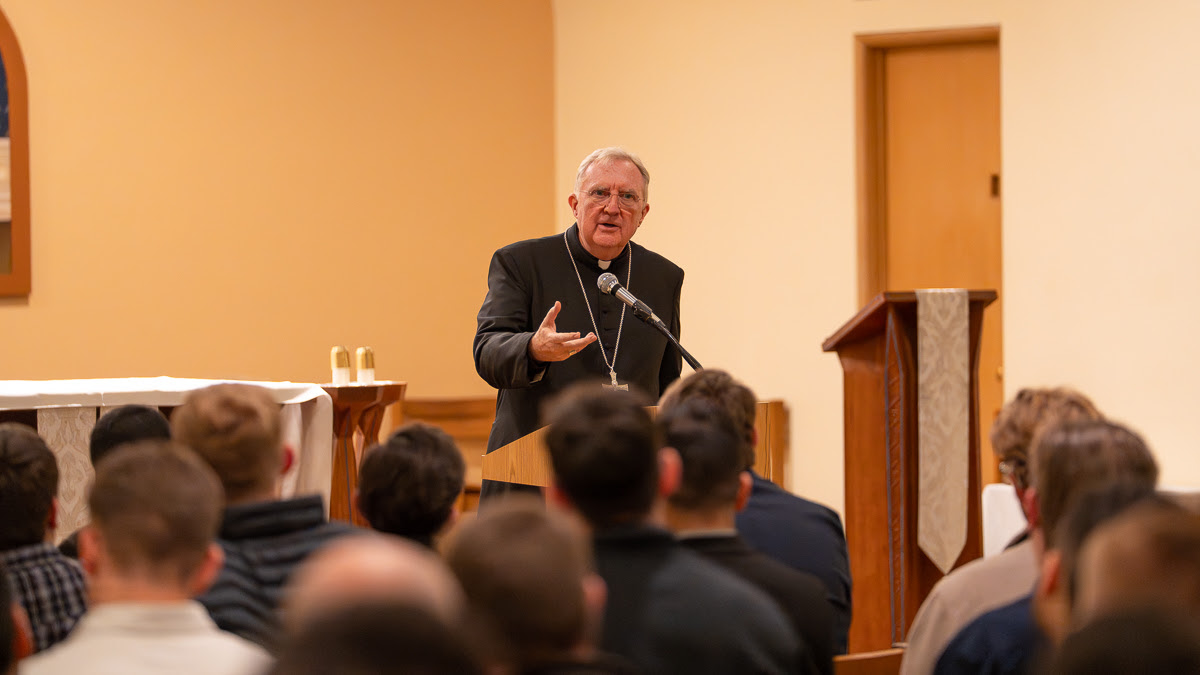
Cardinal Roche giving conference to seminarians.
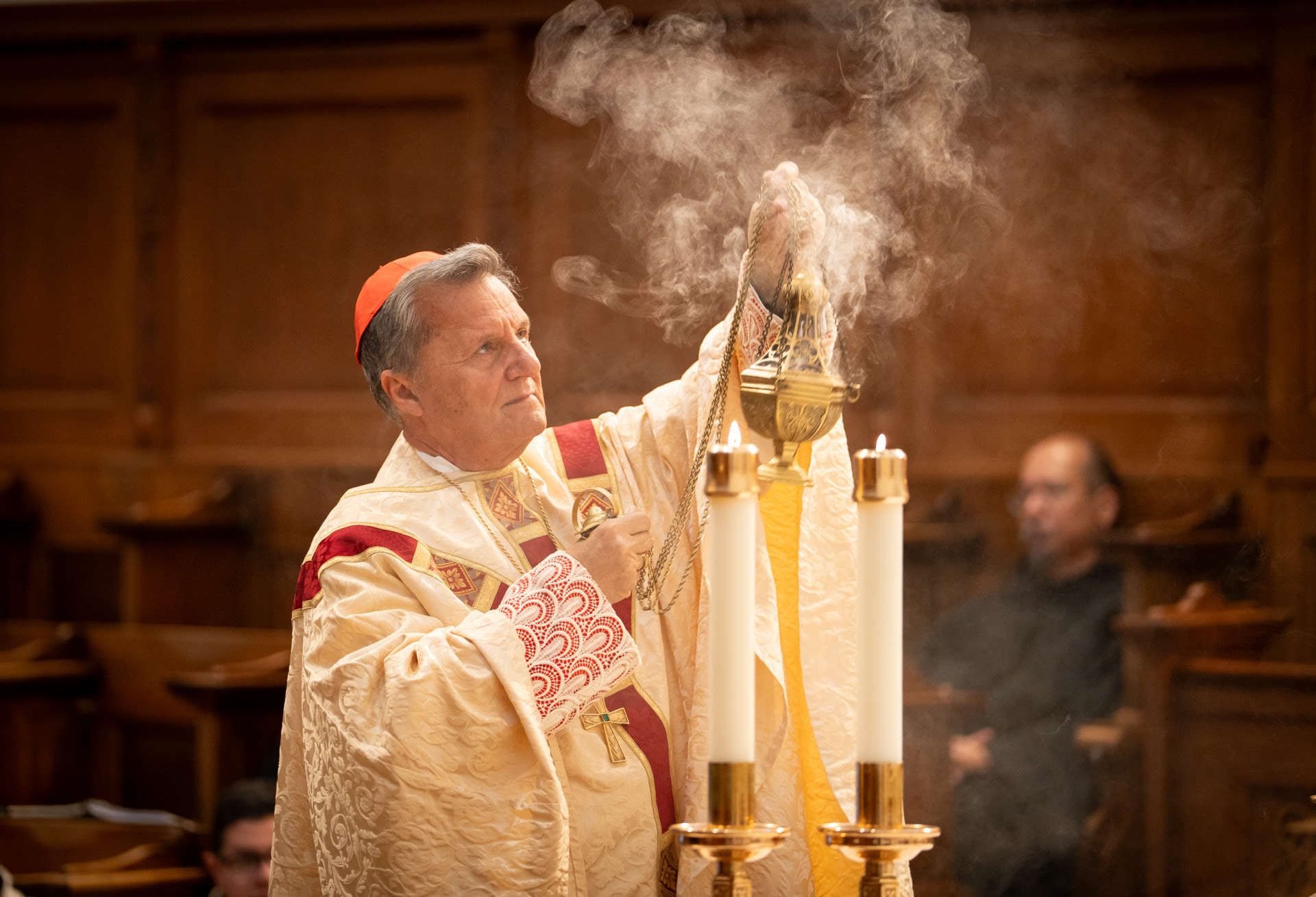
Cardinal Grech during Mass.
Oblate Calendar
2025
November
7-9 – Oblate Retreat: Abbot Peter
9 – Oblate Sunday: Br. Thomas. The Psalms, Part II.
December
8 – Solemnity of the Immaculate Conception (plenary indulgence may be obtained by oblates)
14 – Oblate Sunday: Br. Thomas. The Psalms, Part III2026
Jan
11 – Oblate Sunday: Br. Thomas. The Psalms, Part IV.
15 – Feast of St. Maurus and Placid (plenary indulgence may be obtained by oblates)
Feb
6-8 – Oblate Retreat. Br. Louis. Lectio Divina on the Prodigal Son.
8 – Oblate Sunday
10 – St. Scholastica (plenary indulgence may be obtained by oblates)
18 – Ash Wednesday
March
8 – Oblate Sunday
9 – St. Frances of Rome (plenary indulgence may be obtained by oblates)
21 – Passing of St. Benedict (plenary indulgence may be obtained by oblates)
31 – Easter Sunday
April
12 – Oblate Sunday
May
15-17 – Oblate Retreat. Fr. Anselm. On the Most Holy Rosary.
June
14 – Oblate Sunday
18-21 – Oblate Study Days
21 – Oblate Picnic
July
11 – St. Benedict Festival
11 – Solemnity of St. Benedict (plenary indulgence may be obtained by oblates)
Aug
9 – Oblate Sunday –
Sept
13 – Oblate Sunday –
18-20 – Oblate Retreat. Fr. Ephrem.
29 – Solemnity of Archangels (plenary indulgence may be obtained by oblates)
Oct
Nov
6-8 – Oblate Retreat. Fr. Michael
8 – Oblate Sunday
Dec
8 – Immaculate Conception (plenary indulgence may be obtained by oblates)
13 – Oblate Sunday-
A Note to Our Dear Oblates - October 3, 2025
A Note to Our Dear Oblates
October 3, 2025Dear Oblates,
The Seven Rich Ways
Rich Ways of PrayerIn the Holy Rule, Saint Benedict writes about two preferences to which nothing is to be preferred. The first is the love of Christ and the second is the work of God, that is, liturgical prayer. Indeed, these are two sides of the same coin, for the Benedictine monk/oblate shows his love for Christ by uniting to Him in the Work of God. The liturgical hours were prayed from the beginning of Christianity itself. The General Instruction of the Liturgy of the Hours (GILH)–good reading for oblates–reads, “we read [in the Acts of the Apostles] of the disciples gathered together at the third hour. The prince of the apostles ‘went up on the housetop to pray, about the sixth hour’ (10:9); ‘Peter and John were going up to the temple at the hour of prayer, the ninth hour’ (3:1); ‘about midnight Paul and Silas were praying and singing hymns to God (16:25)’” (GILH 1). We see that these hours are not something Saint Benedict invented but a continuation of the apostolic tradition of prayer. Indeed, we read that the first Christian community “devoted themselves to the teaching of the apostles and to the communal life, to the breaking of the bread and to the prayers” (Acts 2:42). Saint Benedict’s monastic community reflects the early Christian community in its prayer.
This rich way of prayer may not be familiar to many Catholics, since we are probably more familiar with the rosary or the chaplet of divine mercy or the stations of the cross. However, the Church has been urging us to get back to our Christian roots and to pray the liturgy of the hours. The General Instruction reads, “The laity must learn above all how in the liturgy they are adoring God the Father in spirit and in truth; they should bear in mind that through public worship and prayer they reach all humanity and can contribute significantly to the salvation of the whole world” (27). Liturgical prayer is unique in that it is not simply a prayer we say, like the rosary, but it is instead of the prayer of Christ, the Head, and we simply join Him in His prayer to the Father. This is why an ancient prayer before the divine office ends with the words, “O Lord in union with that divine intention wherewith Thou Thyself didst offer Thy prayers to God while upon this earth, I now recite this office unto Thee.”
A last thought. Abbot Jeremy often tells us monks, and I know tells you the oblates, that the divine office is called the Work of God, because through this prayer, God is at work in you. Your sanctification and salvation is being accomplished through it. How great is this prayer by which we are united to Christ and saved. No wonder Saint Benedict tells us to prefer nothing whatsoever to this work.
If you have trouble memorizing the prayers on the medal of St. Benedict, check out this video, which has the prayers chanted. Also, if you missed Mass with a cardinal last week, you are in luck. Arthur Cardinal Roche will be celebrating the Abbey Mass this Sunday at 9am.
Prayer request. Please pray for the 10 men who are with us on the discernment retreat this weekend. Please know that you can always send your prayer requests through our Oremus program.Yours in Christ,
Fr. John Paul, OSB
Director of OblatesP.S. – Pictures below are from the barn owl release at the Brewery. Video here.
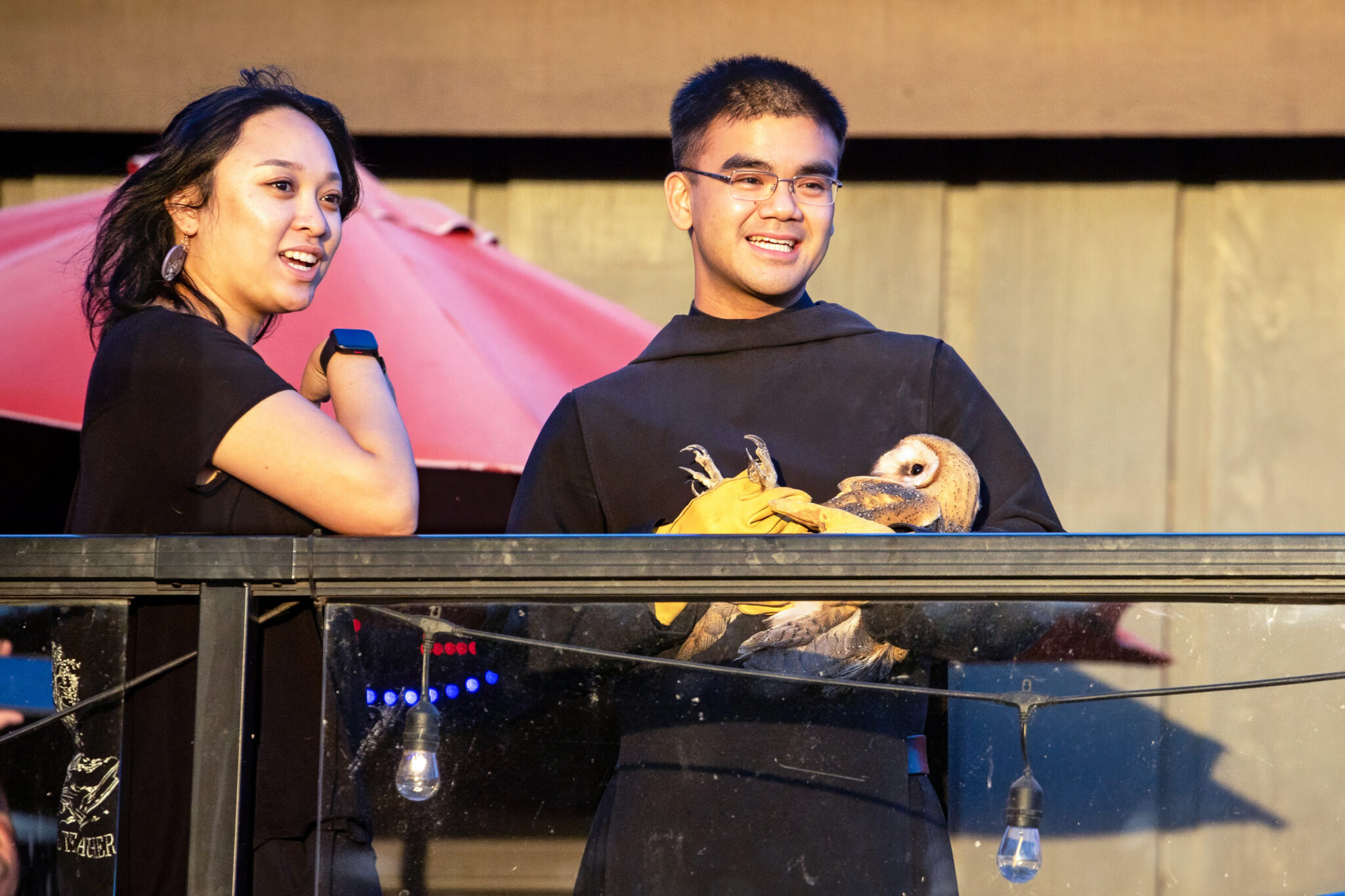
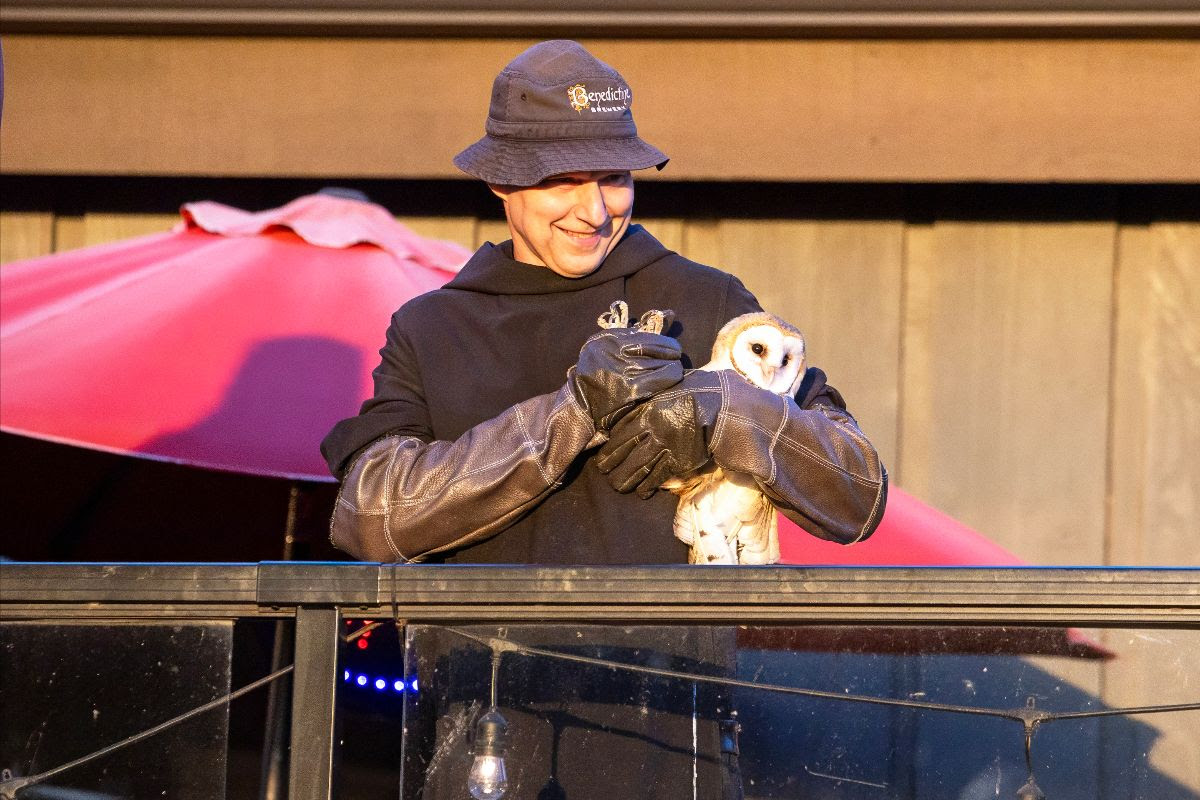
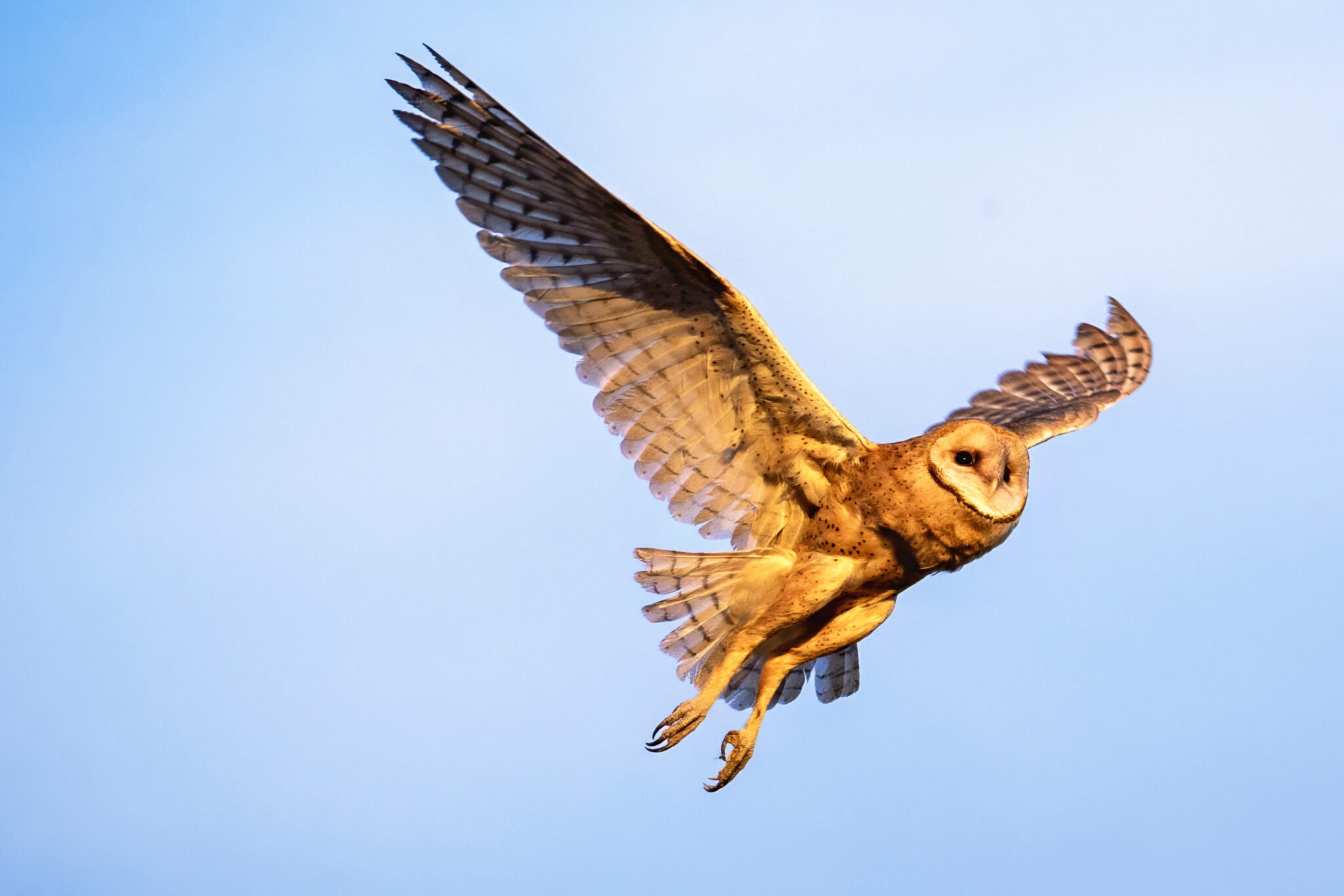
Oblate Calendar
2025
November
7-9 – Oblate Retreat: Abbot Peter
9 – Oblate Sunday: Br. Thomas. The Psalms, Part II.
December
8 – Solemnity of the Immaculate Conception (plenary indulgence may be obtained by oblates)
14 – Oblate Sunday: Br. Thomas. The Psalms, Part III2026
Jan
11 – Oblate Sunday: Br. Thomas. The Psalms, Part IV.
15 – Feast of St. Maurus and Placid (plenary indulgence may be obtained by oblates)
Feb
6-8 – Oblate Retreat. Br. Louis. Lectio Divina on the Prodigal Son.
8 – Oblate Sunday
10 – St. Scholastica (plenary indulgence may be obtained by oblates)
18 – Ash Wednesday
March
8 – Oblate Sunday
9 – St. Frances of Rome (plenary indulgence may be obtained by oblates)
21 – Passing of St. Benedict (plenary indulgence may be obtained by oblates)
31 – Easter Sunday
April
12 – Oblate Sunday
May
15-17 – Oblate Retreat. Fr. Anselm. On the Most Holy Rosary.
June
14 – Oblate Sunday
18-21 – Oblate Study Days
21 – Oblate Picnic
July
11 – St. Benedict Festival
11 – Solemnity of St. Benedict (plenary indulgence may be obtained by oblates)
Aug
9 – Oblate Sunday –
Sept
13 – Oblate Sunday –
18-20 – Oblate Retreat. Fr. Ephrem.
29 – Solemnity of Archangels (plenary indulgence may be obtained by oblates)
Oct
Nov
6-8 – Oblate Retreat. Fr. Michael
8 – Oblate Sunday
Dec
8 – Immaculate Conception (plenary indulgence may be obtained by oblates)
13 – Oblate Sunday-
A Note to Our Dear Oblates - September 27, 2025
A Note to Our Dear Oblates
September 27, 2025Dear Oblates,
The 7 Rich Ways
Rich Ways of Deep ReadingSaint Benedict in chapter 48 of the holy rule writes that monks “are to occupy themselves in the labor of their hands and at other times in holy reading.” The Latin for holy reading is lectione divina, from which we derived the well known phrase of lectio divina, meaning holy or sacred reading. This commitment to reading by Saint Benedict’s monks was a path to God and a means of encountering Him. If the whole of their life of the monk is centered on Christ, then clearly holy reading played a pivotal role in making that a reality.
Lectio divina, or deep reading in the common language, is really a slow and prayerful reading of the word of God or even other texts. Through this practice of deep reading, the monk is opening himself up to God’s word and allowing God to transform his soul through that word. Deep reading is quite different from the type of reading we are used to. Most of us are familiar with speed reading and scanning headlines. If time is money, then I shouldn’t waste my time reading deeply but should scan to obtain the information I need. This mode of reading is analogous to gorging down our food. We hardly chew our food, and we don’t ourselves allow ourselves to savor the flavor. As a result our experience of eating is quite negative and we experience indigestion. So too with our reading. We do not allow a moving phrase to last within our hearts but simply go on to the next sentence. As a result we experience mental indigestion, that is, we have so many words clogged up within us that we are unable to think.
The monastic tradition hearkens us to read contrarily to the world’s way. This tradition tells us that we are to take the sacred text one word at a time, savoring every phrase and stopping when a word speaks to our heart. By doing so we are allowing God’s word to penetrate deep into our soul. We are to savor and ruminate over the word of God, allowing all its flavor and nutrients to be absorbed by our souls.
This is the deep reading that we hope to share with the world, especially our oblates. I hope and pray that you can make this ancient monastic practice a modern one by incorporating it into your life.
Prayer request. Please pray for the success of the Fellowship of Scholars retreat next week. We have renowned theologians gathered from around the world for this event. Of note are two high ranking Vatican officials, Msgr. Piero Coda (Secretary General of the International Theological Commission) and Cardinal Mario Grech (Secretary General of the Vatican’s Synod of Bishops). Also, next week Cardinal Arthur Roche (prefect of the Dicastery for Divine Worship and the Discipline of the Sacraments) will be visiting us. Please know that you can always send your prayer requests through our Oremus program.Happy early feast of the Archangels!
Yours in Christ,Fr. John Paul, OSB
Director of Oblates
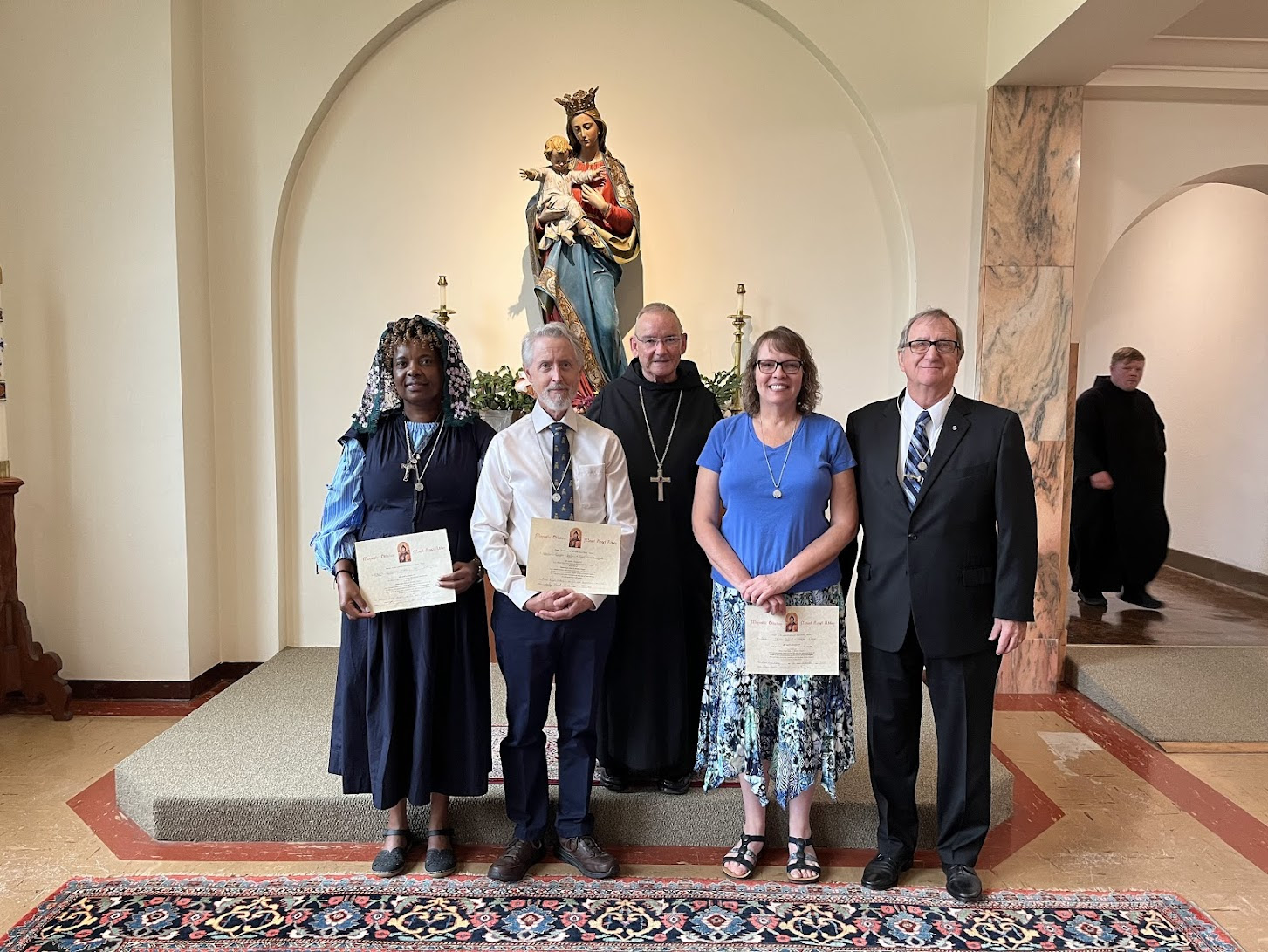
4 new Oblates.
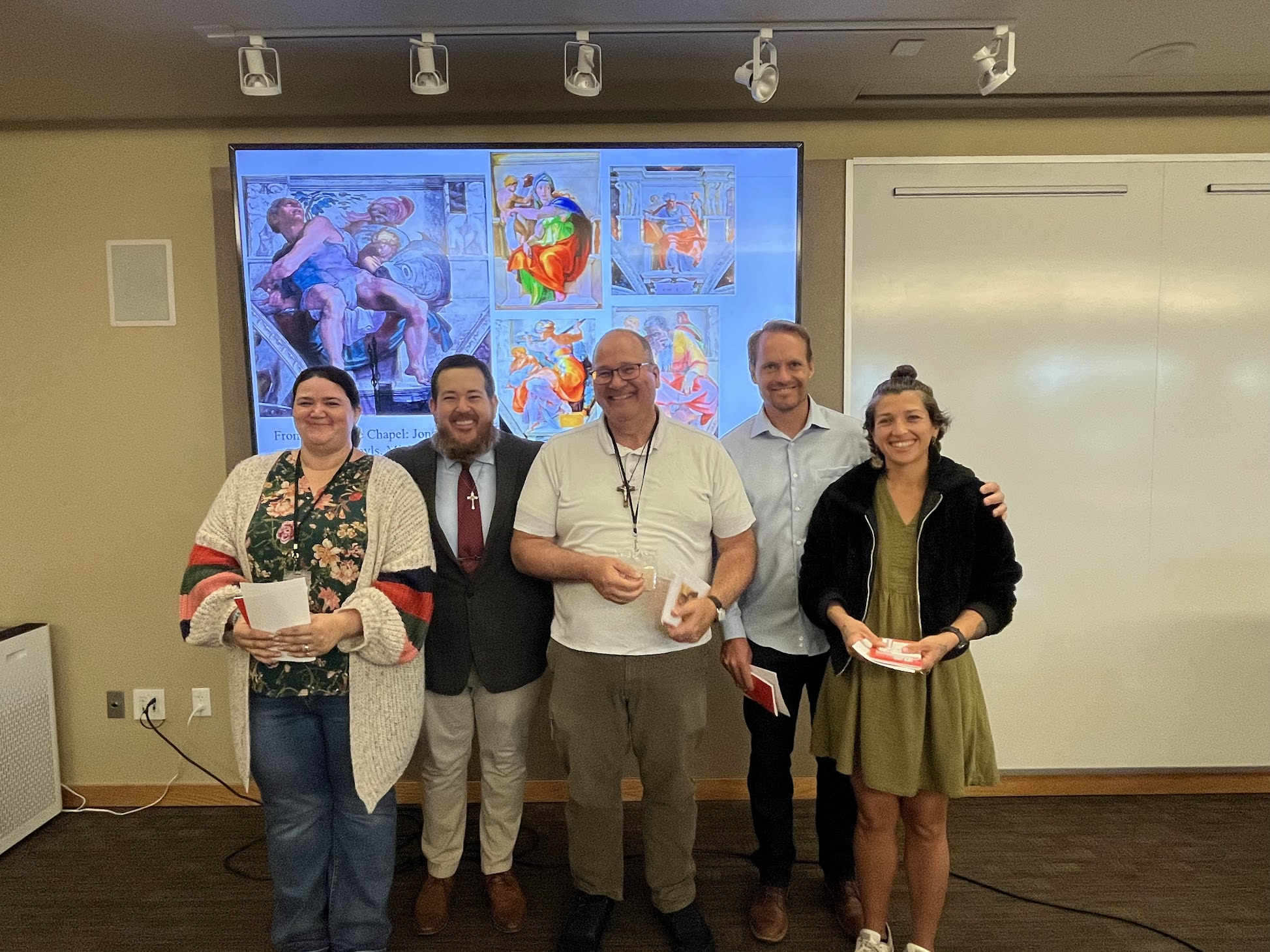
5 new novices.
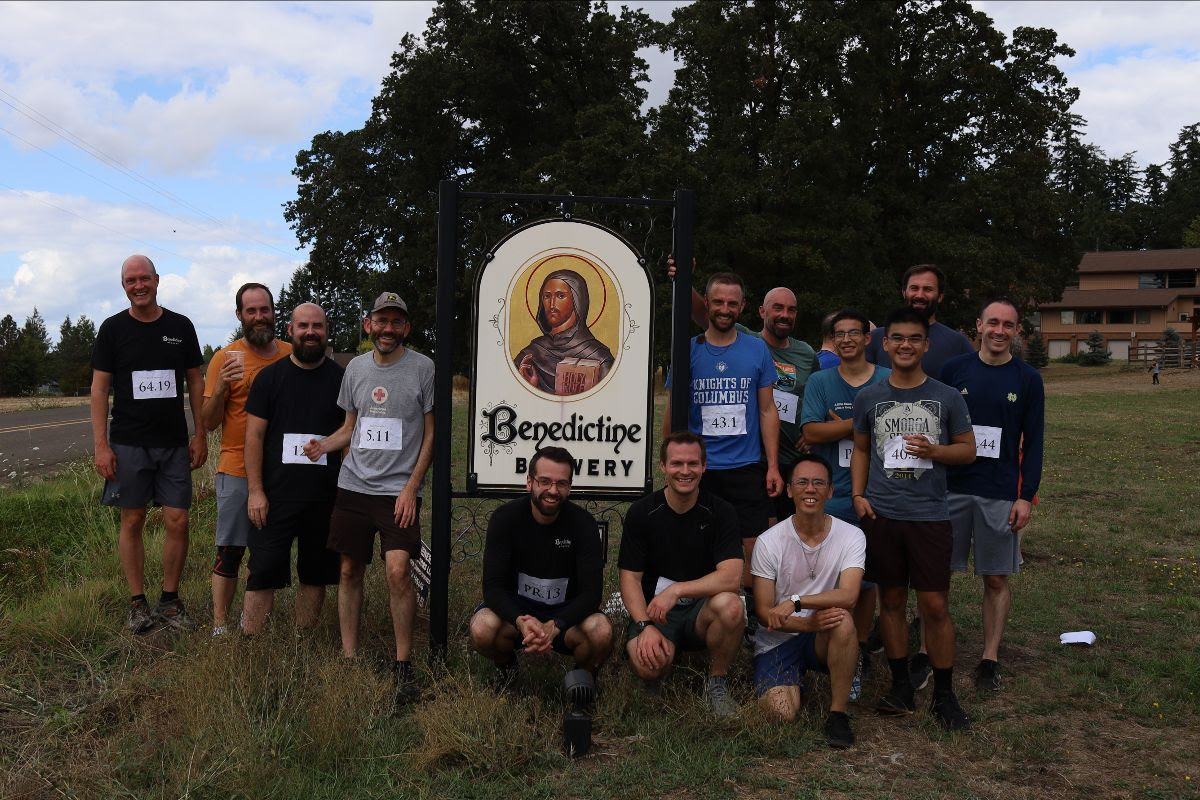
Annual monastic 5K run.
Oblate Calendar
2025
September
29 – Solemnity of Archangels (plenary indulgence may be obtained by oblates).
October
November
7-9 – Oblate Retreat: Abbot Peter
9 – Oblate Sunday: Br. Thomas. The Psalms, Part II.
December
8 – Solemnity of the Immaculate Conception (plenary indulgence may be obtained by oblates)
14 – Oblate Sunday: Br. Thomas. The Psalms, Part III2026
Jan
11 – Oblate Sunday: Br. Thomas. The Psalms, Part IV.
15 – Feast of St. Maurus and Placid (plenary indulgence may be obtained by oblates)
Feb
6-8 – Oblate Retreat. Br. Louis. Lectio Divina on the Prodigal Son.
8 – Oblate Sunday
10 – St. Scholastica (plenary indulgence may be obtained by oblates)
18 – Ash Wednesday
March
8 – Oblate Sunday
9 – St. Frances of Rome (plenary indulgence may be obtained by oblates)
21 – Passing of St. Benedict (plenary indulgence may be obtained by oblates)
31 – Easter Sunday
April
12 – Oblate Sunday
May
15-17 – Oblate Retreat. Fr. Anselm. On the Most Holy Rosary.
June
14 – Oblate Sunday
18-21 – Oblate Study Days
21 – Oblate Picnic
July
11 – St. Benedict Festival
11 – Solemnity of St. Benedict (plenary indulgence may be obtained by oblates)
Aug
9 – Oblate Sunday –
Sept
13 – Oblate Sunday –
18-20 – Oblate Retreat. Fr. Ephrem.
29 – Solemnity of Archangels (plenary indulgence may be obtained by oblates)
Oct
Nov
6-8 – Oblate Retreat. Fr. Michael
8 – Oblate Sunday
Dec
8 – Immaculate Conception (plenary indulgence may be obtained by oblates)
13 – Oblate Sunday-
A Note to Our Dear Oblates - September 20, 2025
A Note to Our Dear Oblates
September 20, 2025Dear Oblates,
The qualities of the Abbot (RB chapter 2)Although Saint Benedict only has two chapters dedicated specifically to the Abbot, Abbot Jeremy reminds us monks that the Abbot is virtually on every page of the holy rule. Indeed, everything rests on the shoulders of the Abbot, and for that reason, Saint Benedict speaks of “difficult and demanding burden” of being the Abbot (2:31). But what is the monk’s relationship to the Abbot? In the first paragraph of the chapter, Saint Benedict says two things I would like to note. The first is that the Abbot “is believed to hold the place of Christ,” and this takes an act of faith, for the Abbot is simply a man among men. We can easily find a fault in his character and choices and be tempted to see things only from an earthly perspective. Saint Benedict, following Saint Paul, reminds us that all authority comes from God (Rm 13:1). Therefore, we believe that God speaks and acts through the Abbot, and obedience to the Abbot or figures of authority is obedience to Christ. This teaching can prove challenging when our experience of authority can often times be negative. Did not Lord Acton say, “power tends to corrupt and absolute power corrupts absolutely”? However, we know that even through figures such as Pontius Pilate, God can accomplish his will in ways we will never be able to fathom. Even a great Abbot is still imperfect, so we can do our part to see the world with spiritual eyes, to truly believe that God acts and speaks still through those in authority. When we find this challenging, we can ask for a deepening of faith.
The second point of note is that Saint Benedict says that, everything that the Abbot teaches should “like the leaven of divine justice permeate the minds of his disciples.” The Abbot as father is entrusted with a teaching office within the monastery. He, who has been transformed by the word of God, is called to transform his disciples through his words, and example too. One of the main teachings of Abbot Jeremy in recent years since the establishment of the Mount Angel Institute is the seven rich ways. I’m sure you have already heard about these, but can we not deepen our own understanding and practice of these rich ways. These rich ways are simply monastic values that we hope to share with the world. I think of you oblates in particular, since you are the hands and feet of the monastery and bring the monastic spirit into the world. Therefore, I would like to dedicate the next 7 notes specifically to the theme of the seven rich ways, taking one rich way per note. In doing so, I hope that your own life may be enriched by these ancient monastic values and practices.
Prayer request. Please pray for the oblates who are here on retreat this weekend; pray especially for the four who will be making final oblation on Sunday. Please know that you can always send your prayer requests through our Oremus program.Yours in Christ,
Fr. John Paul, OSB
Director of Oblates

Fr. Michael Shrum with his parents, brother, and Abbot Jeremy.
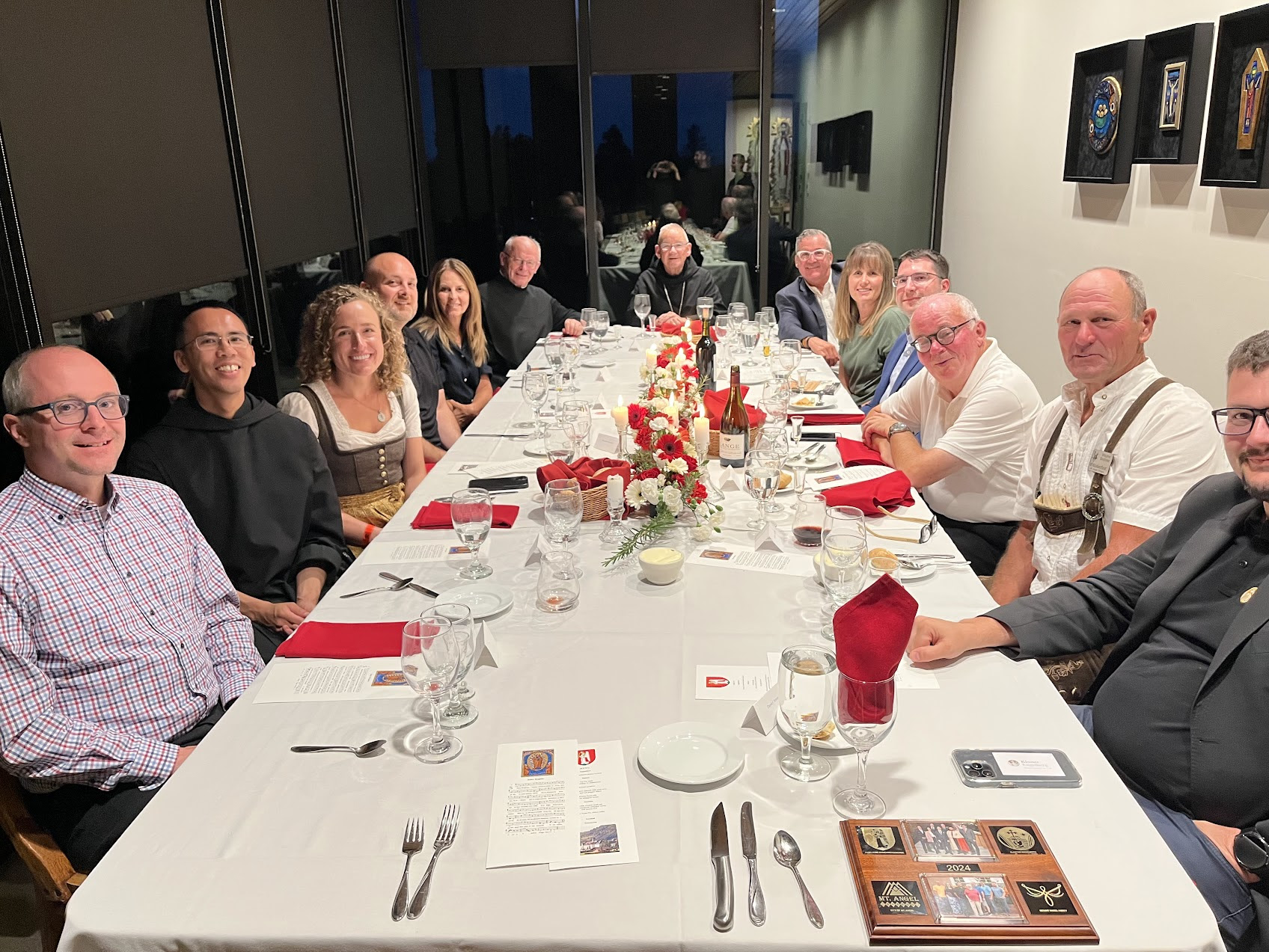
Dinner in the Abbot’s Dining room with the mayor of Engelberg (blue coat on the right) and the mayor of Mt. Angel (4th from the left).
Oblate Calendar
2025
September
19-21 – Oblate Retreat: Br. Thomas. From Head to Tail: Life and Death in the Book of Jonah.
29 – Solemnity of Archangels (plenary indulgence may be obtained by oblates).
October
November
7-9 – Oblate Retreat: Abbot Peter
9 – Oblate Sunday: Br. Thomas. The Psalms, Part II.
December
8 – Solemnity of the Immaculate Conception (plenary indulgence may be obtained by oblates)
14 – Oblate Sunday: Br. Thomas. The Psalms, Part III2026
Jan
11 – Oblate Sunday: Br. Thomas. The Psalms, Part IV.
15 – Feast of St. Maurus and Placid (plenary indulgence may be obtained by oblates)
Feb
6-8 – Oblate Retreat. Br. Louis. Lectio Divina on the Prodigal Son.
8 – Oblate Sunday
10 – St. Scholastica (plenary indulgence may be obtained by oblates)
18 – Ash Wednesday
March
8 – Oblate Sunday
9 – St. Frances of Rome (plenary indulgence may be obtained by oblates)
21 – Passing of St. Benedict (plenary indulgence may be obtained by oblates)
31 – Easter Sunday
April
12 – Oblate Sunday
May
15-17 – Oblate Retreat. Fr. Anselm. On the Most Holy Rosary.
June
14 – Oblate Sunday
18-21 – Oblate Study Days
21 – Oblate Picnic
July
11 – St. Benedict Festival
11 – Solemnity of St. Benedict (plenary indulgence may be obtained by oblates)
Aug
9 – Oblate Sunday –
Sept
13 – Oblate Sunday –
18-20 – Oblate Retreat. Fr. Ephrem.
29 – Solemnity of Archangels (plenary indulgence may be obtained by oblates)
Oct
Nov
6-8 – Oblate Retreat. Fr. Michael
8 – Oblate Sunday
Dec
8 – Immaculate Conception (plenary indulgence may be obtained by oblates)
13 – Oblate Sunday-
A Note to Our Dear Oblates - September 12, 2025
A Note to Our Dear Oblates
September 12, 2025Dear Oblates,
The Exaltation of the Holy CrossEvery seven years or so we are privileged with being able to celebrate the feast of the Exaltation of the Holy Cross on a Sunday. This day celebrates the finding of the Holy Cross by Saint Helena and the many graces given to men by its means.
The cross is loved by us Christians because through it the Father’s love was most fully manifested and our redemption accomplished. Hence, we can sing, “dear the wood and dear the iron, weight that hung on you is dear.” The cross was also the instrument of the Son’s loving obedience to the Father. As the letter to the Philippians reads, he became “obedient to death, even death on a cross”. By dying upon the cross, Christ modeled for us his teaching of love for the Father and for one another because there is no greater love than to lay down once life for once friends.
And so while we celebrate the exaltation of the Holy Cross today, we also remember that today is a feast of God’s infinite love. Never doubt even for a moment the depth and tenderness of God’s love for you. He loves not simply your soul, but your whole being, your body, your mind and all your emotions.
Therefore, in many Catholic spaces, we hang crucifixes, but how odd it would be for the crucifix to be without the cross. It is possible that we could simply hang a corpus the wall, but instinctively, we would know that something essential was missing. Like an image of the infant Jesus without his mother leaves the soul in want, so too, the corpus without the cross, lacks the fullness of the symbol. However, we often make this mistake spiritually. We want Jesus without the cross. We say just give me the corpus and that is enough. However, as the saints and experience tells us, it is by means of our everyday crosses that we are united more fully to Jesus. By saying “fiat” to our crosses, we receive the nails that bind us to Him.
With what words can the beauty and the wonder of the cross be described. As we are at a loss of words to describe the infinite love of God, so before the cross, we gaze in silent gratitude.
Prayer request. Please pray for Fr. Michael, who will make solemn vows in a few hours. Please know that you can always send your prayer requests through our Oremus program.Yours in Christ,
Fr. John Paul, OSB
Director of Oblates
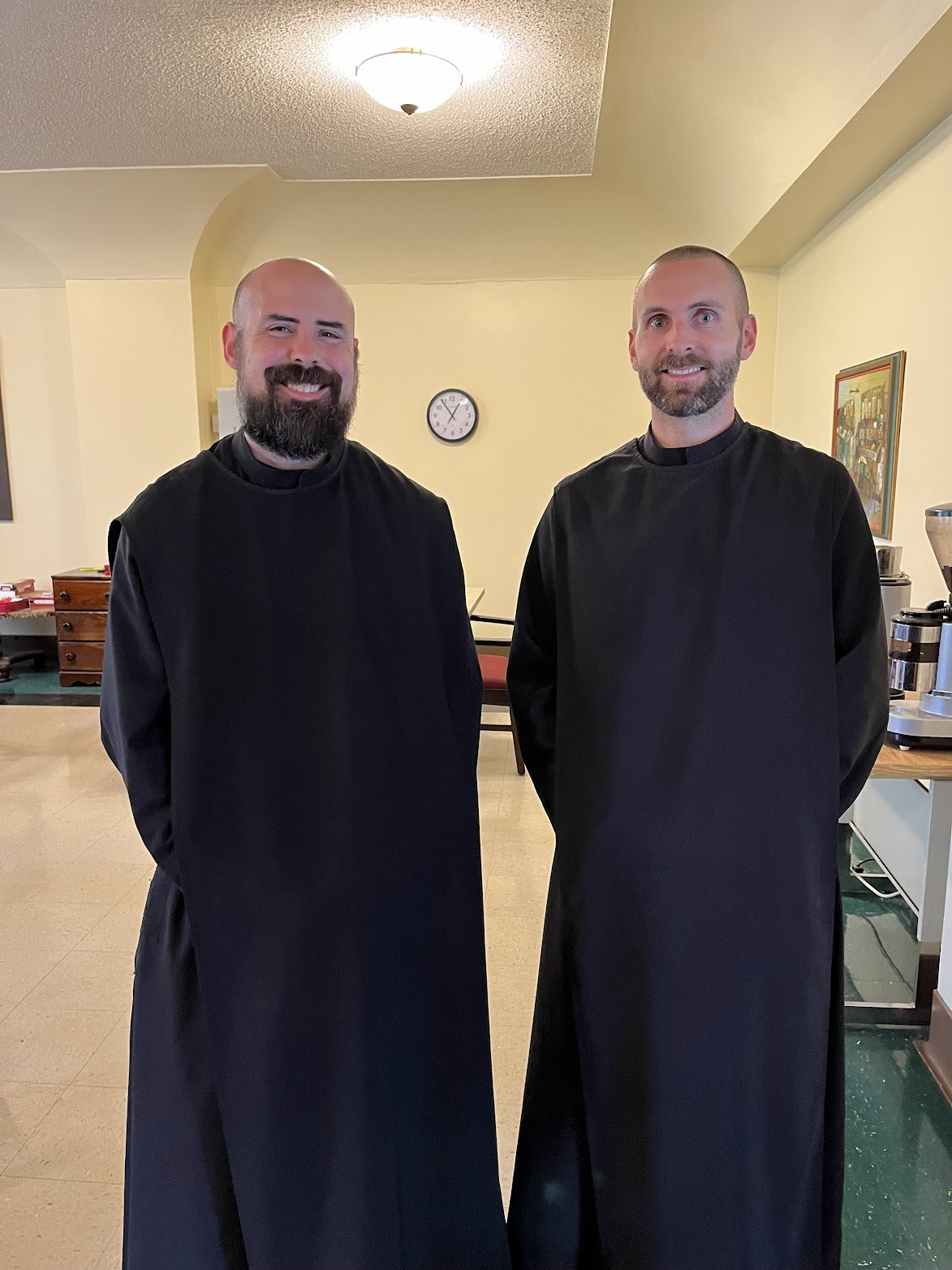
New Novices. Br. Allen and Br. Andrew.
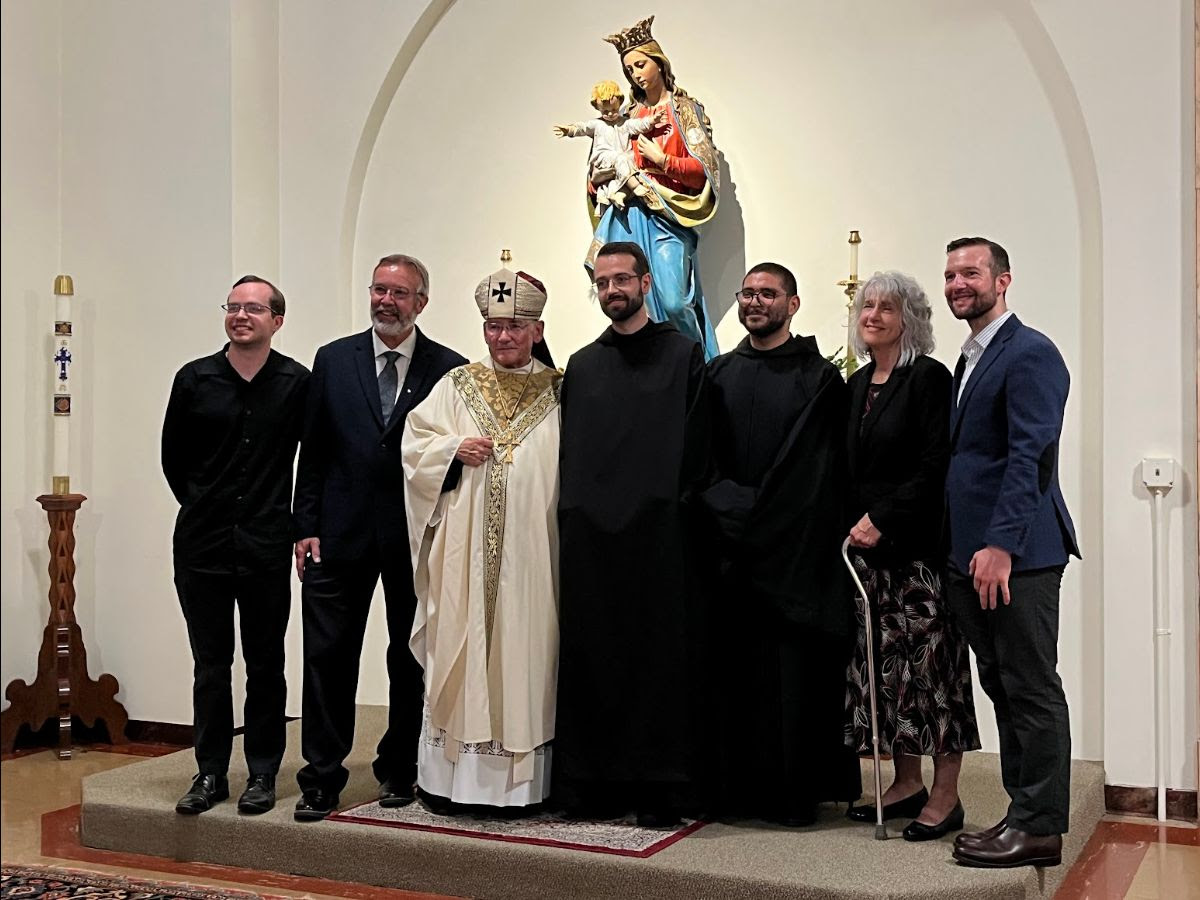
Br. Jonah with Fr. Abbot, Fr. Israel and family.
Oblate Calendar
2025
September
14 – Oblate Sunday: Br. Thomas. The Psalms, Part I.
19-21 – Oblate Retreat: Br. Thomas. From Head to Tail: Life and Death in the Book of Jonah.
29 – Solemnity of Archangels (plenary indulgence may be obtained by oblates).
October
November
7-9 – Oblate Retreat: Abbot Peter
9 – Oblate Sunday: Br. Thomas. The Psalms, Part II.
December
8 – Solemnity of the Immaculate Conception (plenary indulgence may be obtained by oblates)
14 – Oblate Sunday: Br. Thomas. The Psalms, Part III2026
Jan
11 – Oblate Sunday: Br. Thomas. The Psalms, Part IV.
15 – Feast of St. Maurus and Placid (plenary indulgence may be obtained by oblates)
Feb
6-8 – Oblate Retreat. Br. Louis. Lectio Divina on the Prodigal Son.
8 – Oblate Sunday
10 – St. Scholastica (plenary indulgence may be obtained by oblates)
18 – Ash Wednesday
March
8 – Oblate Sunday
9 – St. Frances of Rome (plenary indulgence may be obtained by oblates)
21 – Passing of St. Benedict (plenary indulgence may be obtained by oblates)
31 – Easter Sunday
April
12 – Oblate Sunday
May
15-17 – Oblate Retreat. Fr. Anselm. On the Most Holy Rosary.
June
14 – Oblate Sunday
18-21 – Oblate Study Days.
21 – Oblate Picnic
July
11 – St. Benedict Festival
11 – Solemnity of St. Benedict (plenary indulgence may be obtained by oblates)
Aug
9 – Oblate Sunday –
Sept
13 – Oblate Sunday –
18-20 – Oblate Retreat. Fr. Ephrem.
29 – Solemnity of Archangels (plenary indulgence may be obtained by oblates)
Oct
Nov
6-8 – Oblate Retreat. Fr. Michael
8 – Oblate Sunday
Dec
8 – Immaculate Conception (plenary indulgence may be obtained by oblates)
13 – Oblate Sunday-
A Note to Our Dear Oblates - September 6, 2025
A Note to Our Dear Oblates
September 6, 2025Dear Oblates,
23rd Sunday in Ordinary TimeTomorrow’s gospel reading is one of those difficult sayings of Jesus. In the gospel we hear Jesus saying, “If anyone comes to me without hating his father and mother, wife and children, brothers and sisters, and even his own life, he cannot be my disciple.” What does that mean? Is Jesus telling us to hate everybody around us, especially those we are supposed to love the most? Does not the 4th commandment say that we are to honor our father and mother? Did Jesus not teach us to love our neighbor as ourselves? Whenever we encounter these passages, it is important that we not simply dismiss them, but rather, we are to dig deeper and try to penetrate the meaning of these words. How can we penetrate these hard sayings?
The Catechism gives us three points to guide our reading of scripture (CCC 112-114). First it says, “Be especially attentive ‘to the content and unity of the whole Scripture’”(CCC #112). As Catholics, we do not simply take a scriptural verse and run with it. This can actually be quite dangerous. As the saying goes, “when we take a text out of context we use it as a pretext.” There is always the temptation of using the scripture to justify what we already believe rather than being formed by the scriptures. Second, the Catechism says, “Read the Scripture within ‘the living Tradition of the whole Church’” (CCC #113). What have the Church Fathers written about these verses? What have the popes and bishops written about these passages? How did the saints proclaim the text with their words and their lives? All these are reliable modes of interpretation, and we are safe in following their train of thought. Lastly, the Catechism says, “Be attentive to the analogy of faith. By analogy of faith we mean the coherence of the truths of faith among themselves and within the whole plan of Revelation” (CCC #114). We do not read scripture in an isolated box, but we read it with the light of faith. Therefore, the sacred scriptures are to be read in harmony with the faith, namely, everything that is professed in the creed. This gives us clear guidelines protecting us from errant interpretations of the scriptures.
This note doesn’t give you too much to think about in terms of spiritual reflection on the gospel reading, but perhaps, it will encourage you delve into it yourself as you struggle with these words of the Lord. This is the interesting thing about the scriptures. They are always challenging us to deepen our understanding and our faith, and sometimes it is more about the journey than the end.
There is a good book that helps people do Lectio Divina on the Sunday Gospels. It is published by Magnificat. I would recommend this to anyone is trying to deepen their own experience of this ancient monastic practice.
Our next Oblate Sunday is September 14th with Br. Thomas giving the first of his four talks on the psalms. To sign up for in-person, click here; for remote option, click here.
You can now sign up for the oblate retreats for 2026. For dates and retreat masters, please click here.
Prayer request. Please pray for Fr. Israel who will begin as Novice and Junior Master on Sunday. Please also pray for Br. Townsen, who will be making his Simple Vows on Sept 8 at 7pm and for Fr. Michael, who will make his final vows on Sept 12 at 7pm. Please know that you can always send your prayer requests through our Oremus program.Yours in Christ,
Fr. John Paul, OSB
Director of Oblates
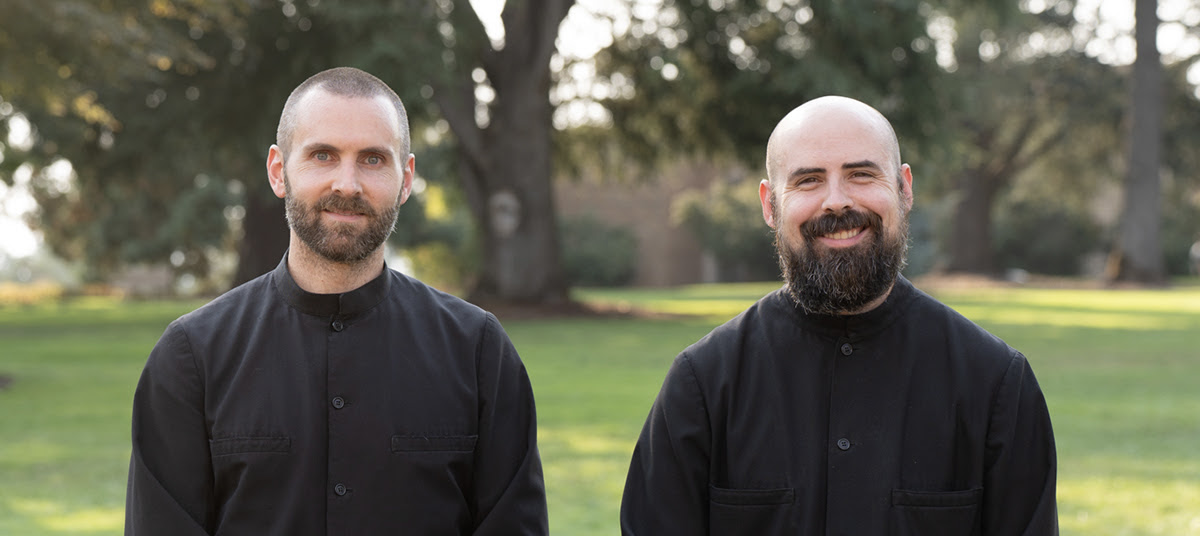
Postulants – Br. Andrew and Br. Allen. They will begin their novitiate on Sunday.
Oblate Calendar
2025
September
14 – Oblate Sunday: Br. Thomas. The Psalms, Part I.
19-21 – Oblate Retreat: Br. Thomas. From Head to Tail: Life and Death in the Book of Jonah.
29 – Solemnity of Archangels (plenary indulgence may be obtained by oblates).
October
November
7-9 – Oblate Retreat: Abbot Peter
9 – Oblate Sunday: Br. Thomas. The Psalms, Part II.
December
8 – Solemnity of the Immaculate Conception (plenary indulgence may be obtained by oblates)
14 – Oblate Sunday: Br. Thomas. The Psalms, Part III-
A Note to Our Dear Oblates - August 30, 2025
A Note to Our Dear Oblates
August 30, 2025Dear Oblates,
22nd Sunday in Ordinary Time – Who’s looking at who?In the Gospel today, we see an interesting irony. The scripture tells us that the Pharisees were observing Jesus carefully so that they might find fault with either his action or his words. By doing so, they could discredit him as being an unworthy teacher. However, as the Pharisees were observing Christ merely to judge his external actions, Christ simultaneously is observing them but at a much deeper level. The text reveals that Jesus notices “how they were choosing places of honor”. Who is watching who now? While the Pharisees’ observation was intended for hostile condemnation, Christ’s gaze was aimed at life-giving conversion.
How might this apply to us? If we see ourselves in the place of the Pharisees, we can relate to their search for the faults of others, the splinter in our neighbor’s eye. The question must then be raised, “why do we search so intensely for the faults of others?” Perhaps, it is because we are afraid to look deeply at ourselves, knowing how ugly and tainted we are. It feels much better to look at the sins of others than to look into our own souls. The Pharisee who boasted of his good deeds–fasting and tithing–would fall into this category. He did not look or examine his inner conscience, but rather, he prided himself in his external actions and condemned the repentant tax-collector. How often do we turn our eyes outward to look at the sins of others and not those of ourselves?
A second reason why we might be watching carefully for the tiniest fault in others is that we feel insignificant about ourselves. Subconsciously, we believe that putting others down will make us feel better. Father Konrad Schaefer places Zacchaeus the tax collector, who was a short man, in this category. He reads the scripture passage about Zacchaeus in a psychological context. Thus, Zacchaeus was not only small in stature, but he himself felt little and unimportant. To boost himself up, he needed to make others feel little by exerting his power to tax them. How might we belittle others to make ourselves feel important?
This undisciplined form of observation is contrasted by the gentle and compassionate gaze of Christ. He sees everything, not simply what goes on the surface, but also the hidden movements of the heart. He can read our intentions and desires and can pinpoint with absolute precision a remedy for all our ills. This is what he does with the Pharisees. He notices that they are taking places of honor at table and that the motivation behind their action was rooted in pride. Therefore, he gives them practical advice. Take the lowest place. Invite the poor and lame to your dinner table. St. Benedict says, “In every place the eyes of the Lord are watching.” (19:1). We do not need to think of the eyes of the Lord as an over-demanding coach or a critical parent. Rather, we are called to think of the eyes of Christ as tender and gentle, always loving and always hopeful.
As we go throughout this day, may we look upon the world and people around us not with the critical eyes of the Pharisees but with the loving gaze of Christ.
There is a good book out there that helps people do Lectio Divina on the Sunday Gospels. It is published by Magnificat. I would recommend this to anyone is trying to deepen their own experience of this ancient monastic practice.
Our next Oblate Sunday is September 14th with Br. Thomas giving the first of his four talks on the psalms. To sign up for in-person, click here; for remote option, click here.
Prayer request. Please pray for Brody Stewart, formerly Br. Ambrose, who left the monastery last week. Many of you have benefited from his classes, conferences and/or writings, and I am sure that he would appreciate your prayers. Please know that you can always send your prayer requests through our Oremus program.Yours in Christ,Fr. John Paul, OSB
Director of Oblates

Nearly 100 seminarians with faculty and staff.
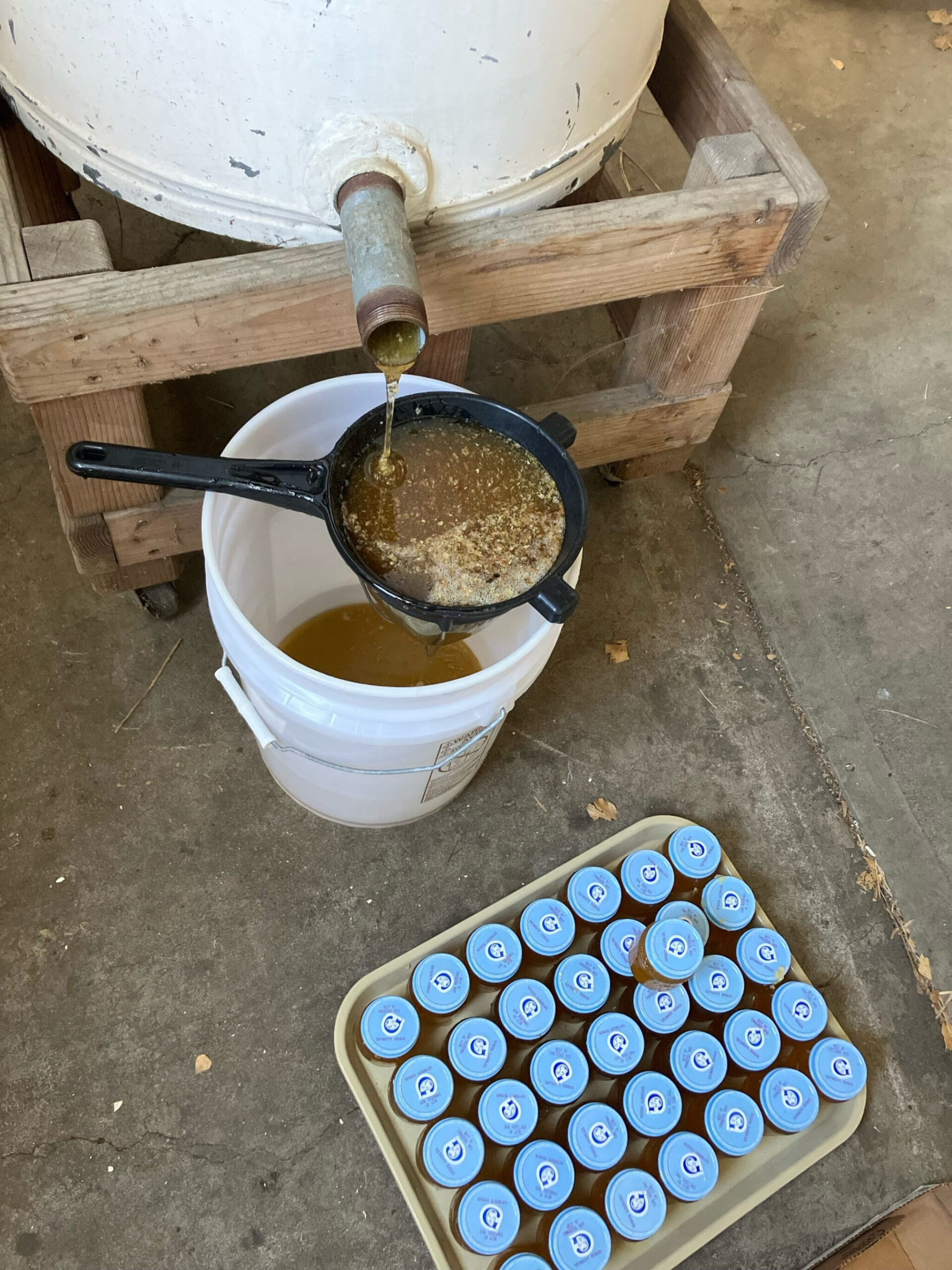
Br. Joseph’s Abbey honey. The third time’s a charm.
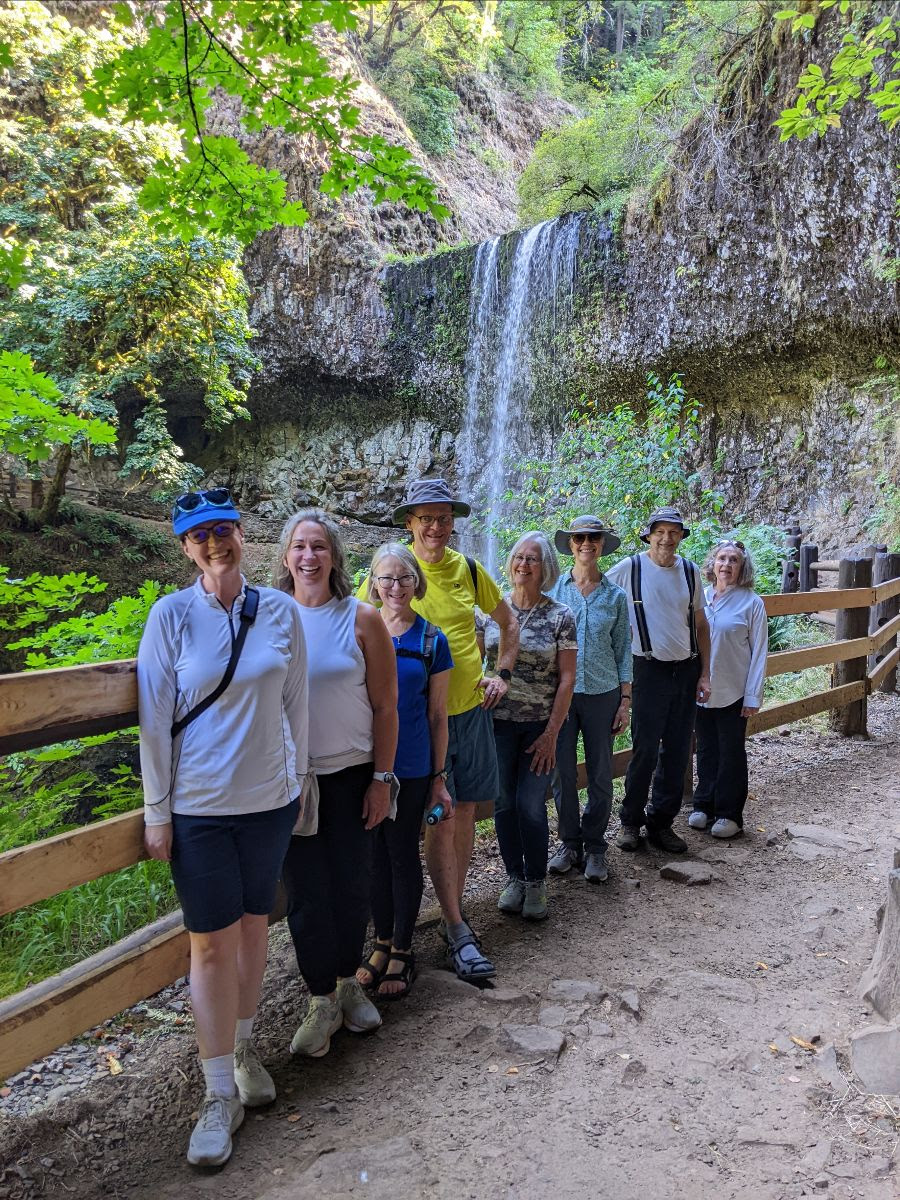
Oblate Spiritual Directors at Silver Falls. Can you spot the monk?
Oblate Calendar
2025
September
14 – Oblate Sunday: Br. Thomas. The Psalms, Part I.
19-21 – Oblate Retreat: Br. Thomas. From Head to Tail: Life and Death in the Book of Jonah.
29 – Solemnity of Archangels (plenary indulgence may be obtained by oblates).
October
November
7-9 – Oblate Retreat: Abbot Peter
9 – Oblate Sunday: Br. Thomas. The Psalms, Part II.
December
8 – Solemnity of the Immaculate Conception (plenary indulgence may be obtained by oblates)
14 – Oblate Sunday: Br. Thomas. The Psalms, Part III-
A Note to Our Dear Oblates - August 23, 2025
A Note to Our Dear Oblates
August 23, 2025Dear Oblates,
Oblate Pilgrimage – Concluding thoughts, and miscellaneous adventuresI would like to use this note to simply give some concluding thoughts on the pilgrimage and share some photos of significant side trips that we made. Going on pilgrimage was like an amalgamation of life’s journey. There were the ups and downs, the twists and turns, and the crosses and graces that entail every journey. However, the key was to simply persevere and keep one foot in front of the other, and eventually we arrive at our final destination. There are a few things that come to mind when I think of this pilgrimage. The first is that prayer was the bedrock upon which our pilgrimage was built. We had Mass every day at the various holy sites that we visited, and we frequently prayed the rosary or the Liturgy of the Hours together. God’s presence and the presence of the saints was quite tangible. The second point was that we did everything together as a group. One oblate mentioned that she went on pilgrimage last year to the same sites but went alone. Going on pilgrimage with others, she experienced so many more blessings. This echoes what Saint Benedict says in chapter 72 to the holy rule, where he writes, “together unto everlasting life.” Indeed, the fraternity and fellowship we shared with one another was one of the greatest blessings of being on pilgrimage. Lastly, we had to constantly adapt to the circumstances and change and revise the schedule. After the second day, I had to resign to the fact that I was not in charge. God was taking the reins, and everything would work out according to his will. Therefore, whether you go on pilgrimage or not, let us remember those three points: stability in prayer, doing things together and surrendering ourselves to the will of God.
Our next Oblate Sunday is September 14th with Br. Thomas giving the first of his four talks on the psalms. To sign up for in-person, click here; for remote option, click here.
Prayer request. Please pray for the seminarians, faculty and staff as we start the new school year on Monday. Please know that you can always send your prayer requests through our Oremus program.Yours in Christ,Fr. John Paul, OSB
Director of Oblates
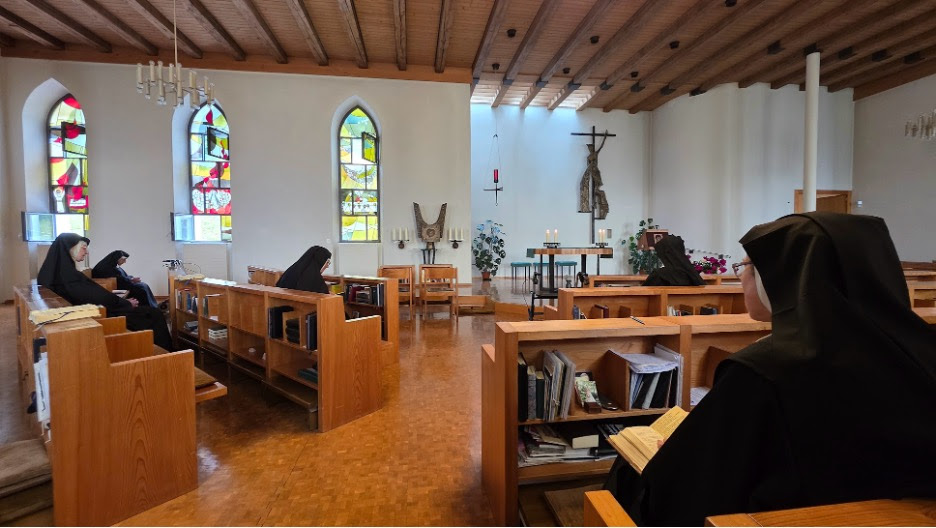
At the convent of Maria Rickenbach. This is the motherhouse of the Queen of Angels monastery in Mt. Angel. Unfortunately, like many convents and monasteries in Europe, they are on the decline and only have around 8 sisters. The convent is only accessible via a cable cart.
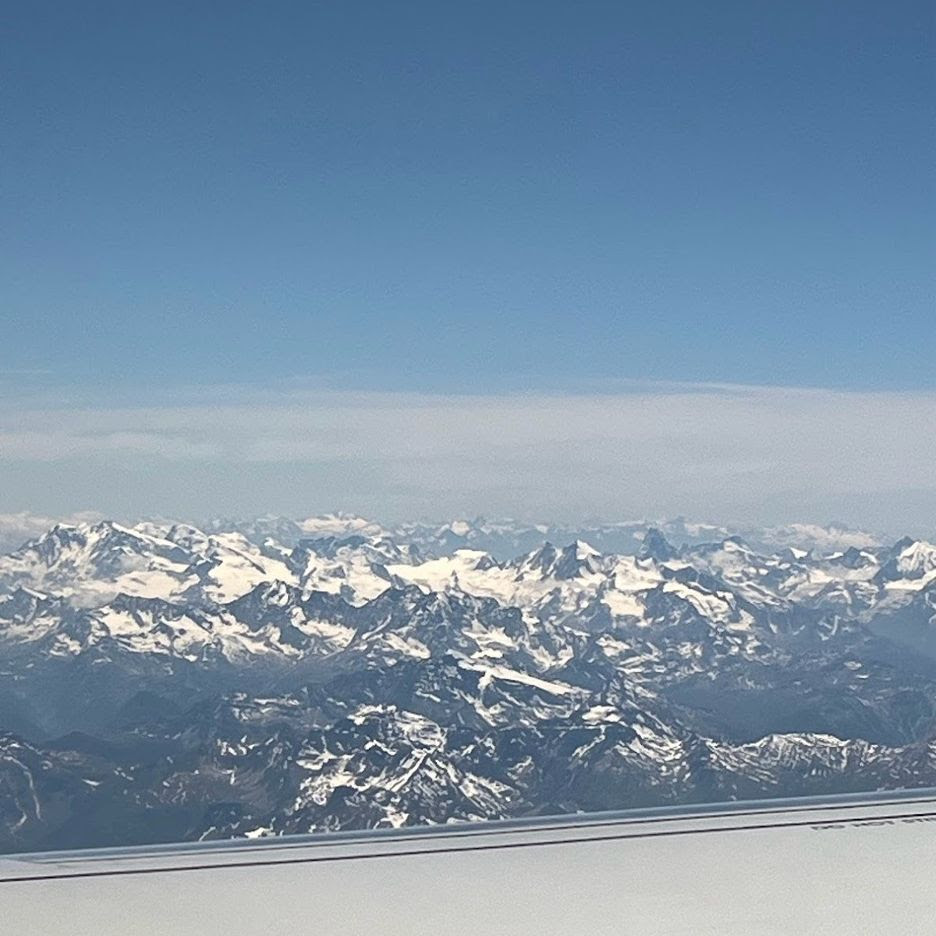
Flying over the Swiss Alps en route to Rome.
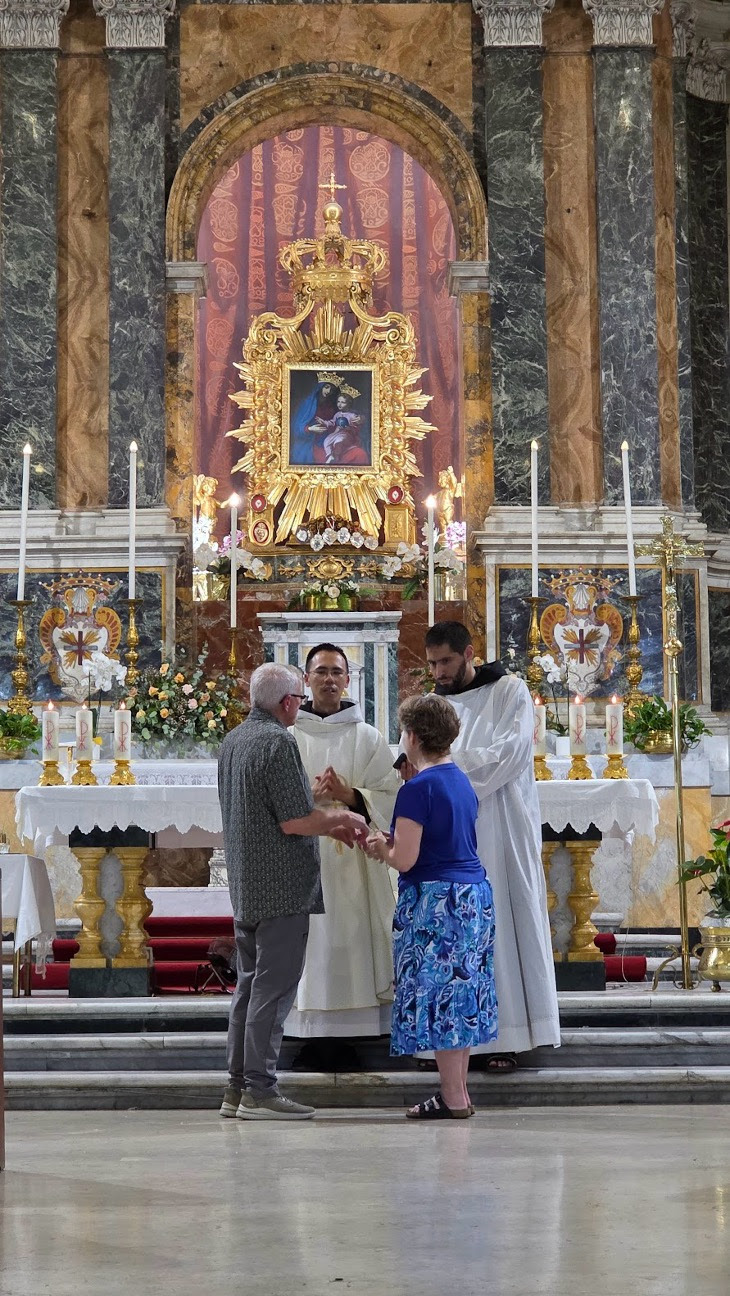
Steve and Suzanne Nickel renewing their marriage vows on the feast of St. John the Baptist at Santa Maria alle Fornaci in Rome.
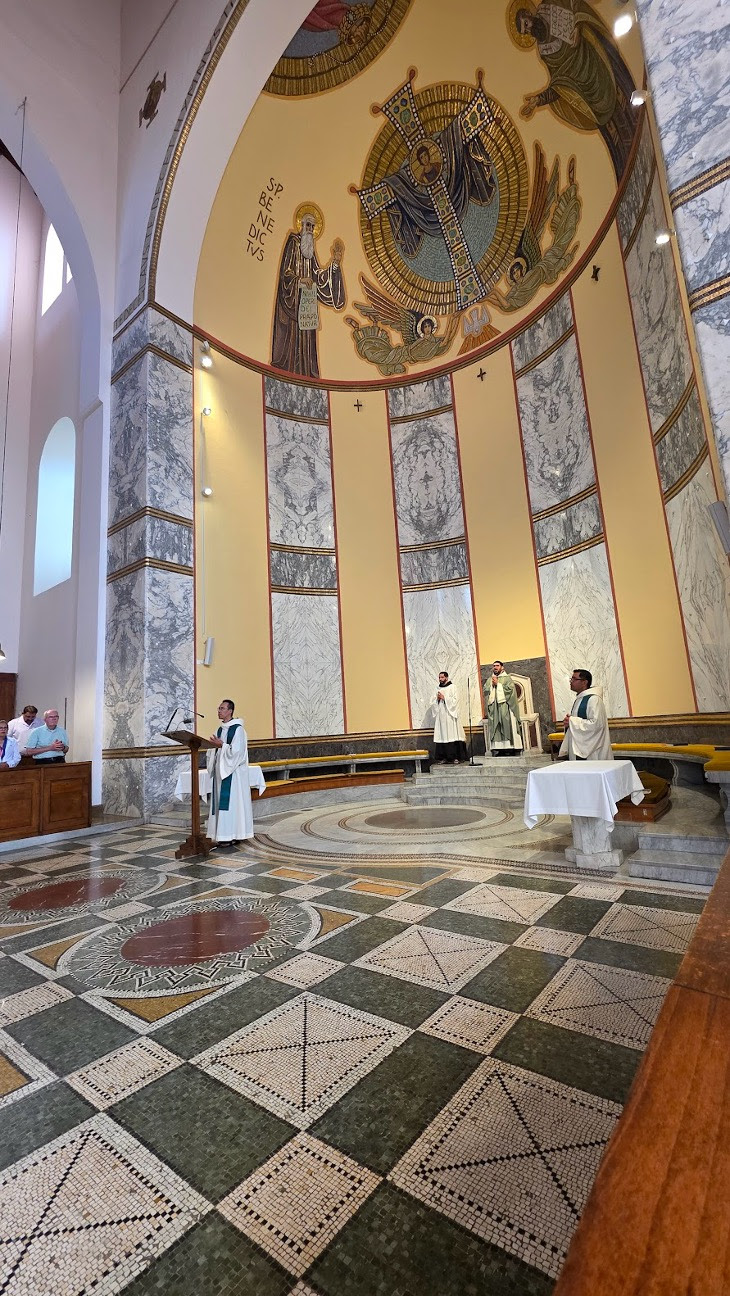
Fr. Israel celebrating Mass at Sant’Anselmo in Rome.
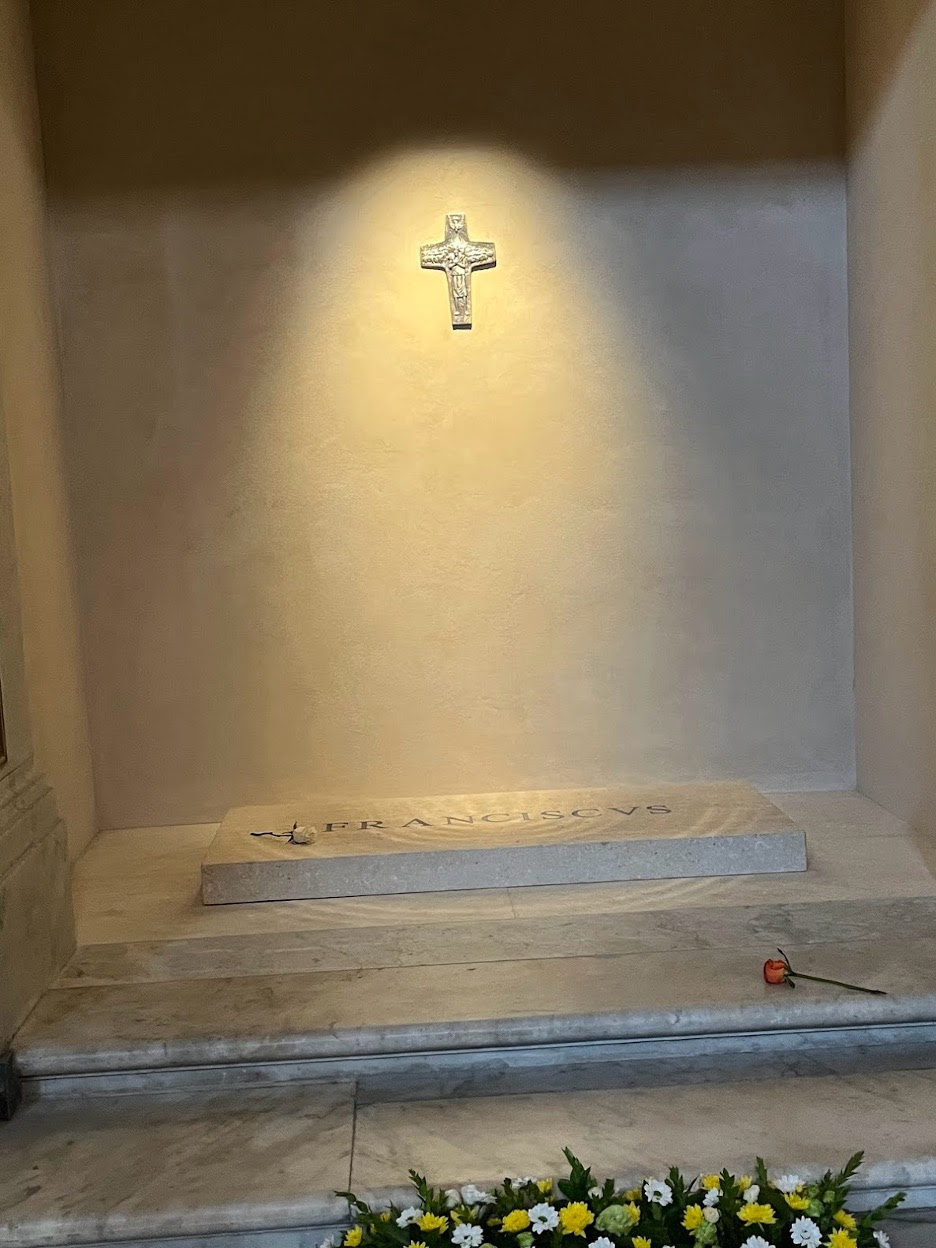
The tomb of Pope Francis at St. Mary Major. It was surprising not to see him in Rome, since we had anticipated a papal audience with him for over a year. May he rest in peace.
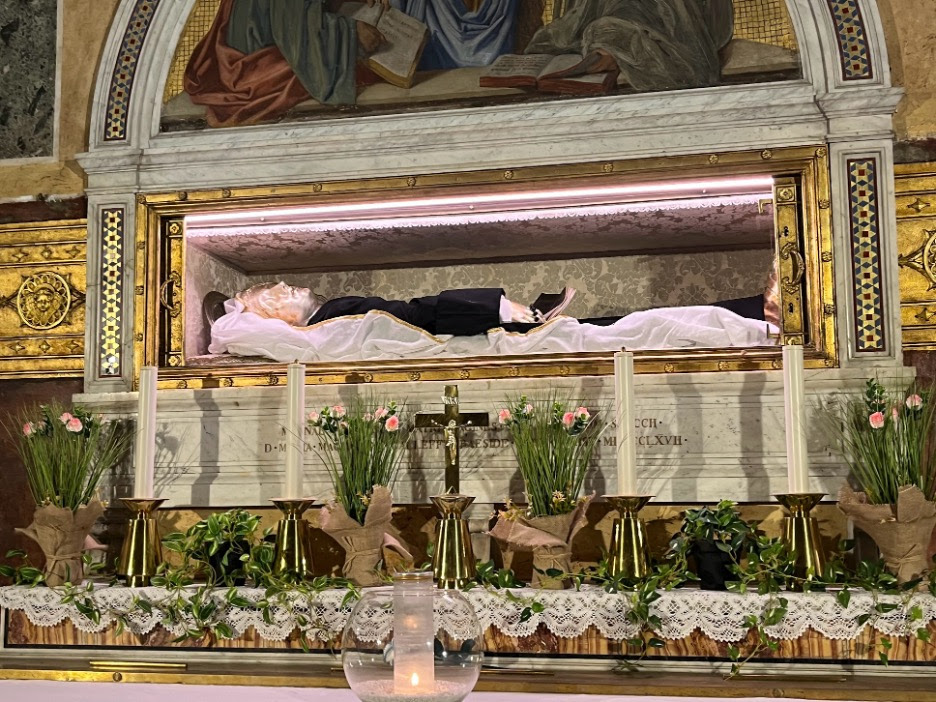
During the free afternoon on Friday in Rome, some of the pilgrims visited the tomb of St. Frances of Rome at the basilica that bears her name. On the marble are the letters “OBL”, aka, Oblate of St. Benedict.
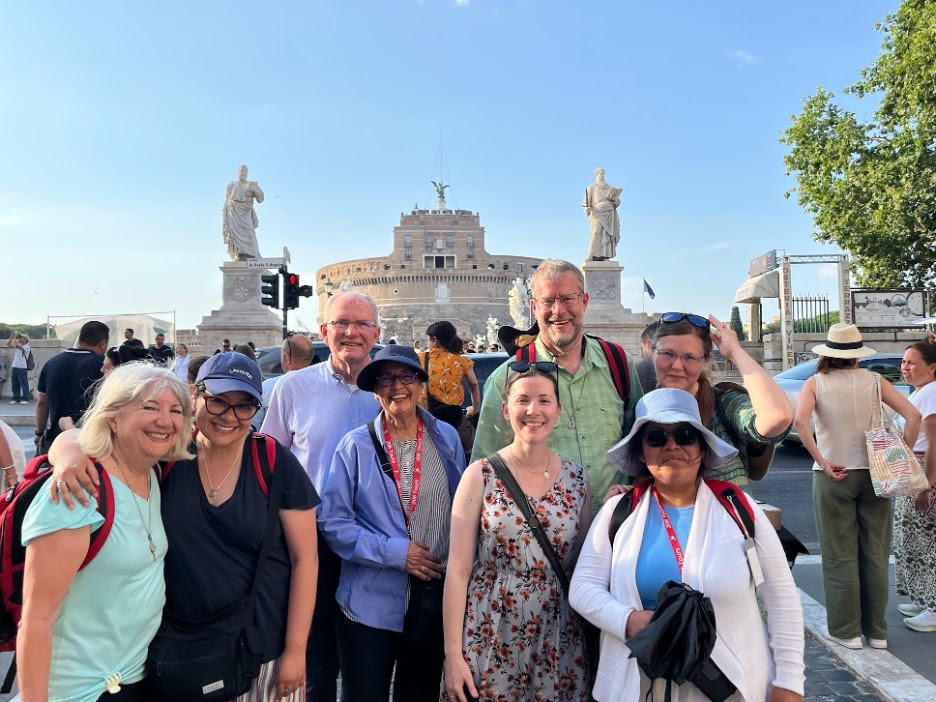
At the bridge of the angels with Castel Sant’ Angelo in the background. Each of the angels bear an instrument of the Lord’s passion.
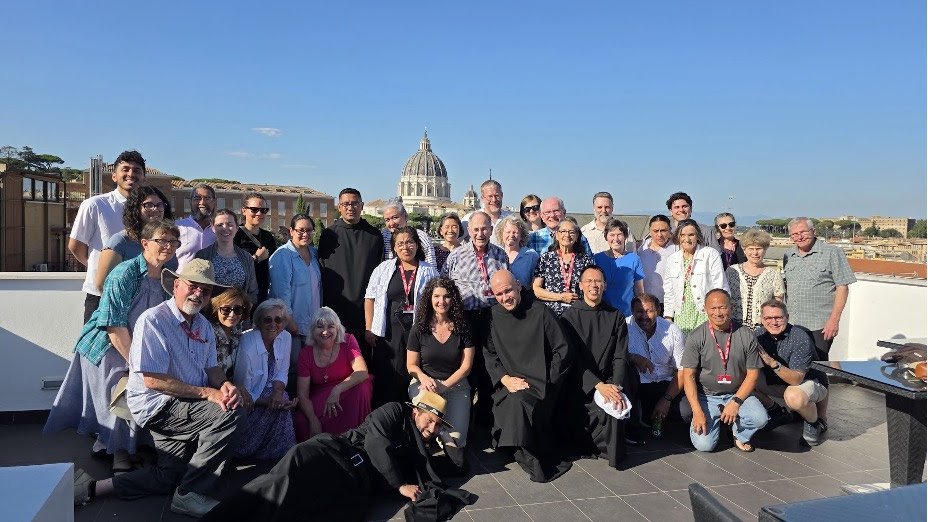
Group on the top of our hotel roof with St. Peter’s dome in the background.
Oblate Calendar
2025
August
27 – Oblate Day of Prayer
September
14 – Oblate Sunday: Br. Thomas. The Psalms, Part I.
19-21 – Oblate Retreat: Br. Thomas. From Head to Tail: Life and Death in the Book of Jonah.
29 – Solemnity of Archangels (plenary indulgence may be obtained by oblates).
October
November
7-9 – Oblate Retreat: Abbot Peter
9 – Oblate Sunday: Br. Thomas. The Psalms, Part II.
December
8 – Solemnity of the Immaculate Conception (plenary indulgence may be obtained by oblates)
14 – Oblate Sunday: Br. Thomas. The Psalms, Part III-
A Note to Our Dear Oblates - August 16, 2025
A Note to Our Dear Oblates
August 16, 2025Dear Oblates,
Oblate Pilgrimage – MontecassinoOn the last day of our pilgrimage, on the solemnity of Sts. Peter and Paul, we visited the historic monastery of Monte Cassino Abbey, which was founded by St. Benedict in 529. He remained at Monte Cassino until his death in about 547. Throughout its history, it experienced great trials. The monastery was sacked by Lombards in 580 and was sacked a second time in 884 by Saracens. In the 11th and 12th centuries, the Abbey acquired a large territory around Monte Cassino, which was fortified with castles. In 1799, Monte Cassino was sacked again by French troops during the Revolution, and during World War II, it was bombed by the German military. Soon afterwards it was rebuilt, and in 1964 Pope Paul VI rededicated the monastery. Two things stand out when one visits Monte Casino. The first is that it is set on a lovely mountaintop with a 360-degree view of the valley. The second is that the monastery is enormous; unfortunately, there are only about 10 monks residing there. However, it is also the resting place of St. Benedict and St. Scholastica, and this was the main reason for our visit.
Prayer request. Please pray for the faculty retreat next week and for the new seminarians who will be arriving. The new school year is just a week away. Please know that you can always send your prayer requests through our Oremus program.Yours in Christ,Fr. John Paul, OSB
Director of Oblates

Monte Cassino after WWII bombing. Photo from Wikimedia Commons.
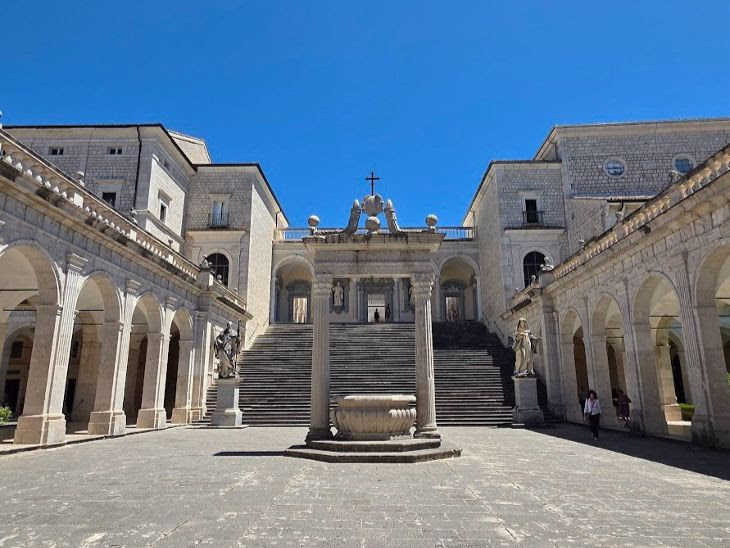
Rebuilt courtyard leading to Abbey Church.
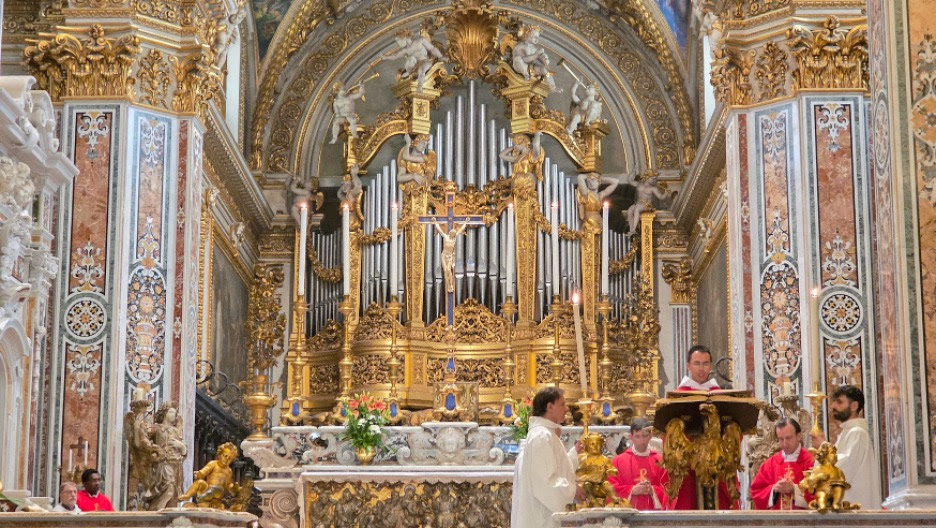
Community High Mass with monks on the solemnity of Sts. Peter and Paul. The gospel was proclaimed in Italian and English.
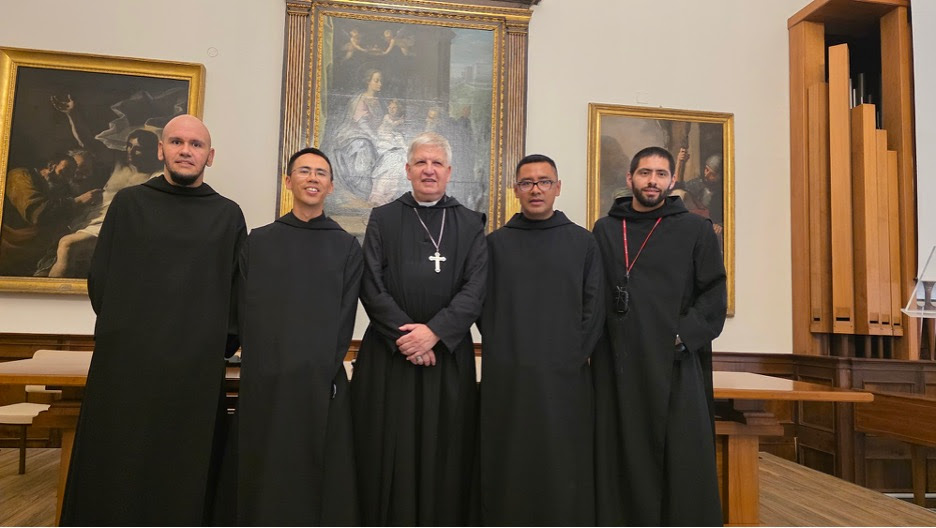
Abbot Antonio Luca with the Mount Angel monks. His receiving us was not in the itinerary, so we were pleasantly surprised that he took the time to greet us.
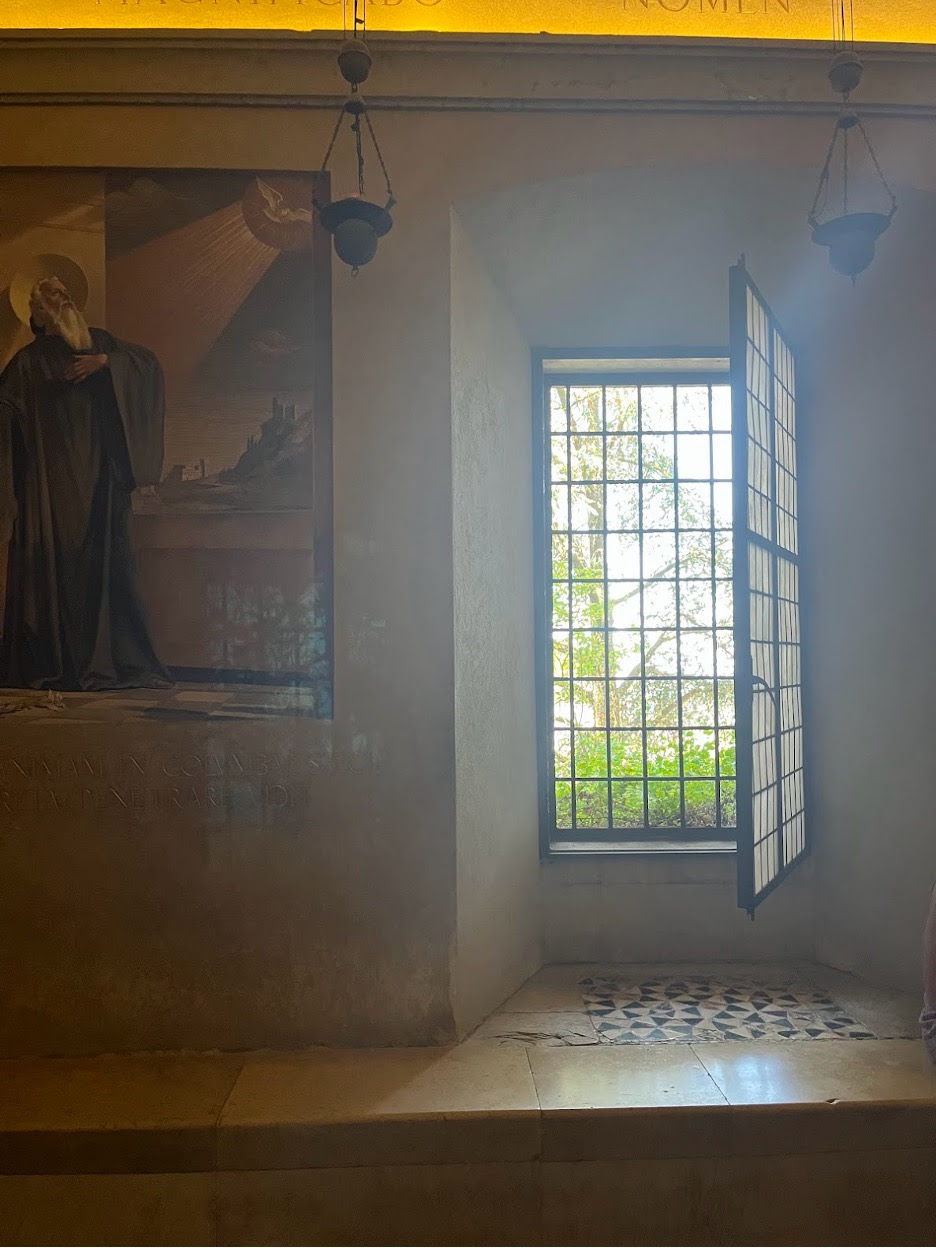
Window in the cell of St. Benedict. This is where he saw the soul of his sister St. Scholastica rise to heaven in the form of a dove. Some of us actually saw a few doves flying around.
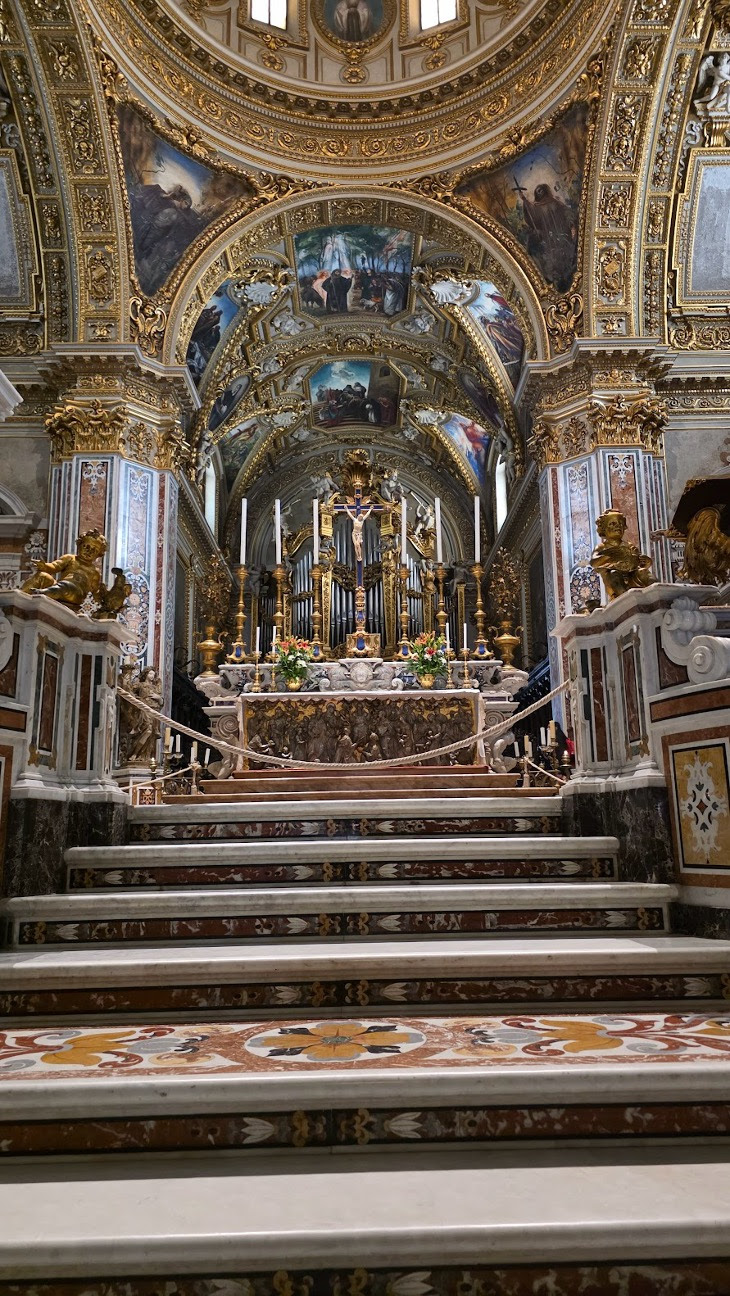
Main altar in the Abbey church.
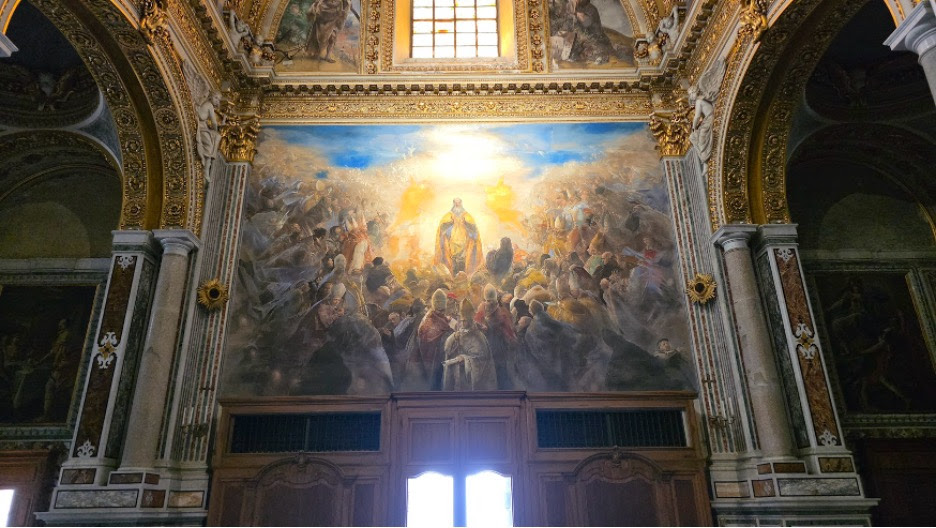
The Glory of St. Benedict by Pietro Annigoni (he’s on the bottom right of the painting). One of my favorite paintings. This image shows St. Benedict and many of his spiritual sons and daughters; there are over 1,000 Benedictine saints. This same artist painted the image of Bl. Fortunata Viti that is in the cloister in Veroli.
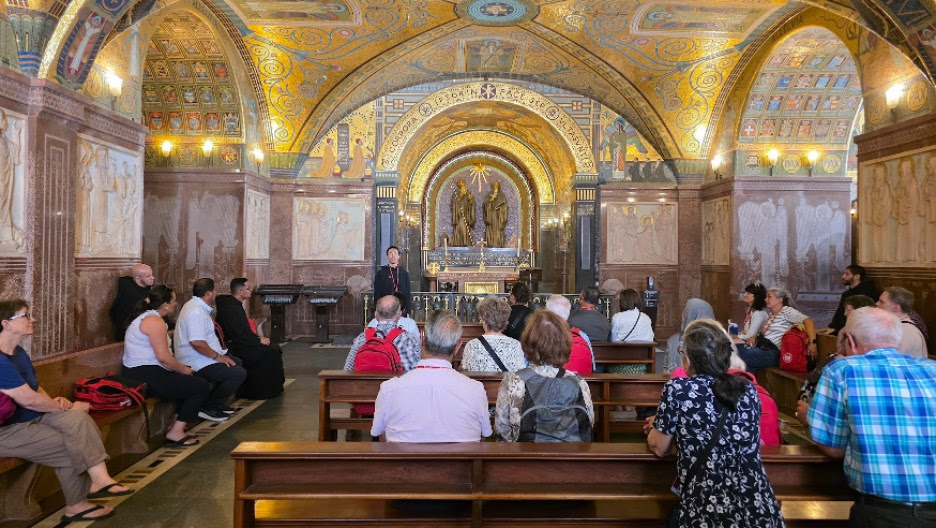
Crypt below the Abbey church designed in the Beuronese style.
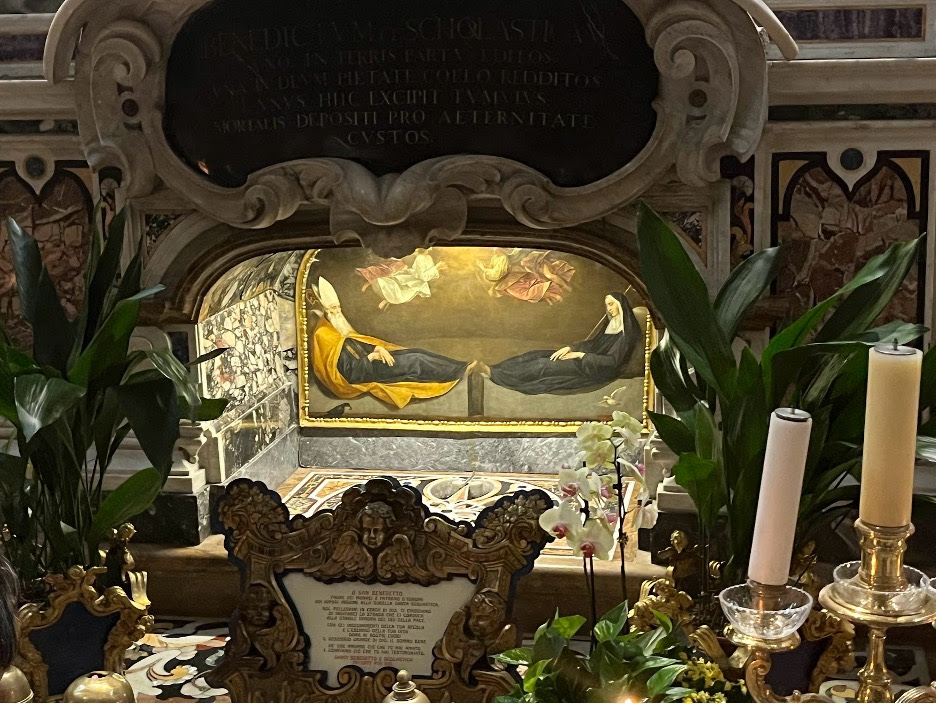
The final resting place of our beloved father St. Benedict and his sister St. Scholastica. This was appropriately the last place we renewed our oblation together and one of the pilgrims was enrolled into the novitiate.
Oblate Calendar
2025
August
27 – Oblate Day of Prayer
September
14 – Oblate Sunday: Br. Thomas. The Psalms, Part I.
19-21 – Oblate Retreat: Br. Thomas. From Head to Tail: Life and Death in the Book of Jonah.
29 – Solemnity of Archangels (plenary indulgence may be obtained by oblates).
October
November
7-9 – Oblate Retreat: Abbot Peter
9 – Oblate Sunday: Br. Thomas. The Psalms, Part II.
December
8 – Solemnity of the Immaculate Conception (plenary indulgence may be obtained by oblates)
14 – Oblate Sunday: Br. Thomas. The Psalms, Part III-
A Note to Our Dear Oblates - August 7, 2025
A Note to Our Dear Oblates
August 7, 2025Dear Oblates,
Oblate Pilgrimage – SubiacoThe next Benedictine site we visited on our pilgrimage was the holy cave (Sacro Speco) in Subiaco, where Saint Benedict fled to from Rome in order to live with God alone. It was here that he spent three years praying in solitude and grew in virtue. Even today, although surrounded by extraordinary architectural and artistic masterpieces built over the course of centuries, the cave conveys the authentic sense of the flight from the world of Saint Benedict. The interior of the church is an extensive complex of small cells, and chapels—including one over St. Benedict’s own hermitage, and others hewn from the living rock. There are extensive frescoes dating from the 13th to the 17th century. In his cave, where a little spring of water was welling up, the entire group renewed their oblation. It was a powerful spiritual experience, and the presence of Saint Benedict was clearly felt.
Prayer request. Please pray for the eternal rest of Deanna “Teresa of Avila” Huseth, who passed away in June. Please know that you can always send your prayer requests through our Oremus program.
Yours in Christ,Fr. John Paul, OSB
Director of Oblates
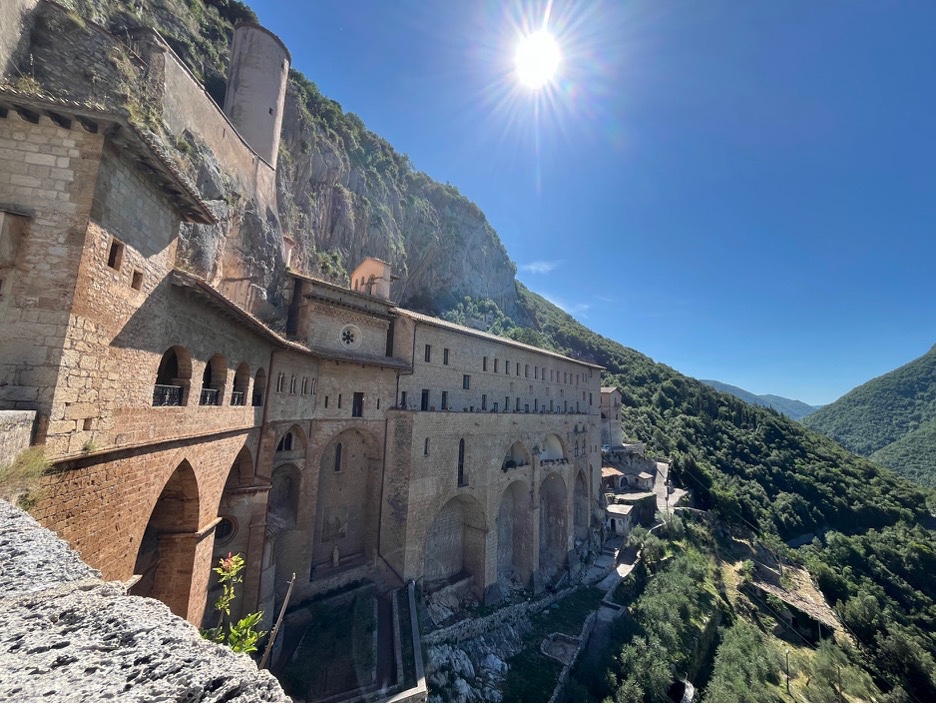
The church and monastery of Subiaco is literally built into the side of a mountain. All three of the Benedictine sites we visited sat at a high elevation, which made me think that St. Benedict must have been an avid hiker. The Camino of St. Benedict, beginning in Norcia and ending at Montecassino, is gaining in popularity. In fact, one of our oblates, Jeff and his son, are doing the very camino right now. Please pray for them.
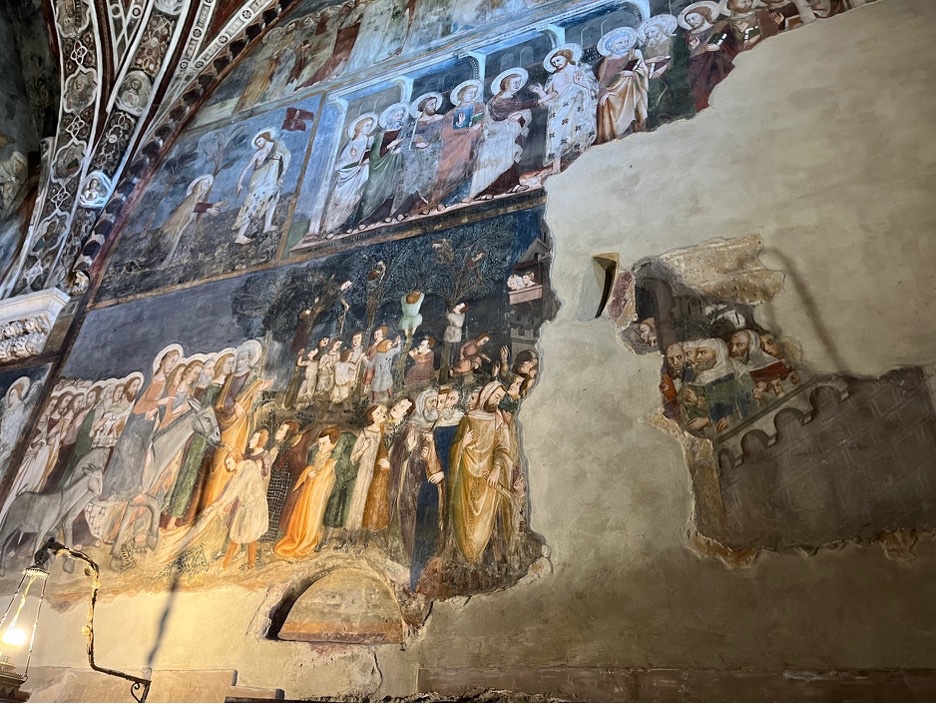
Aging fresco on church wall. Note how Christ and the children on the left are separated from the Pharisees on the right. Was it an intentional deterioration?
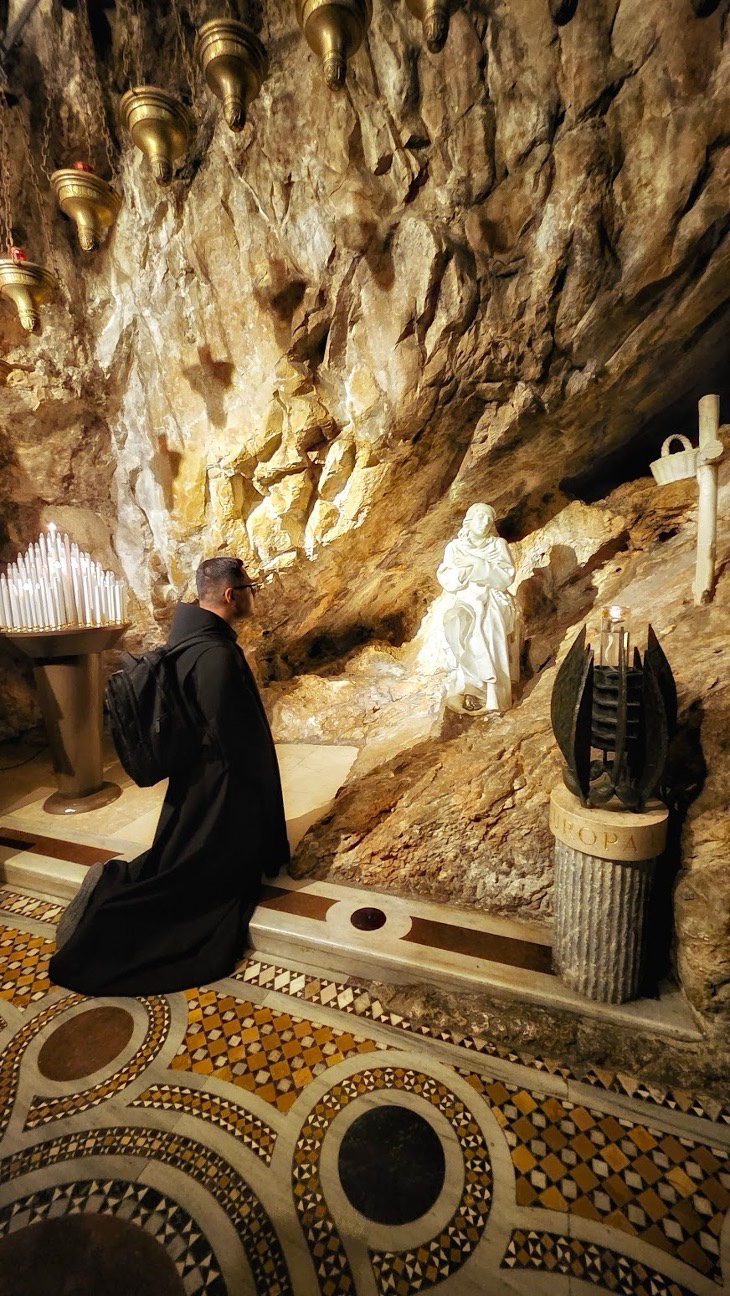
Fr. Ephrem prayerfully kneeling before the statue of St. Benedict in the holy cave. His right foot had to covered in metal because it was touched so many times.
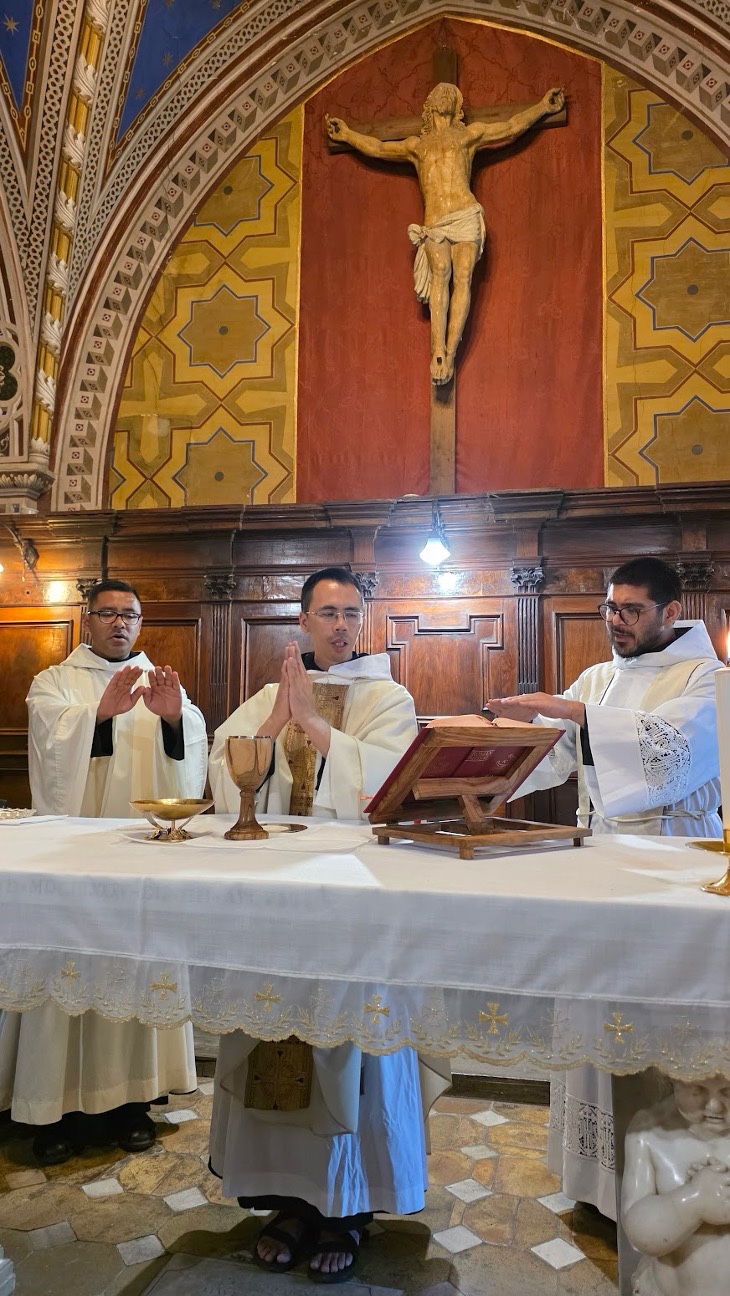
Saying Mass at the chapel right next to the holy cave.
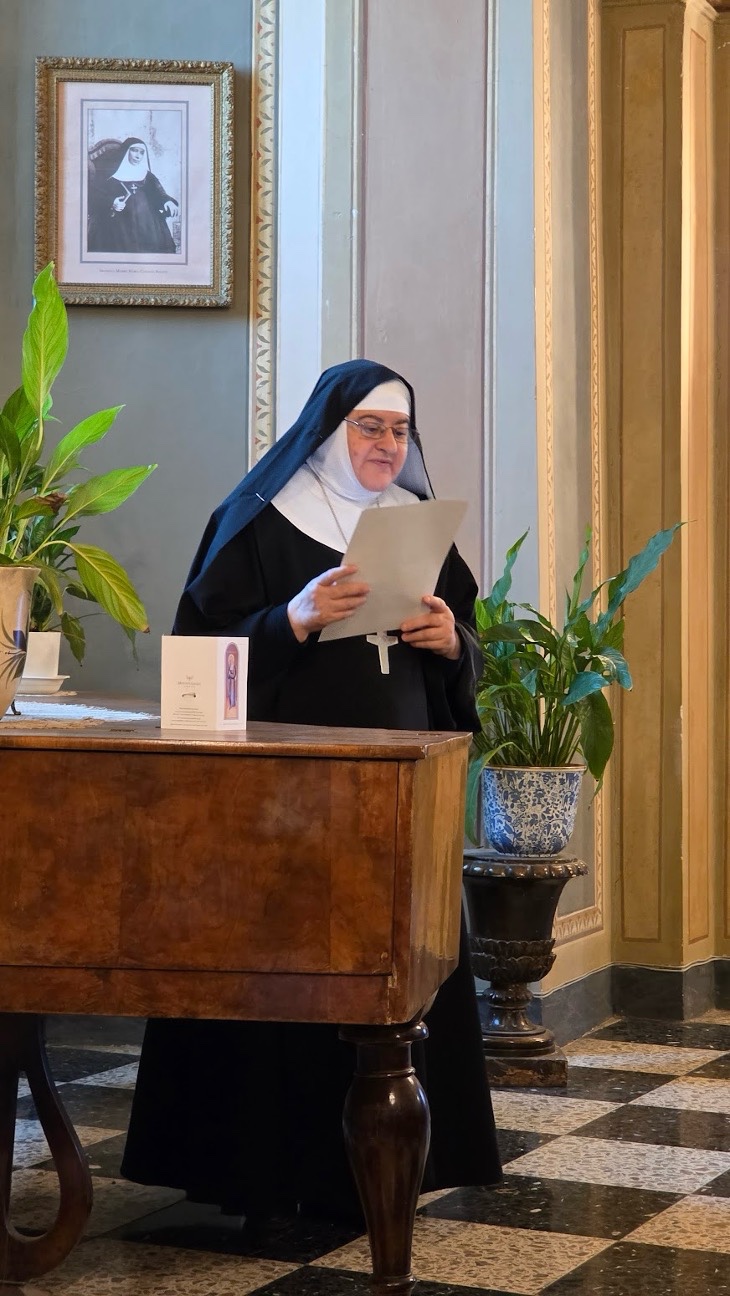
Afterwards, we went to the monastery of Santa Maria Dei Franconi. This is where Blessed Fortunata Viti lived. Mother Aloysia and the sisters welcomed us into their cloister and received us with all the warmth of charity. Mother Abbess did not speak English but had a translator translate her speech.
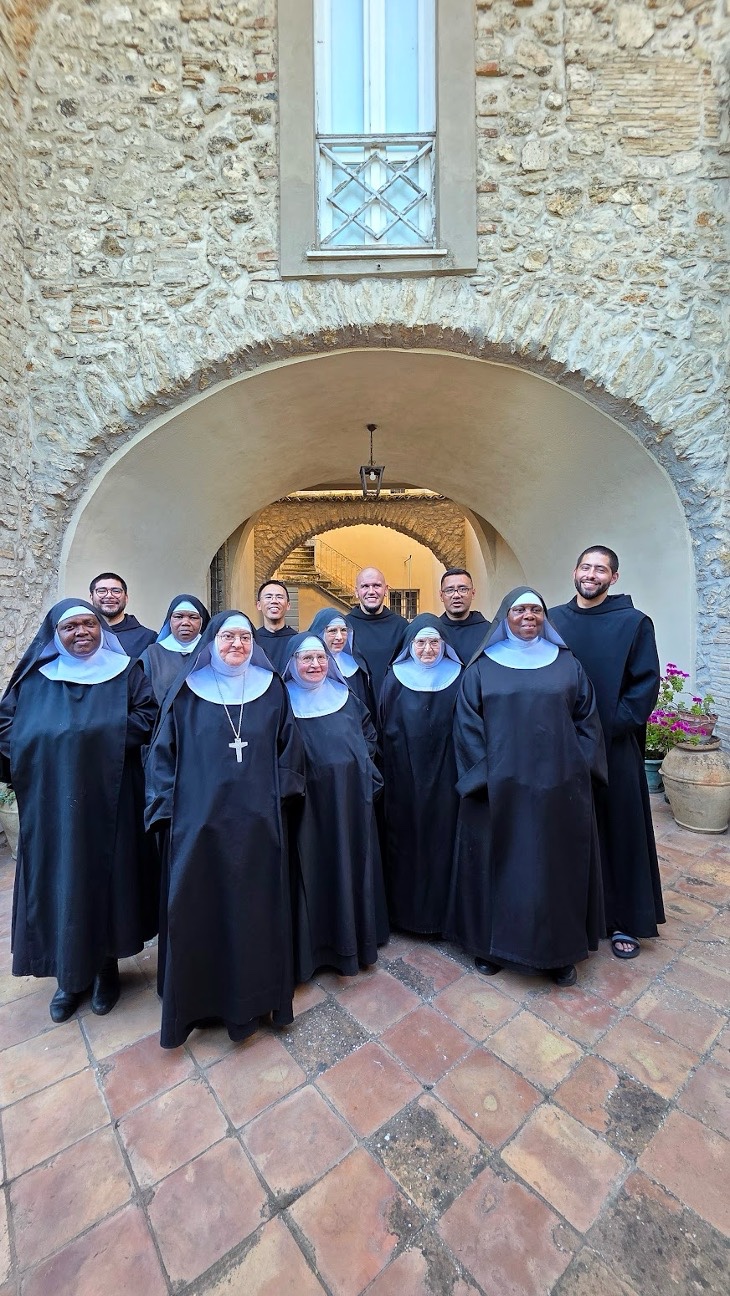
Picture of monks with the sisters. It is a small community with three sisters from Africa.
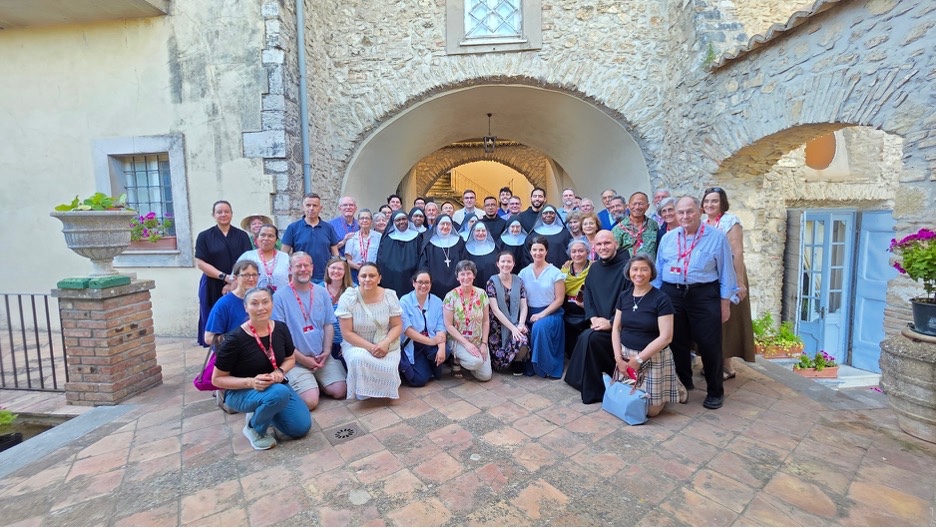
Group photo with the sisters. The mayor of Veroli is also in the picture (back middle, next to me).
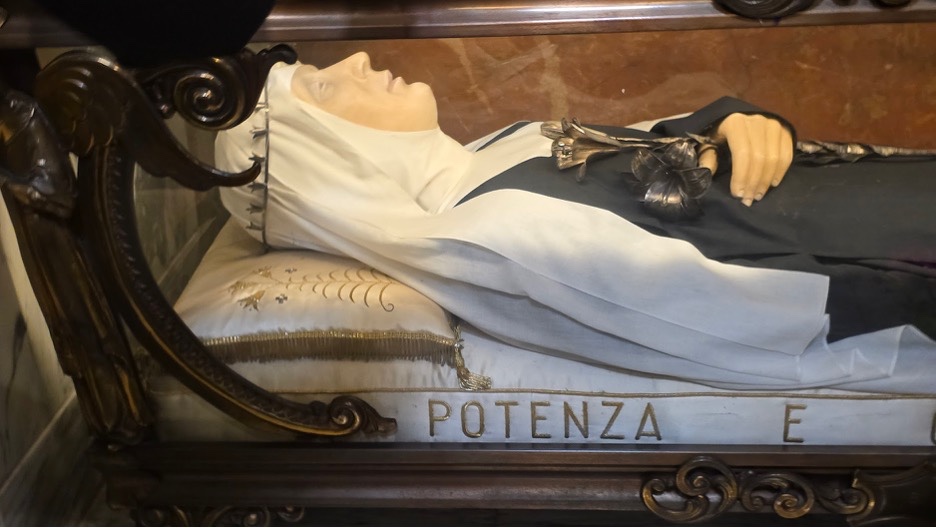
Tomb of Blessed Fortunata Viti in the chapel. We prayed with the sisters that she may one day become a saint and then sang the Salve Regina together.
Oblate Calendar
2025
August
27 – Oblate Day of Prayer
September
14 – Oblate Sunday: Br. Thomas. The Psalms, Part I.
19-21 – Oblate Retreat: Br. Thomas. From Head to Tail: Life and Death in the Book of Jonah.
29 – Solemnity of Archangels (plenary indulgence may be obtained by oblates).
October
November
7-9 – Oblate Retreat: Abbot Peter
9 – Oblate Sunday: Br. Thomas. The Psalms, Part II.
December
8 – Solemnity of the Immaculate Conception (plenary indulgence may be obtained by oblates)
14 – Oblate Sunday: Br. Thomas. The Psalms, Part III-
A Note to Our Dear Oblates - August 1, 2025
A Note to Our Dear Oblates
August 1, 2025Dear Oblates,
Oblate Pilgrimage – NorciaIn the 8th century a chapel was built in Norcia so pilgrims could pray at the site of St. Benedict’s birth. Monks came to Norcia in the 10th century, and remained in one form or another until 1810, when the Napoleonic Code forced the closure of the monastery. The current monastery was founded in 1998 by Fr. Cassian Folsom, an American monk of St. Meinrad Archabbey in Indiana. In 2016, Norcia was hit with a series of devastating earthquakes, the worst since the year 1900. This forced the community to relocate outside the city about 20 minutes away. A new monastery and chapel have been rebuilt, but they are still awaiting for the construction of a new church. In 2024, Fr. Benedict was elected as first Abbot of this newly reformed Benedictine community.
The monks and oblates made a long bus ride, 3.5 hours, to Norcia, but it was well worth the wait to be at Saint Benedict and Saint Scholastica’s birthplace. We first stopped at the main plaza where the original church was built over the saints’ birthplace; however, we were unable to enter the church because it was still being rebuilt. After this, we took the bus up to the newly formed monastery a couple of miles away. On arriving there, Fr. Cassian warmly greeted us and gave us a wonderful conference. Using the other books in the Dialogues of Saint Gregory, he offered a hypothetical upbringing of Saint Benedict and Scholastica and showed how they could have been formed by the monks living in the area. This conference was recorded and you can listen to it here. Afterwards, Fr. Cassian led us to the monastery church for None; this is the three o’clock hour of prayer. The monks of Norcia pray the traditional Benedictine office all in Latin singing Gregorian chant; it was lovely. After None, we were pleasantly surprised by the oblation ceremony that followed. Two of their oblate novices–they were actually the parents of the oblate director–made final oblation. Afterwards, Abbot Benedict greeted us, and we took the long bus ride home.
You can now read Br. Ambrose’s latest article entitled, “When Is Two and Two More than Four?” I am sad to announce that this is Br. Ambrose’s last article because he will be leaving the monastery later this month. Please keep him in prayer during this new stage of his life.
The Annual Oblate Day of Prayer will on August 27th, the feast of St. Monica, from 9am-4pm. To sign up, please click here.
Prayer request. Please pray for the seminarians who are here for the Intensive Spirituality Program. This is a three-week retreat in preparation for studying Theology. Please know that you can always send your prayer requests through our Oremus program.
Yours in Christ,Fr. John Paul, OSB
Director of Oblates

The first day of Rome was spent around St. Peter’s square. We had a general audience with the Pope, and several zealous oblates got up early (5am) to get front row seats. The monks were not so zealous.

In the afternoon we visited St. Peter’s Basilica. In the center is Bernini’s baldacchino with the chair of St. Peter in the background. It was jam packed with people, especially getting through the Holy Doors. Some of us, including myself, went for another visit during our free time. This photo was taken when there was hardly anyone in the church; Romans don’t like to wake up early.

The Pietà

On the morning we went to Norcia, we had the choice of celebrating Mass by the hotel or at St. Paul’s Outside the Walls. The choice was easy. Here we are celebrating Mass at the St. Benedict chapel. The major basilica is the residence of a Benedictine community. On the walls are images of all the Popes beginning with St. Peter; Pope Leo has yet to be placed alongside the others.

Here is a group picture at the main plaza in Norcia. Note the crane and construction in the background.

Praying None with the monks. There are about 20 monks in this community, and they are from 8 different countries.

Abbot Benedict presiding over oblation ceremony. It was interested to see that the novices held a candle in their hands during the rite, but they did not receive a Benedictine medal.

Mount Angel monks with Fr. Cassian. He says that he can recognize a Swiss-American hood from miles away.
Oblate Calendar
2025
August
27 – Oblate Day of Prayer
September
14 – Oblate Sunday: Br. Thomas. The Psalms, Part I.
19-21 – Oblate Retreat: Br. Thomas. From Head to Tail: Life and Death in the Book of Jonah.
29 – Solemnity of Archangels (plenary indulgence may be obtained by oblates).
October
November
7-9 – Oblate Retreat: Abbot Peter
9 – Oblate Sunday: Br. Thomas. The Psalms, Part II.
December
8 – Solemnity of the Immaculate Conception (plenary indulgence may be obtained by oblates)
14 – Oblate Sunday: Br. Thomas. The Psalms, Part III


